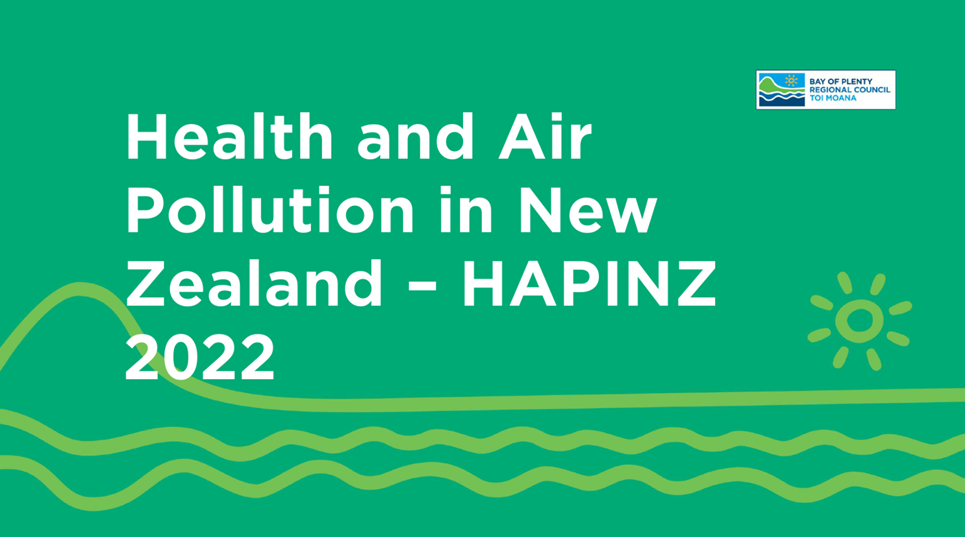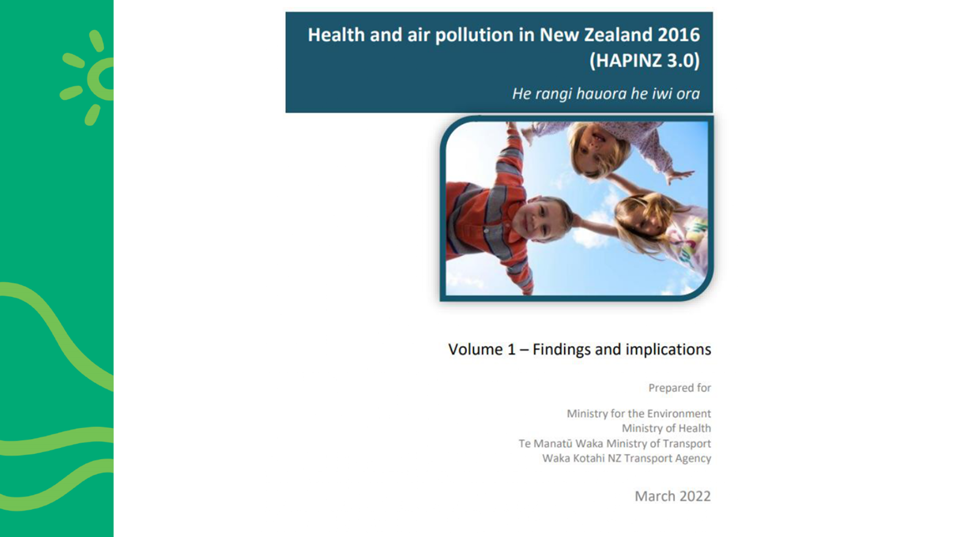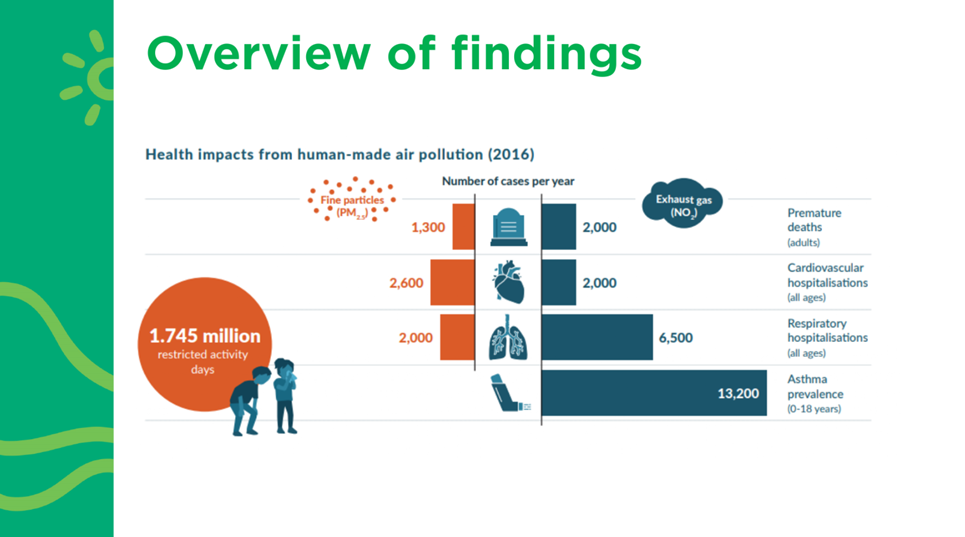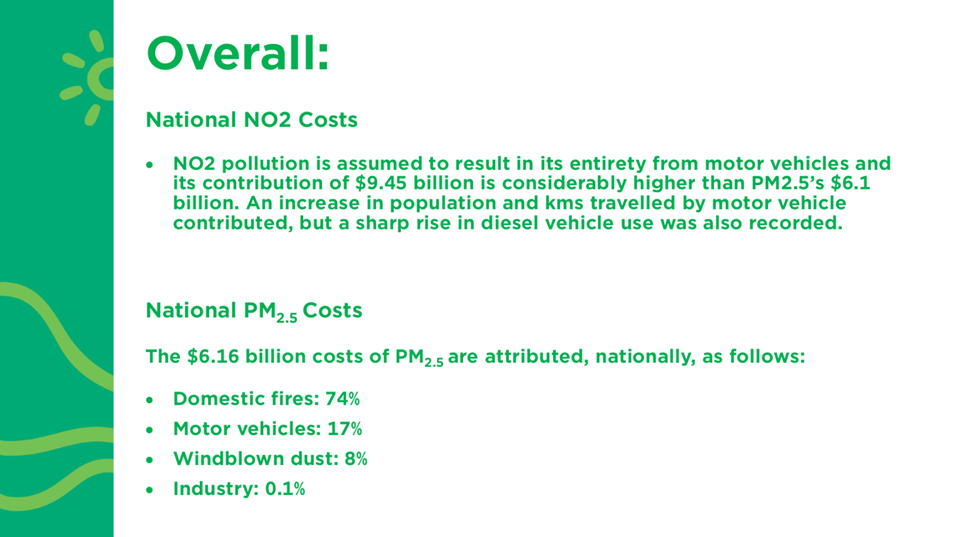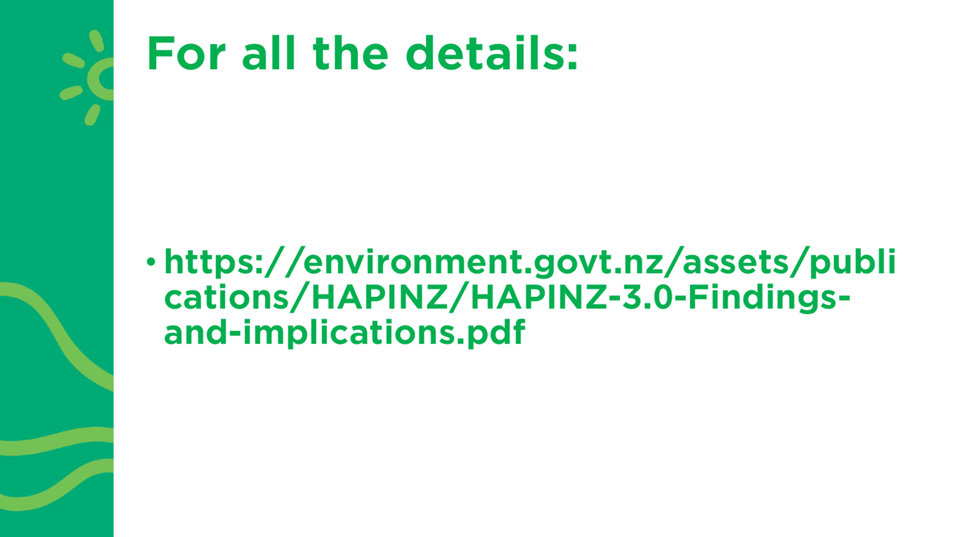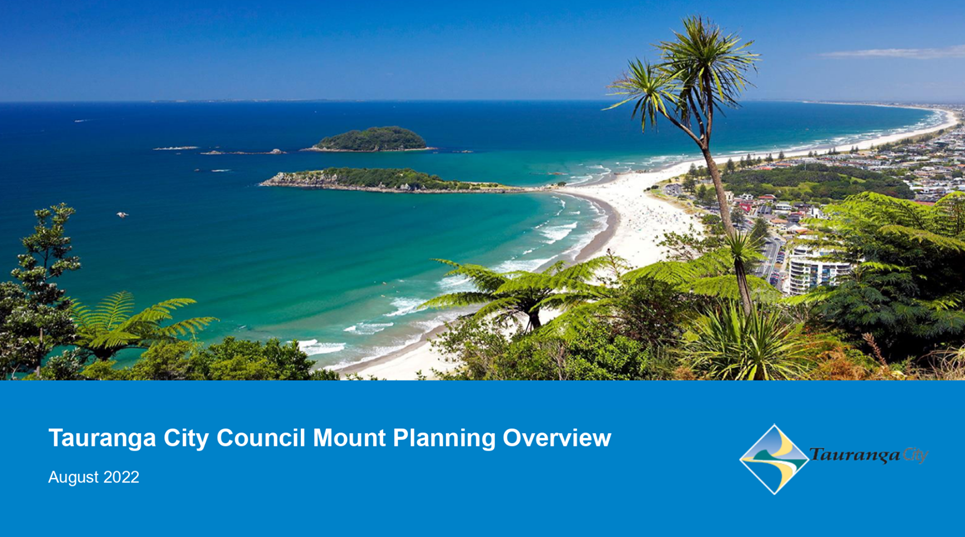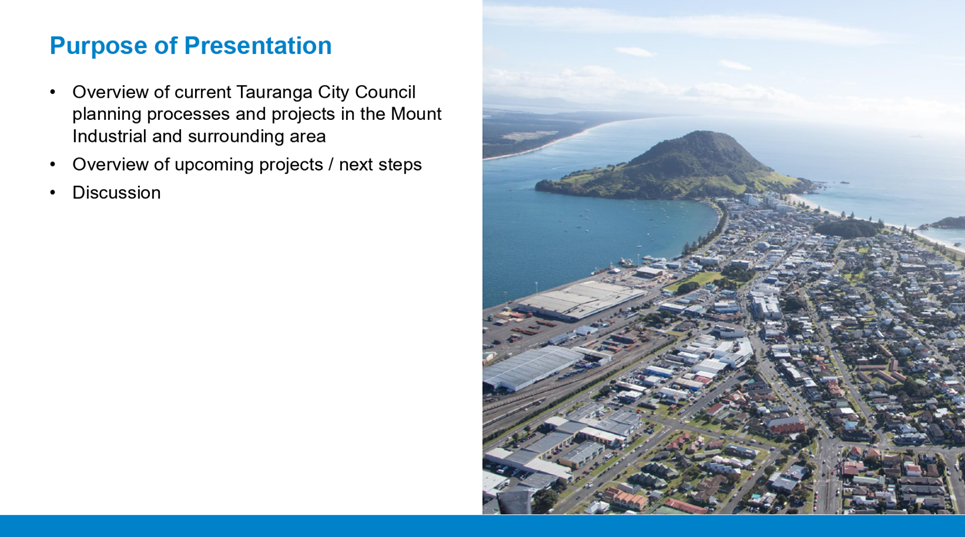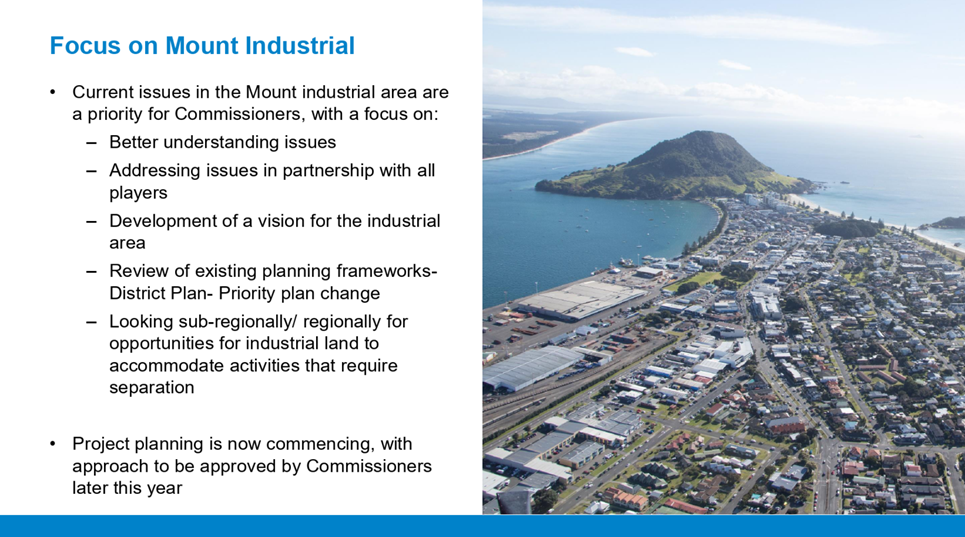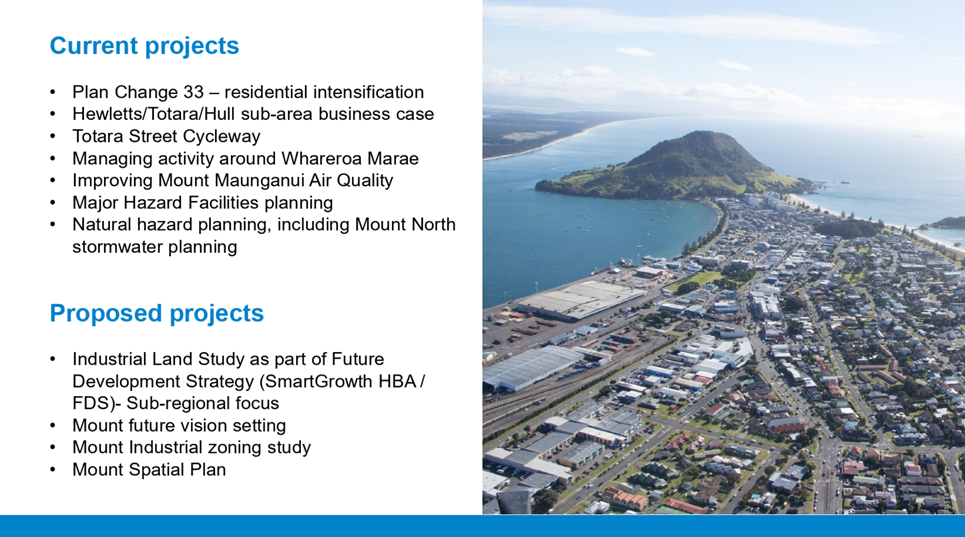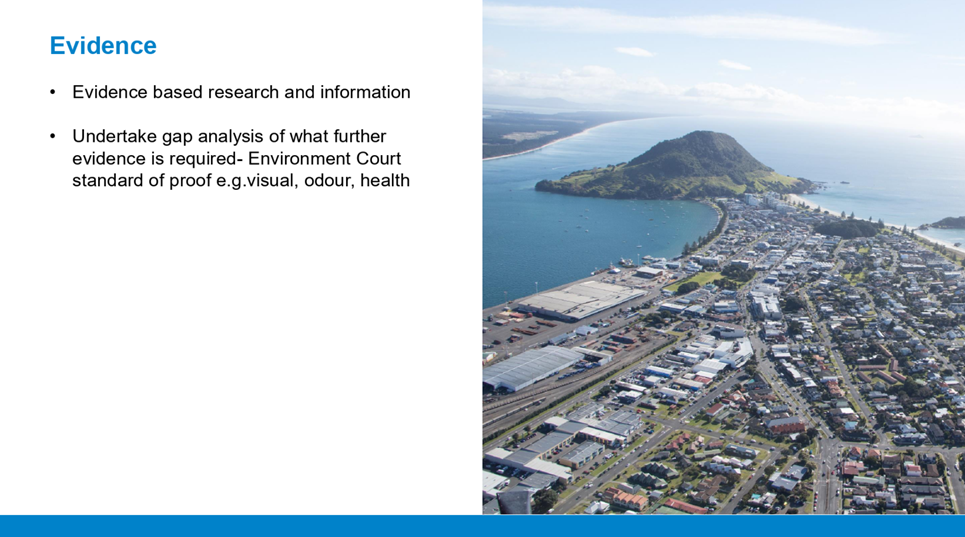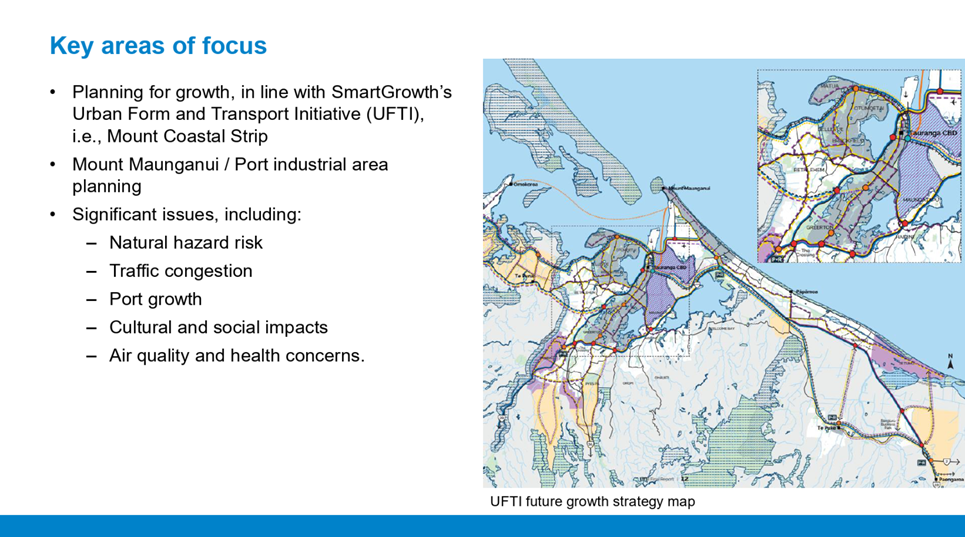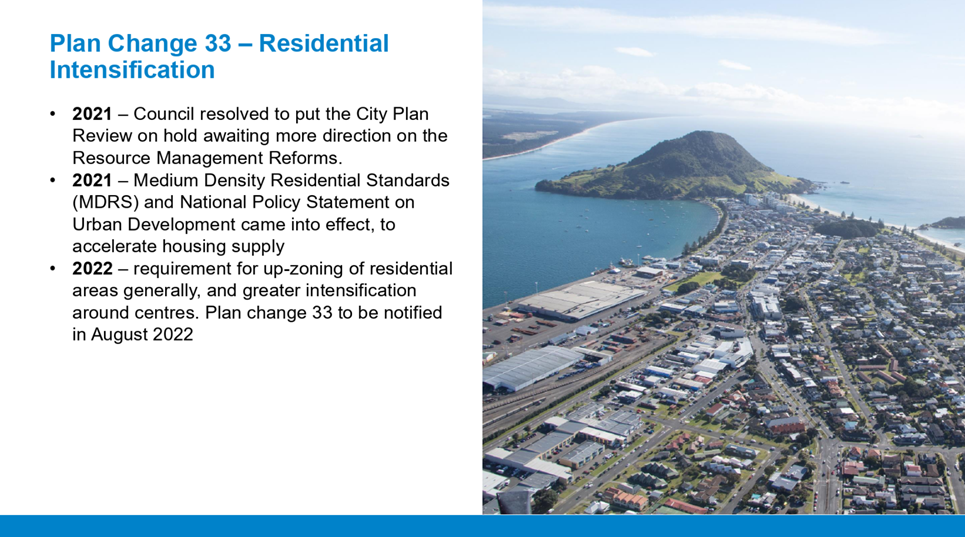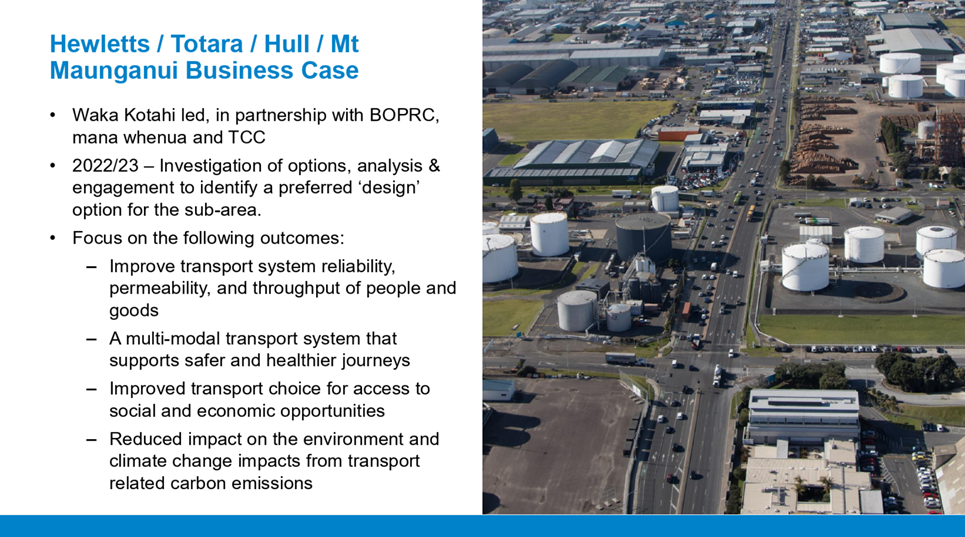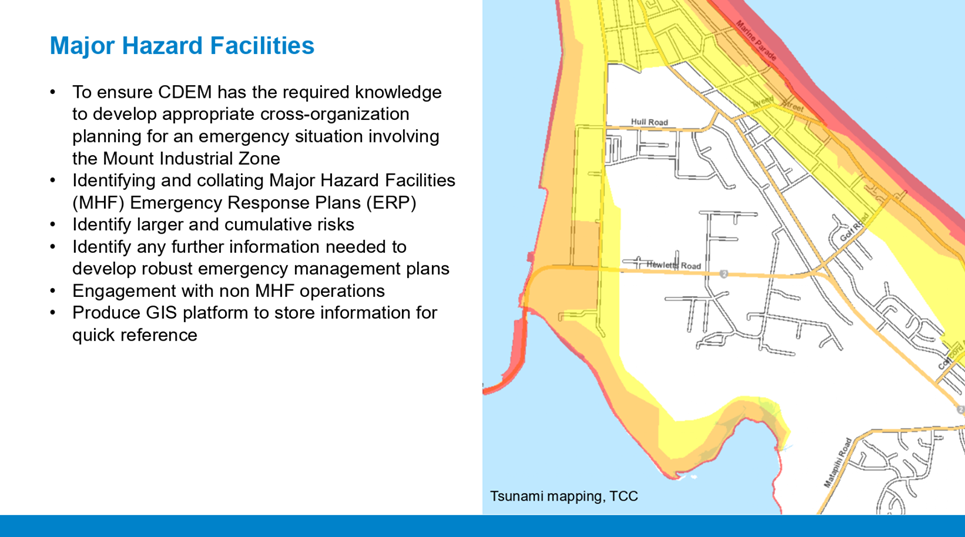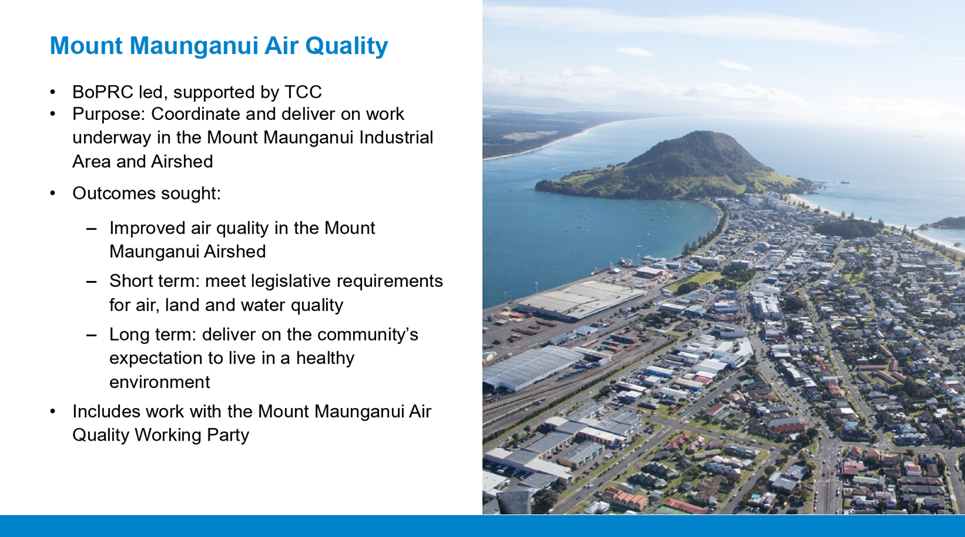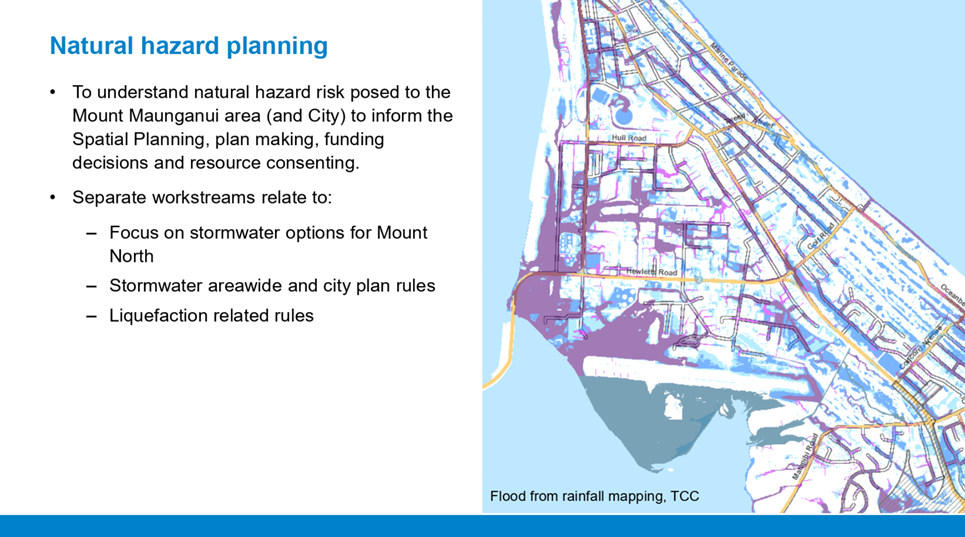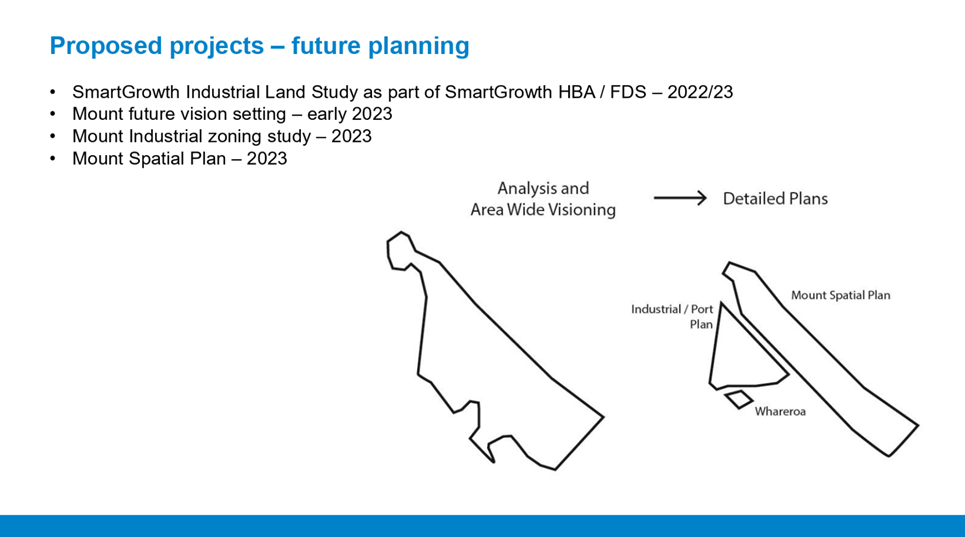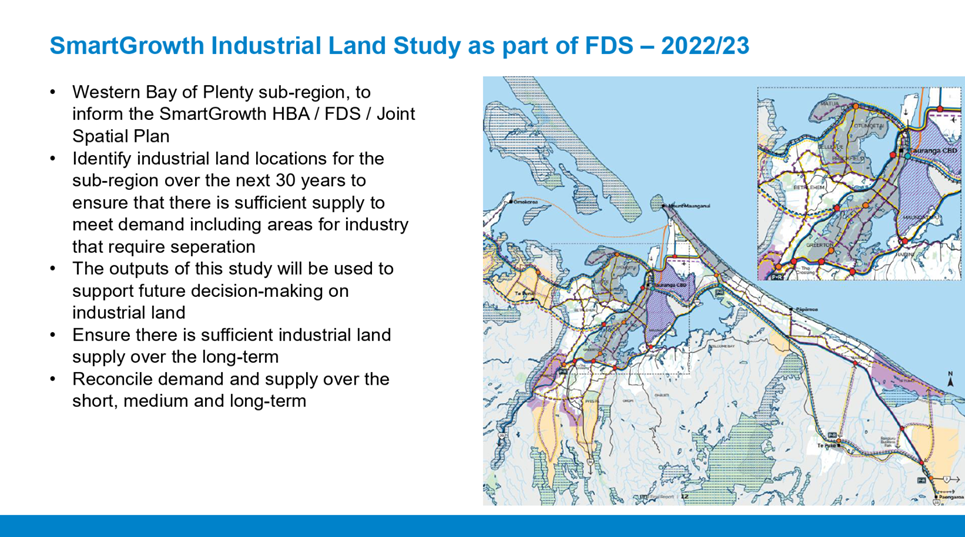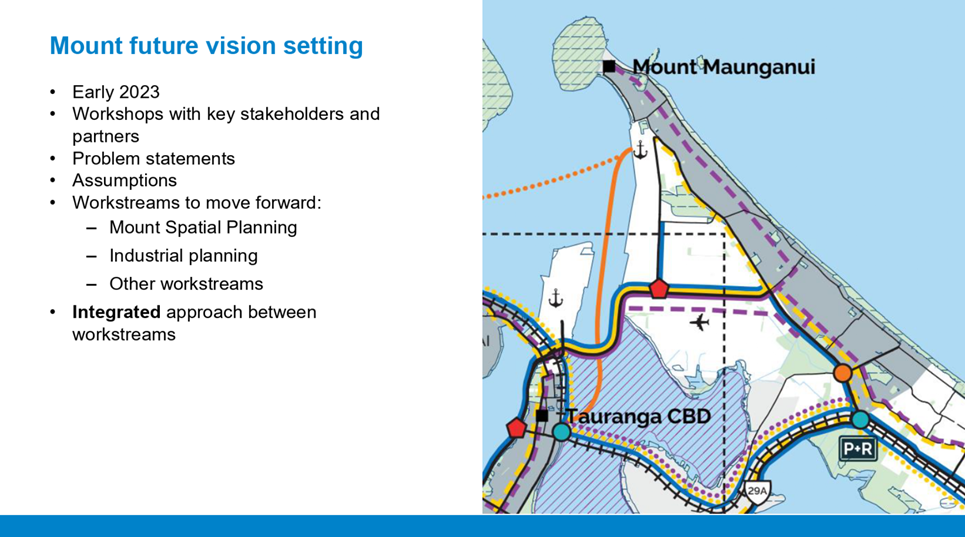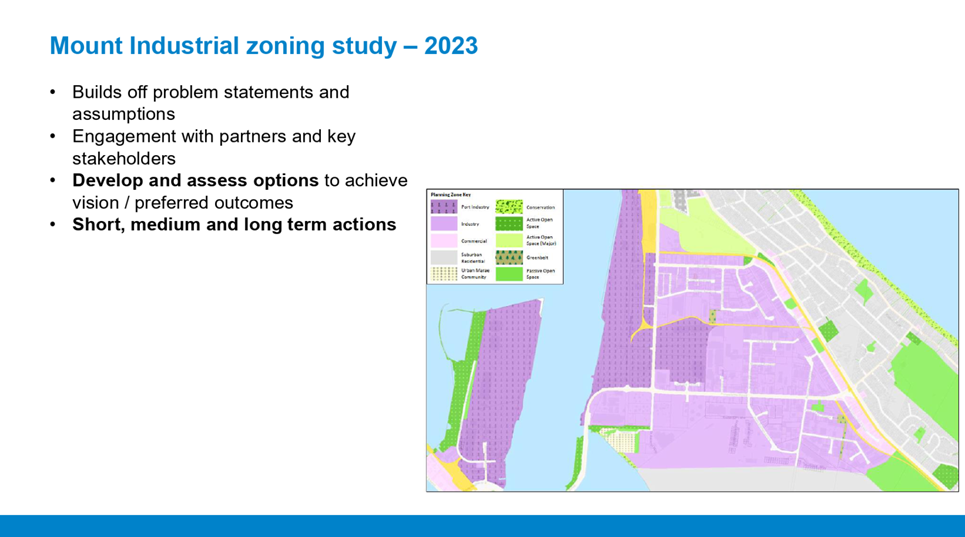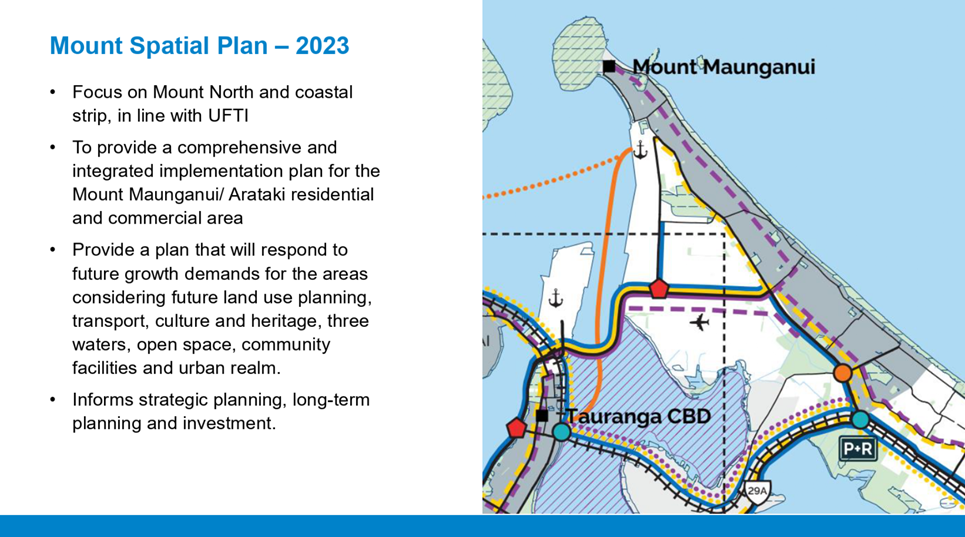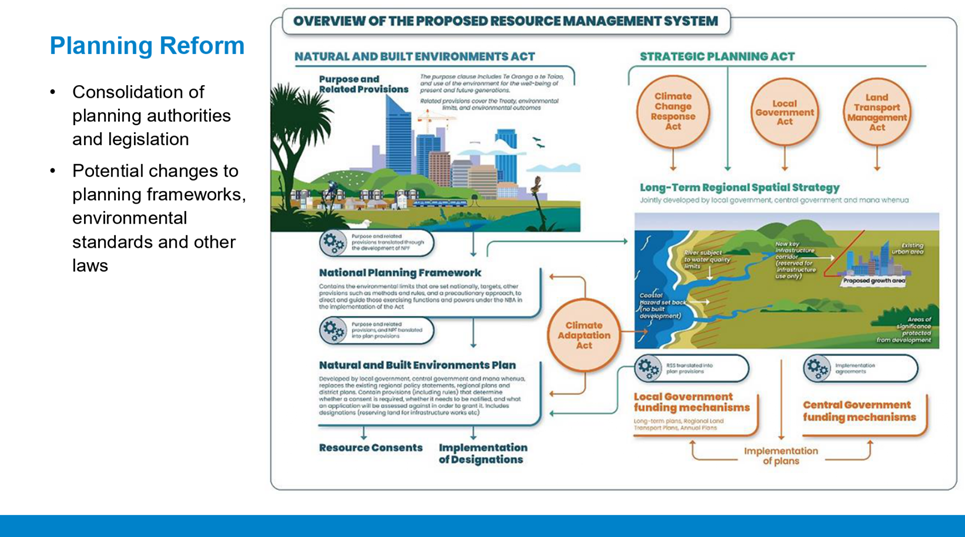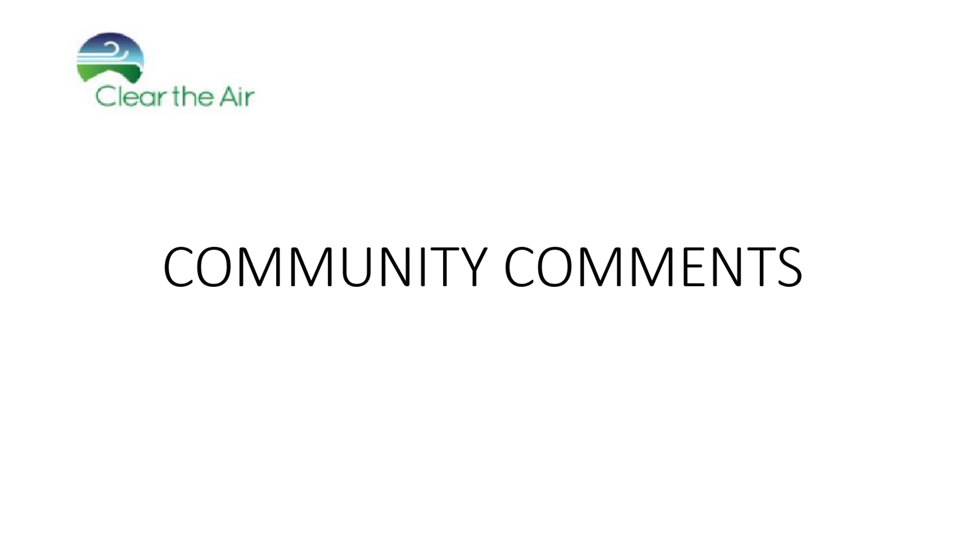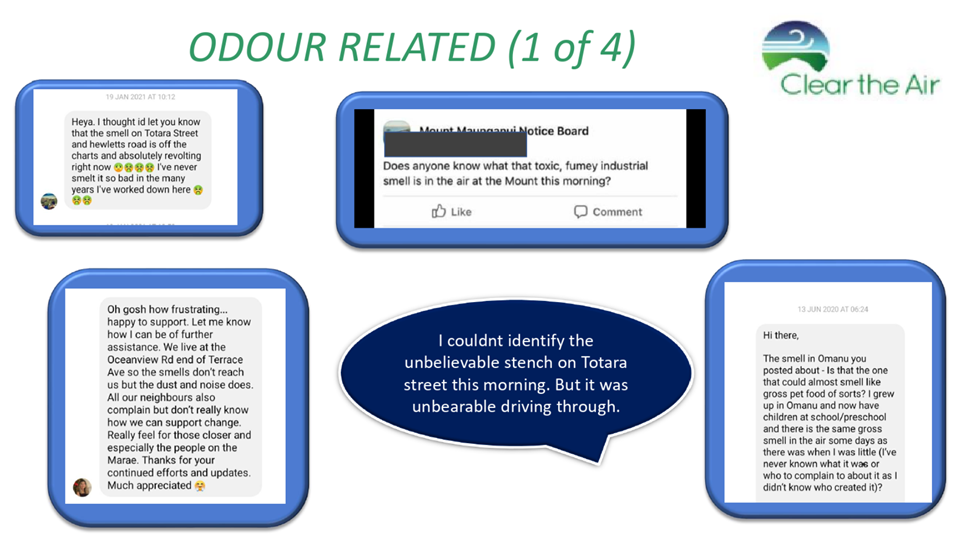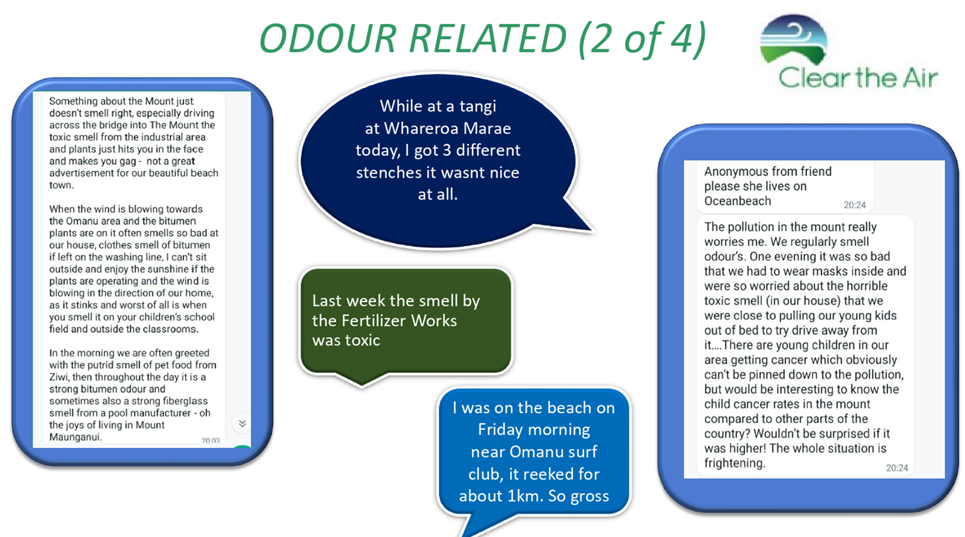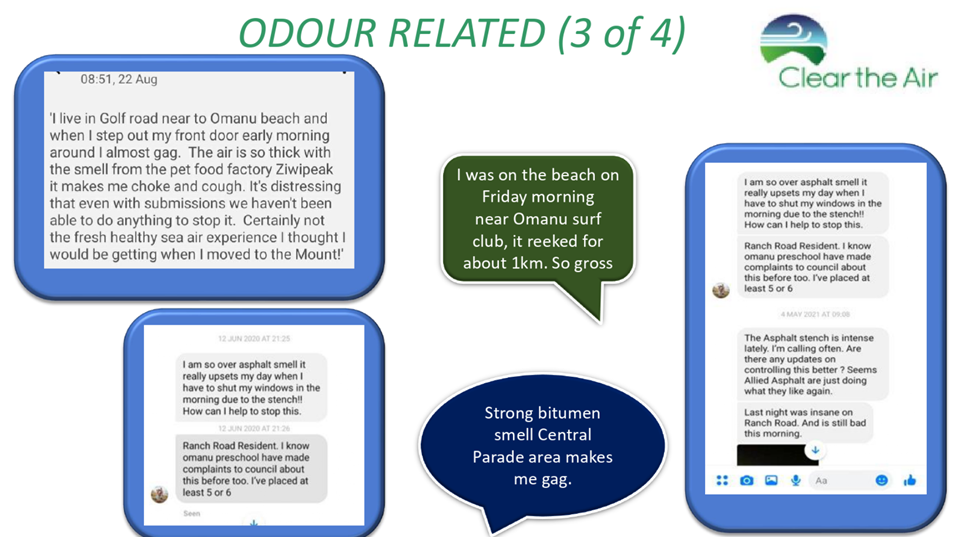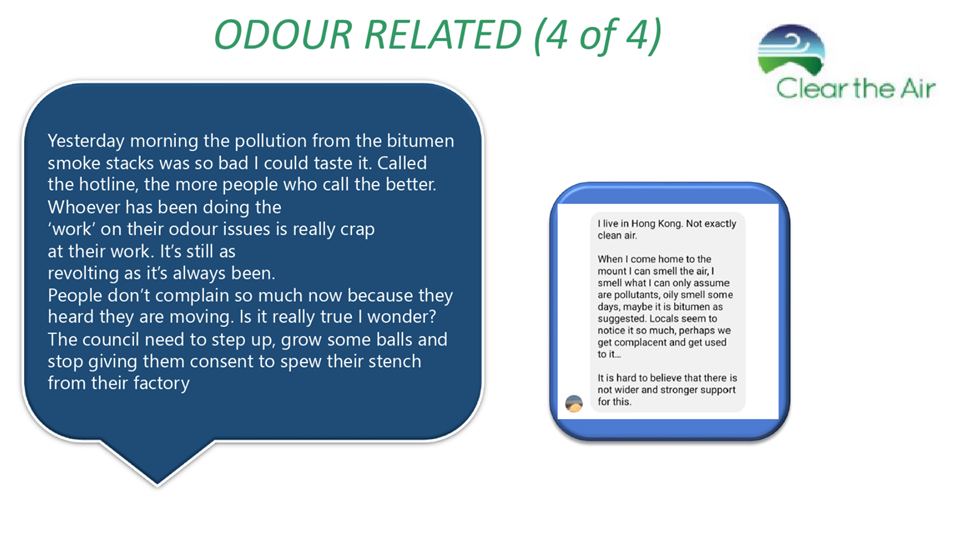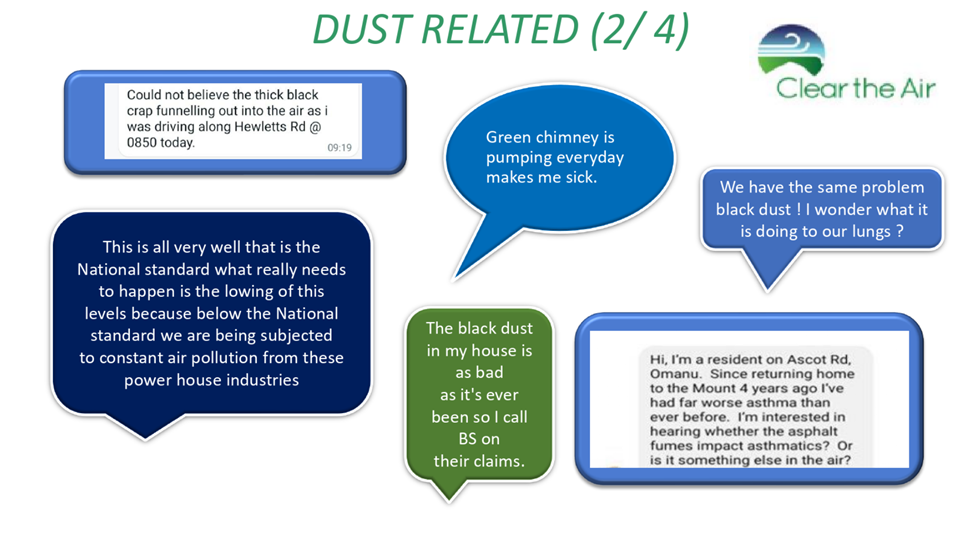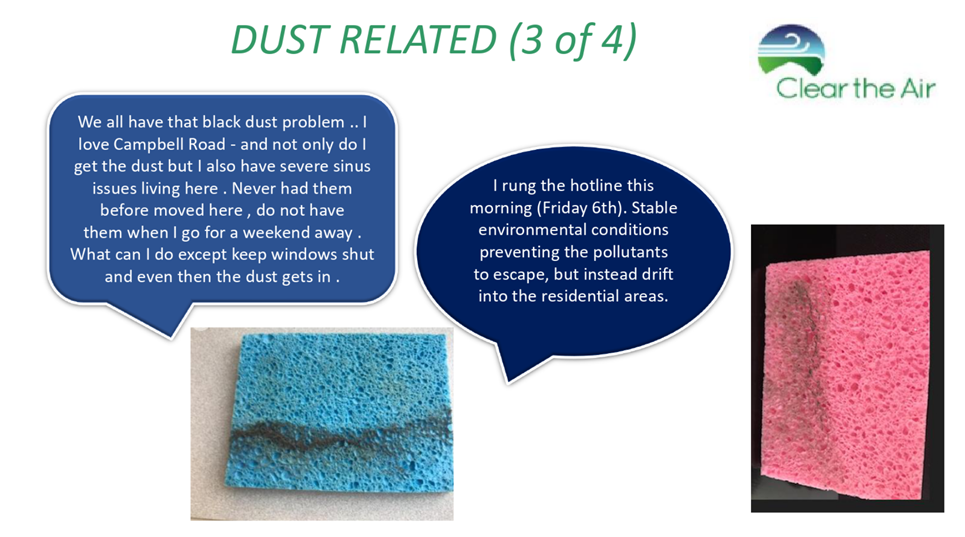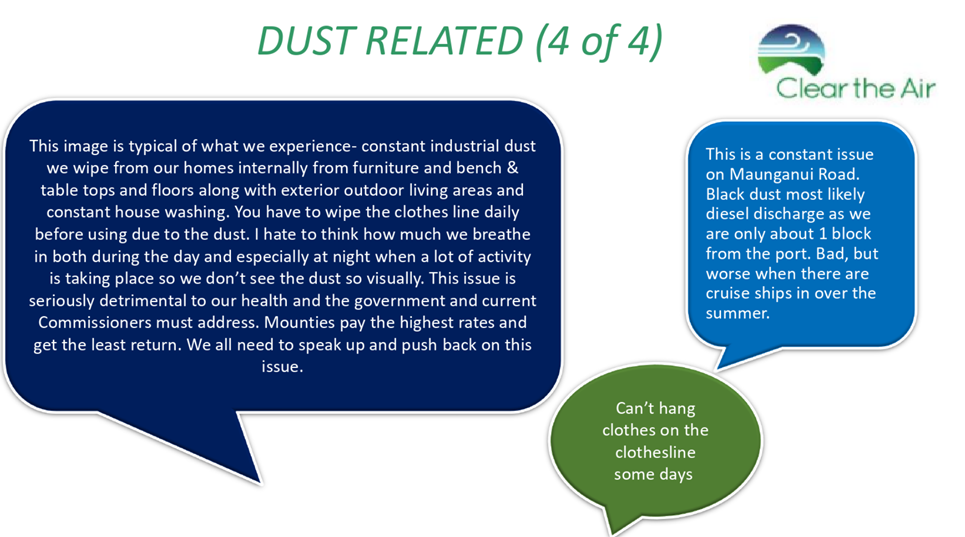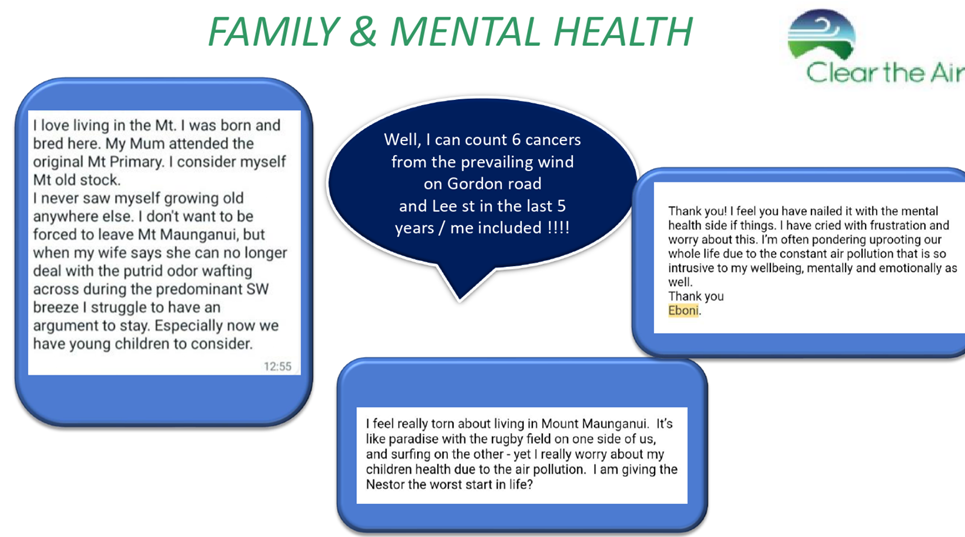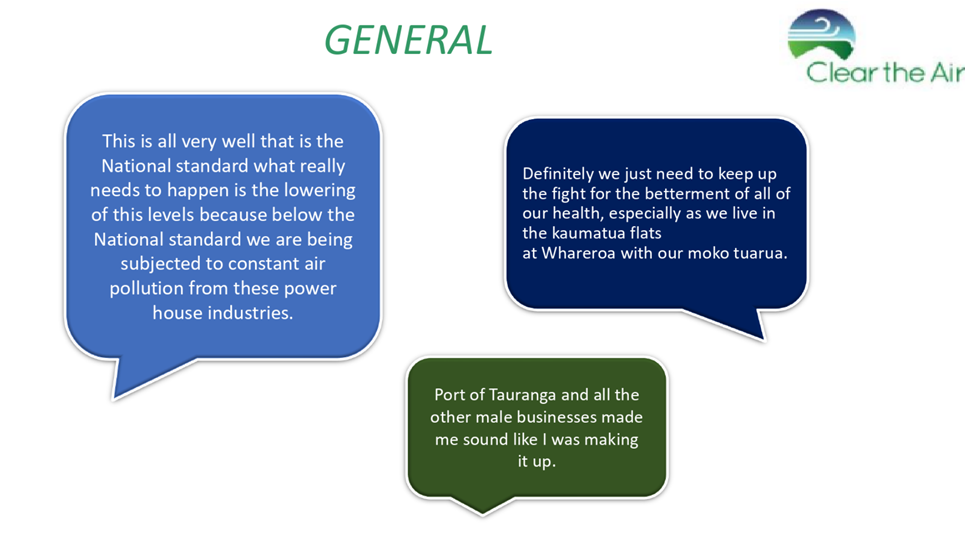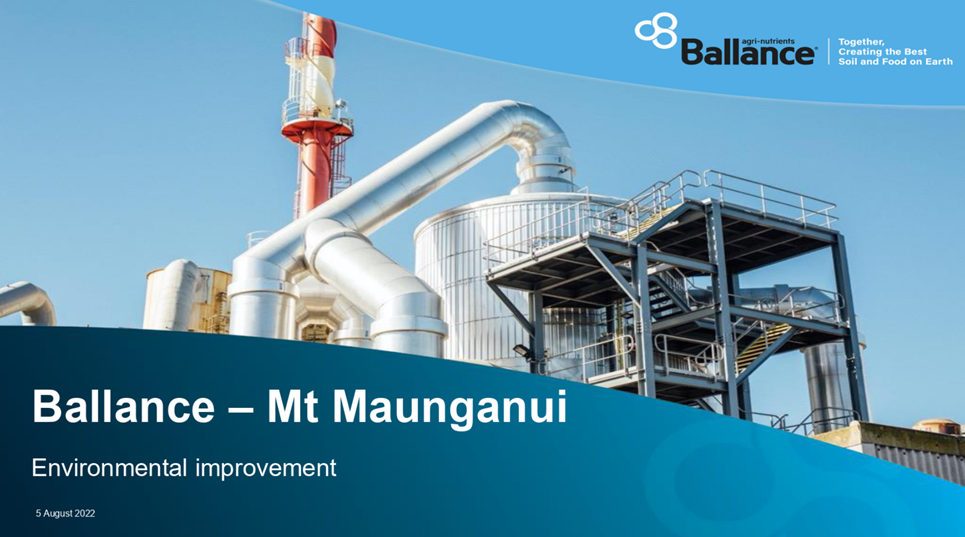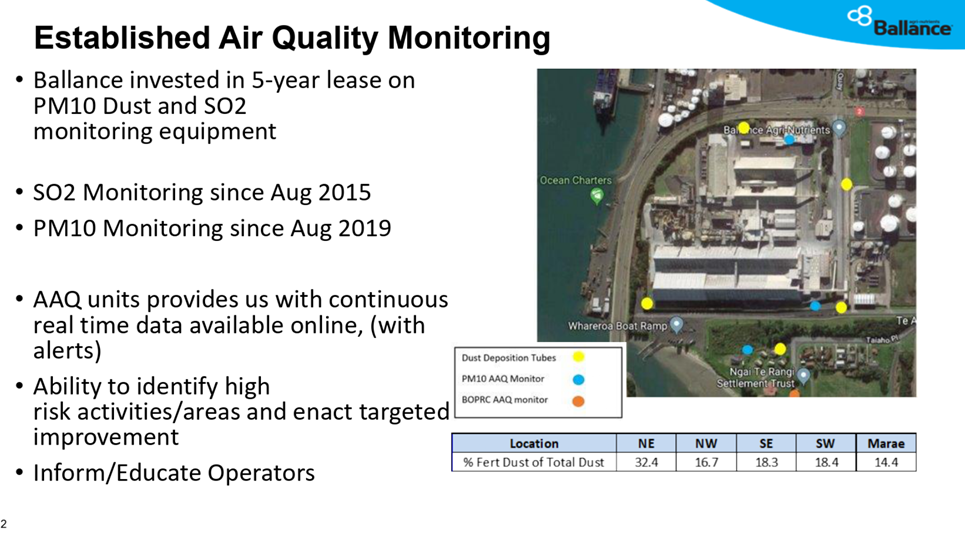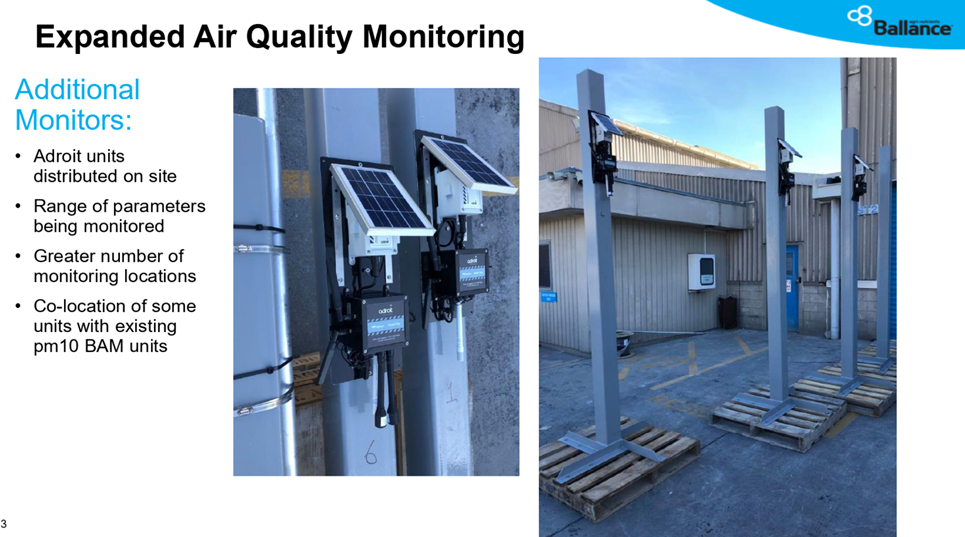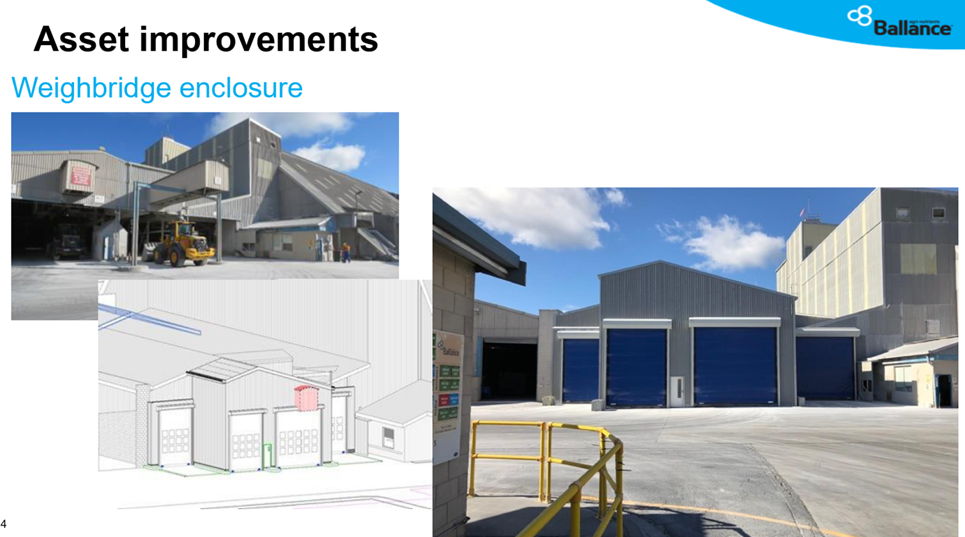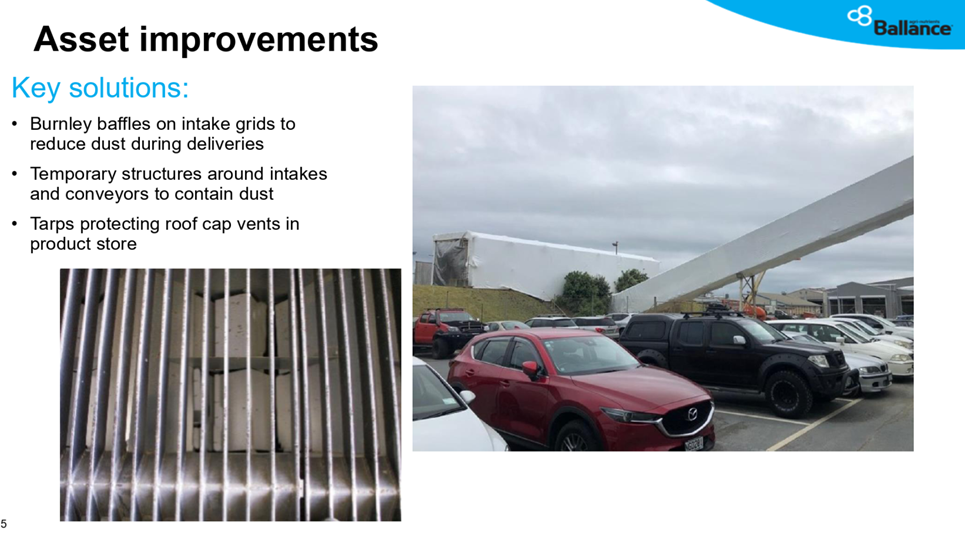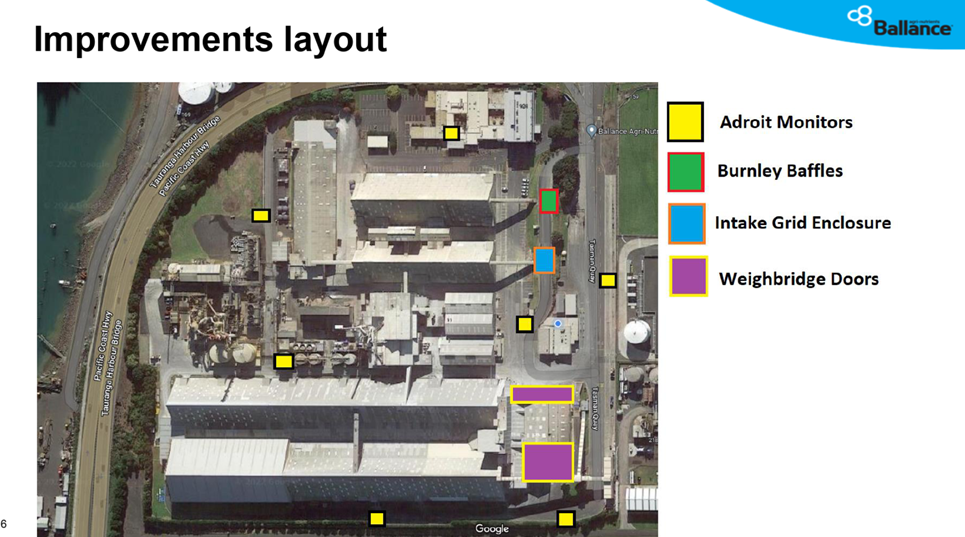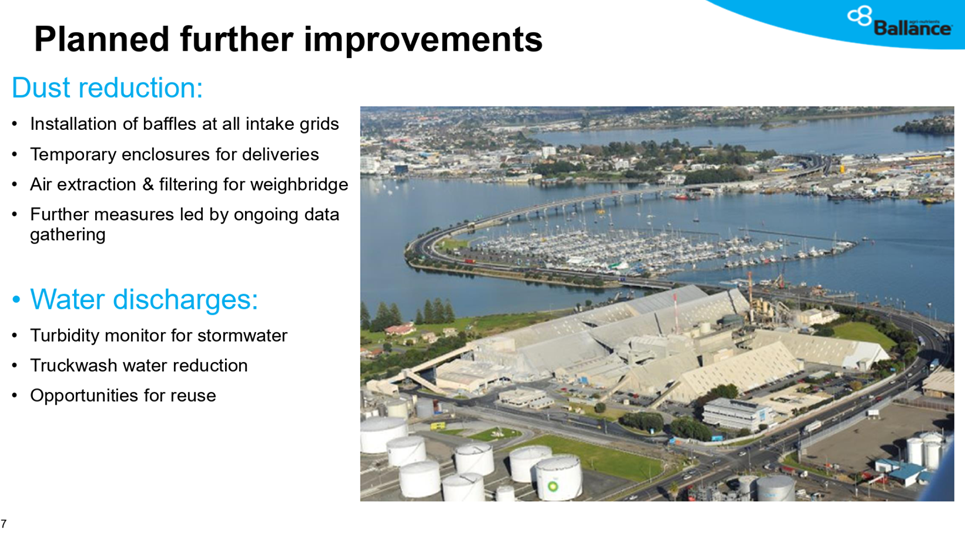|

|
|
Monitoring
and Operations Committee Agenda
NOTICE
IS GIVEN that the next meeting of the Monitoring and Operations Committee
will be held in Council Chambers, Regional House, 1 Elizabeth Street,
Tauranga and Via Zoom (Audio Visual Meeting) on:
Tuesday
6 September 2022 COMMENCING AT 9:30 am
This meeting will be
livestreamed and recorded.
The Public section of
this meeting will be livestreamed and recorded and uploaded to Bay of Plenty
Regional Council’s website. Further details on this can be found
after the Terms of Reference within the Agenda. Bay of Plenty Regional
Council - YouTube
|
|
Fiona McTavish
Chief Executive, Bay
of Plenty Regional Council Toi Moana
29 August 2022
|
|
Monitoring and
Operations Committee
|
Membership
|
Chairperson
|
Cr Kevin Winters
|
|
Deputy Chairperson
|
Cr Norm Bruning
|
|
Members
|
All Councillors
|
|
Quorum
|
Seven members,
consisting of half the number of members
|
|
Meeting frequency
|
Quarterly
|
Purpose
·
Oversee and monitor the implementation of policies and
strategies, promoting effective delivery and coordination between policy and
implementation through recommendations to the
Strategy and Policy Committee.
·
Monitor the implementation of
Council’s activities, projects and services.
Role
Oversee and monitor:
·
Regulatory performance of permitted activities, resource consents
and bylaw rules, including compliance and enforcement.
·
Delivery of biodiversity, catchment management and flood
protection activities in the region.
·
Delivery of biosecurity activities, including implementation and
monitoring of the Regional Pest Management Plan.
·
Effectiveness of navigation safety bylaw responses.
·
State of the Environment monitoring.
·
Implementation of specific programmes in place such as the Mount
Maunganui Industrial Air Programme, and integrated catchment programmes (e.g.
Rotorua Lakes and Tauranga Moana).
·
Receive information on environmental monitoring
and performance monitoring trends and recommend to the Strategy and Policy
Committee to inform policy review.
·
Monitor Council’s actions on Climate Change.
·
Operational activities that implement relevant national and
regional plans and strategies, including:
§
science
§ flood
protection
§ biosecurity
§ catchment
management
§ rivers
and drainage
§ compliance,
monitoring and enforcement
§ resource
consents
§
maritime
Power
to Act
To make all decisions necessary to fulfil the role and
scope of the committee subject to the limitations imposed.
The Monitoring and Operations
Committee is not delegated authority to:
·
Develop, adopt or review strategic
policy and strategy.
·
Approve Council submissions on
legislation, policy, regulations, standards, plans and other instruments
prepared by Central Government, Local Government and other organisations.
·
Identify, monitor and evaluate
necessary actions by the organisation and other relevant organisations under
co-governance arrangements.
Power
to Recommend
To the Strategy and Policy
Committee on matters necessary for reviewing plans, strategies and policies.
To Council and/or any standing committee as it deems
appropriate.
Recording
of Meetings
Please note the Public section of this
meeting is being recorded and streamed live on Bay of Plenty Regional
Council’s website in accordance with Council's Live Streaming and
Recording of Meetings Protocols which can be viewed on Council’s website.
The recording will be archived and made publicly available on Council's website
within two working days after the meeting on www.boprc.govt.nz for a period of
three years (or as otherwise agreed to by Council).
All care is taken to maintain your privacy;
however, as a visitor in the public gallery or as a participant at the meeting,
your presence may be recorded. By remaining in the public gallery, it is
understood your consent is given if your image is inadvertently broadcast.
Opinions expressed or statements made by
individual persons during a meeting are not the opinions or statements of the
Bay of Plenty Regional Council. Council accepts no liability for any opinions
or statements made during a meeting.
Bay of Plenty
Regional Council - Toi Moana
Governance Commitment
mō te taiao, mō ngā
tāngata - our environment and our people go hand-in-hand.
We provide excellent governance when,
individually and collectively, we:
· Trust and respect each
other
· Stay strategic and
focused
· Are courageous and
challenge the status quo in all we do
· Listen to our
stakeholders and value their input
· Listen to each other to
understand various perspectives
· Act as a team who can
challenge, change and add value
· Continually evaluate what
we do
TREAD LIGHTLY, THINK DEEPLY,
ACT WISELY, SPEAK KINDLY.
Monitoring
and Operations Committee 6 September 2022
Recommendations in reports are not to be construed as Council
policy until adopted by Council.
Agenda
1. Apologies
2. Public
Forum
3. Items
not on the Agenda
4. Order
of Business
5. Declaration
of Conflicts of Interest
6. Minutes
Minutes
to be Confirmed
6.1 Monitoring and Operations
Committee Minutes - 29 June 2022 1
7. Presentations
7.1 Western Bay of Plenty
District Council - Three Waters and Marae OSET Reticulation Progress Update
Presented by: Wayne Henderson, Three
Waters Project Engineer and Chris Nepia, Kaiwhakahaere Kaupapa
Māori/Strategic Kaupapa Māori Manager
7.2 Tauranga Moana
Biosecurity Capital
Presented by: Graeme Marshall and
Carlton Bidois, Co-Chairs, Tauranga Moana Biosecurity Capital
8. Reports
8.1 Chairperson's Report 1
Decisions Required
8.2 Regional Pest Management
Plan Annual report for 2021/22 and Operational Plan for 2022/23 1
Attachment 1 - RPMP Operational
Plan 2022-2023 DRAFT 1
Attachment 2 - Operational Plan
Annual Report 2021-22 FINAL DRAFT 1
Information Only
8.3 Mount Maunganui
Industrial Area update 1
Attachment 1 - Spreadsheet of all
PM10 exceedances to August 2022 1
Attachment 2 - Mount Air Quality
Working Party 23 August 2022 meeting minutes 1
Attachment 3 - Minutes of the Mount
Industrial Network meeting 1
8.4 Resource Consents Annual
Report 1
8.5 Climate Change Annual
Report 1
Attachment 1 - Climate Change
Programme Annual Report Dashboard January 2021 - June 2022 1
8.6 Environmental Volunteering
supported by Council 1
Attachment 1 - Land Estuary and
Catchment Care Groups supported by Council 2021-22 1
8.7 Customer Service
Performance 1
8.8 Environmental Code of
Practice for Rivers & Drainage Maintenance Activities - 2022 Annual Review 1
Attachment 1 - Hapu/Iwi Resource
Management Plans 1
Attachment 2 - Rivers and Drainage
Operations Complaint Register 1
Attachment 3 - Rivers and Drainage
Operations Completed Works 1
8.9 Implementation of the
Flood Protection and Drainage Bylaws 2020 1
Attachment 1 - Bylaws Applicable
Areas 1
8.10 River Scheme Sustainability - Update
report 1
9. Consideration
of Items not on the Agenda
|
Monitoring and Operations
Committee Minutes
|
29 June 2022
|
Monitoring and Operations Committee
Open Minutes
Commencing: Wednesday 29 June 2022, 9:30 am
Venue: Council Chambers, Regional House, 1 Elizabeth Street, Tauranga and
Via Zoom (Audio Visual Meeting)
Chairperson: Cr Kevin Winters
Deputy Chairperson: Cr Norm Bruning
Members: Cr Bill Clark
Cr
Stuart Crosby
Cr Toi
Kai Rākau Iti
Cr
David Love
Cr Matemoana
McDonald
Cr Jane
Nees
Cr
Stacey Rose
Cr
Paula Thompson
Cr
Lyall Thurston
Cr
Andrew von Dadelszen
Cr Te
Taru White
In Attendance: Sarah Omundsen – Acting Chief Executive, Chris Ingle - General
Manager Integrated Catchments, Reuben Fraser – Acting General Manager
Regulatory Services, Pim de Monchy - Coastal Catchments Manager, Kirsty Brown
– Rivers and Drainage Assets Manager, Reece Irving - Senior Regulatory
Project Officer, Sam Weiss - Acting Compliance Manager – Air, Industry
& Response, Greg Corbett – Biosecurity Manager, Davor Bejakovich
– Wallaby Programme Lead, Glenn Ellery – Data Services Manager,
Alex Miller – Compliance Manager – Land & Water; Via Zoom:
Rob Donald – Science Manager, Helen Creagh – Rotorua Catchments
Manager
Apologies: Chairman Doug Leeder
Declaration of Public Recording
The Chair advised that the public section
of the meeting was being recorded and would be made available on the Bay of
Plenty Regional Council website and archived for a period of three years.
Recording of the Meeting: Monitoring and Operations
Committee Meeting 29 June 2022 - YouTube
1. Apologies
|
Resolved
That the Monitoring and Operations Committee:
1 Accepts
the apology from Chairman Doug Leeder for absence tendered at the meeting.
Bruning/Iti
CARRIED
|
2. Deputations
|
2.1
|
Western Bay of Plenty
District Council - Progress Update on Three Waters and Marae OSET
Reticulation
|
|
|
The Chair advised that due to illness the presenters were
unable to present this item, therefore the item would be withdrawn from the
agenda and deferred to the next meeting of the Committee on 6 September 2022.
|
3. Items not on the Agenda
The Chair advised
that a Verbal Update on the Climate Change Programme had been requested
and would be provided under Agenda item 10.
4. Declaration of Conflicts
of Interest
None declared.
5. Minutes
Minutes to
be Confirmed
6. Presentations
|
6.1
|
Coastal Catchments and
Regional Parks Operations Update
Presentation - Coastal Catchments Operations
2021/22: Objective ID A4130988
Presented by: Pim de Monchy, Coastal
Catchments Manager
|
|
|
Key
Points:
· The Coastal
Catchments programme had an operating budget $5.5M and capital budget of $2M
to deliver work across biodiversity, water quality, co-governance, coastal
and community groups/volunteers and the Regional Parks Activity.
· Provided an
overview of project highlights and a dashboard snapshot of work distribution
across the region.
· The Ministry for
the Environment’s Public Waterways Ecosystem Restoration (PWER)/Jobs
for Nature Fund had provided $3M over three years for water quality,
biodiversity and economic stimulus. Work to date was 70 percent complete with
the remainder of the programme anticipated to be completed by the end of
December 2022.
9:45 am – Cr
McDonald entered the meeting.
· Acknowledged
volunteers, care groups and contractors that had contributed to the
environmental outcomes achieved across the region.
In Response to Questions:
· Dashboard
reporting information was used internally to provide Long Term Plan reporting
on key performance indicators.
· Clarified the
process undertaken to update covenant instruments. Further detail could be
provided on request.
· E. coli data
trends in the Waiōtahe estuary were accessible on the Water Ecology Tool
(WET) on Regional Council’s website. E. coli levels were still above
Ministry of Health guidelines and further work was needed to consistently
reduce E. coli concentrations in the estuary. Essentially, more retirement of
land was needed to substantially reduce contaminant inflows on a regular
basis, and new freshwater limits and incentives/agreements with landowners
would play an important role.
Key Points - Members:
· Sought consideration for discussion to be held with Quayside
Holdings regarding the opportunity to connect and create further open
space with the Rangiuru Business Park’s wetland development that was in
the early stages of design.
· Congratulated the
results, dedication and joined up approach achieved by staff, coast care
volunteers and landowners who were assisting to deliver positive
environmental improvements and outcomes.
Items for Staff Follow Up:
· Consider
forecasted changes over the next 10 years for discussion in the new
triennium.
|
7. Reports
|
7.1
|
Chairperson's Report
10:06 am
– Cr Love withdrew from the meeting.
Key Points:
· The Chair outlined
key matters from the report.
· Rob Donald,
Manager Strategy & Science provided an explanation of the
Te Teko groundwater bores, including related costs due to bore depths and
overruns due to the Covid-19 pandemic. A demonstration was provided that
showed the distribution of groundwater monitoring sites/bores across the
region along with rainfall levels/parameters using live data that was
accessible on the Environmental Data Portal on Bay of Plenty Regional
Council’s (Regional Council) website.
10:14 am
– Cr Love entered the meeting.
In Response to Questions:
· Regional Council
had an open data policy and worked closely with NIWA, GNS Science and all
other Crown Research Institutes.
· Regional councils
from across the sector were working on the best model and one approach for
managing Synthetic Nitrogen Fertiliser.
· The Regional
Search & Rescue (RSRF) funding that was provided to the Rotorua mountain
bike club supported their role as first responders in assisting emergency
services in remote trail locations.
· Environmental
Enhancement Fund reserve funding criteria was spread across the region.
· Regarding
community concerns about the Te Puna Business Park, Consent Team Leader Nick
Barnes was providing community liaison support as part of the resource
consent process and staff would be working collaboratively with the Western
Bay of Plenty District Council.
· An application
from Transpower for consent renewal of anchor blocks in the Tauranga harbour
was being processed. The anchor blocks were defined as ‘accommodated
infrastructure’ and would not be subject to a right of veto by
customary marine title holders. However, it was noted that a hearing had been
scheduled at the end of the year to decide whether Rangataua Bay should be
given wāhi tapu status, which may have implications on consent processes
and what could be granted. Transpower were engaging with iwi/hapū.
Current understanding was that if consent could not be granted, Transpower
may carry out further works on the pā site at the end of Maungatapu,
which they and iwi/hapū wished to avoid. Current focus was to facilitate
a process and agreement between all parties about what should happen.
Key Points - Members:
· Expressed concern
regarding pollution hotline calls and odour complaints in Judea and to take
stronger compliance.
Key Points – Staff:
· Acknowledged the
patience of the Judea community and their openness to provide information to
staff to make further progress on odour issues. Staff would keep councillors
updated on this matter. The Phone App and odour inventory was being undertaken
in the Mount Maunganui industrial area and regular updates would be provided.
Items for Staff Follow-Up:
· Provide advice on
Rotorua Lakes Council’s contribution to RSRF funding.
· Include regular
reporting updates on the pollution hotline odour issues within the Judea
industrial area.
· Keep councillors
informed of the Te Puna business park resource consent process and community
liaison.
|
|
|
Resolved
That the Monitoring and Operations Committee:
1 Receives
the report, Chairperson's Report.
Crosby/Bruning
CARRIED
|
Decisions
Required
|
7.2
|
Building Future
Sustainability and Resilience through Asset Management
Presentation - Building future sustainability
and resilience through asset management: Objective ID A4130994
Presented by: Kirsty Brown, Rivers and
Drainage Assets Manager
Key Points:
· Council took a
whole-of-life approach in the management of its infrastructure assets, in
line with national and international best practice.
· Noted the
opportunity to incorporate additional sustainability and resilience
performance objectives/targets into the asset management framework at the
next Long Term Plan/Asset Management Plan review.
· Asset Management
Plans enabled the setting of sustainability and resilience properties, levels
of service and targets to support future measurement and reporting.
· Linking objectives
with the internal Sustainability Strategy (to be developed) would support a
consistent approach across the organisation.
In Response to Questions:
· Sustainability
specifications and components were considered as part of the procurement
process checklist.
· Regional Council
was not ISO 55000 certified, but used the standards and the International
Infrastructure Management Manual as the guiding documents for Council’s
asset management practices and processes.
Items for Staff Follow Up:
· Report back to the
September 2022 Monitoring and Operations Committee meeting on:
o River Scheme Sustainability Project
progress.
o Implementation of the Flood
Protection and Drainage Bylaws 2020, including co-designing of a Iwi
Management Plan for Kōkōhinau urupa.
|
|
|
Resolved
That the Monitoring and Operations Committee:
1 Receives
the report, Building Future Sustainability and Resilience through Asset
Management.
2 Approves
the proposed approach to further implement sustainability and resilience into
our asset management practice.
Love/von Dadelszen
CARRIED
|
11:00 am – the
meeting adjourned.
11:18 am – the
meeting reconvened.
Information
Only
|
7.3
|
Mount Maunganui Industrial
Area update
Presented by: Reece Irving, Senior Regulatory Project
Officer and Sam Weiss, Acting Compliance Manager – Air, Industry &
Response
In
Response to Questions:
· The monitor trial
undertaken in the residential area to the east of the Mount Maunganui
industrial area was carried out over three months and had been completed. It
was confirmed that the monitors could not be used for compliance, but
provided a better picture where there was a wider geographical area of
interest.
· Reductions in PM10
exceedances during the reporting period were not necessarily reflected in the
greater wellbeing experienced at Whareroa Marae, as other factors also contributed
to this. Staff continued to work towards addressing issues
to improve the quality of life for the Whareroa Marae community.
· An improvement in
the way that odour and other issues affecting Whareroa Marae were managed may
require a change to legislation or rules and a bigger discussion on how they
are supported.
11:27 am –
Cr White exited the meeting.
· Methyl bromide
fumigation reductions were a reflection of the fumigator’s ability to
meet the recapture rate required by the buffer distance, and as set by the Environmental Protection Authority. Regional Council was
actively working on processing the resource consents lodged by the fumigator.
11:30 am –
Cr Thurston exited the meeting.
Key Points - Members:
· Improvements in
the quality of life for Whareroa residents had not been satisfied and
considered further actions and considerations were required.
· Port of Tauranga’s use of methyl bromide was a consideration
for its Board of Directors, noting there were other alternatives that were
being used.
· Acknowledged that
the regulatory function of Regional Council was kept separate to avoid any
perceived conflict of interest, through the use of independent consultants
and commissioners where relevant.
Items for Staff Follow Up:
· Requested that the
respective health providers who were represented on the Mount Maunganui Air
Quality Working Party provide an update to the Working Party on the timeframe
for when a report on the health impacts and quality of life at Whareroa Marae
would be forthcoming.
· Requested a more
detailed update from Tauranga City Council at the next Monitoring and
Operations Committee meeting on the work they are doing in the Mount
Maunganui industrial area.
|
|
|
Resolved
That the Monitoring and
Operations Committee:
1 Receives
the report, Mount Maunganui Industrial Area update.
Love/Bruning
CARRIED
|
|
|
|
|
7.4
|
Rotorua Catchments Activity
Updates
Presented by: Helen Creagh, Rotorua
Catchments Manager
In Response to Questions:
· No response had
yet been received from the Ministry for the Environment in relation to the
Minister’s decision regarding recommendations of the Rotorua Te Arawa
Lakes Strategy (RTALSG) 20 April 2022 meeting, however officials were
actively working on briefings to the Minister.
· Demand for the
Lake Rotorua Incentives Scheme was ongoing with about 35 tonnes achieved,
another five tonnes in the pipeline and small agreements consistently being
received. It was noted that the Minister had agreed to extend the scheme out
to 2027.
· The pending review
of the RTALSG work programme and terms of reference arose from the Lakes
Water Quality Society Annual General Meeting (AGM) where it was resolved to
request RTALSG undertake an independent review. From this, Te Arawa Lakes
Trust undertook to lead the scoping of an independent review, which would be
brought back to the RTALSG meeting in September 2022.
Key Points - Members:
· Sought that when
reviewing its work programme and terms of reference, RTALSG partners be
reminded that the nitrogen reduction target for the Rotorua catchment was a
statutory obligation and requirement as part of the Plan Change 10.
· The review of the RTALSG
was to ensure the group was fit for purpose in relation to catchment
management.
|
|
|
Resolved
That the Monitoring and
Operations Committee:
1 Receives
the report, Rotorua Catchments Activity Updates.
Nees/Bruning
CARRIED
|
|
7.5
|
Dama Wallaby Annual
Operational Plan 2022/23 and Programme update
Presentation - Wallaby Update and Annual
Operation Plan 2022/23: Objective ID A4130995
Presented by: Greg Corbett and Davor Bejakovich
Key
Points:
· Provided an update
on the wallaby programme, surveillance, control work, night shooting and
fencing, noting consultation with mana whenua and landowners was progressing.
11:50 am –
Cr White entered the meeting.
· Communication and
awareness via online platforms/newsletters had been positive.
· Outlined 2022/23
Operational Plan priorities, budget and key activities.
· Multiple
detection surveillance activities would be used in risk areas to gain a
better understanding of their effectiveness.
· A proposed
containment fence for Whakarewarewa would be reported to Regional Council for
approval due to the procurement scope.
· Ground operations
would start to get underway however, noted there had been unforeseen delays
due to the unavailability of ground control toxin as a result of the Ukraine
war and that the Ministry for Primary Industries (MPI) were working to
negotiate a way forward.
In Response to Questions:
· There were
approximately 30 qualified night shooters comprising six contractors with a
number of staff. Considered the market was competitive, including a strong
interest from mana whenua to be involved in operations.
· It was hoped that
learnings would come from ground control operations on approaches to
eradicate and learn about wallaby behaviour and changes.
· MPI were currently
undertaking a public perception survey on wallabies.
Key Points - Members:
· Considered it was
important to educate and change public perceptions regarding wallabies as a
pest.
|
|
|
Resolved
That the Monitoring and
Operations Committee:
1 Receives
the report, Dama Wallaby Annual Operational Plan 2022/23 and Programme update.
Iti/Crosby
CARRIED
|
|
7.6
|
River Scheme Advisory Group Liaison
with River Co-Governance Forums
Presented by: Kirsty Brown, Rivers and
Drainage Assets Manager
Key Points:
· The report
informed how better communication was being facilitated between the
respective river scheme advisory groups and co-governance river forums
through regular reporting, which would be ongoing.
|
|
|
Resolved
That the Monitoring and
Operations Committee:
1 Receives
the report, River Scheme Advisory Group Liaison with River Co-Governance
Forums.
Love/Bruning
CARRIED
|
8. Consideration of Items
not on the Agenda
|
8.1
|
Verbal Update on Climate
Change
|
|
|
Presented
by: Laverne Mason, Integrated Catchments
Programme Manager
Key
Points:
· The majority of
Climate Change projects were one-year projects and there had been very little
change for these since the last update in March.
· Programme
highlights since the March update:
o Community-led adaptation funding had
been successful with five applications received.
o Regional risk assessment - stage one
to develop a detailed risk workbook and summary on perspectives of climate
change risk to Māori in the Bay of Plenty had been completed; stage two
technical assessment and exploration of Māori perspectives would be
delivered in the second half of the year; stage three would identify
components for implementation.
o Wednesday Challenge had been
launched by EnviroHub.
o Regional Business support events was
a small funding initiative to encourage business communities to assess and
develop tools, with workshops held in Tauranga, Whakatāne and Rotorua
facilitated by the Sustainable Business Network.
o Regional Council’s carbon
footprint update – a revised update of the 2015 work would cover the
2018 – 2021 years and involve some interaction with stakeholders (i.e.
Port of Tauranga). The final report was anticipated at the end of this year.
o A climate change projections mapping
tool had been completed and was available on the Regional
Council’s website; and enabled the community to map climate change
impacts in their area.
o Toitū carbon reduction audit
result had been completed and preparation for the next audit had just
commenced.
· Joint submissions
had been made in relation to the National Emissions Reductions Plan and Draft
National Adaptation Plan.
In Response to Questions:
· In relation to the
Wednesday Challenge, the transport data team monitored traffic results which
would be measured as part of the Emissions Reductions Plan.
· Direct
communication with community and organisation groups was adhoc and based on
being invited to meetings/events, along with information outreach provided
online via Regional Council’s website and Facebook page.
Key Points - Members:
· Considered that more
regular reports should be provided to this Committee to ensure councillors
are updated and well informed alongside updates that were being provided to
joint and co-governance committees.
|
|
|
Items
for Staff Follow Up:
· Requested a change to the frequency of Climate Change updates from
six monthly to three monthly.
· Requested traffic monitoring results be reported back to the
Committee on a regular basis as part of the climate change updates.
|
9. Consideration of General
Business
On behalf of
the Committee, the Chair thanked Sarah Omundsen for her contribution to the
committee and organisation and wished her all the best in her new role.
12:15 pm – the meeting closed.
Confirmed
Cr Kevin Winters
Chairperson, Monitoring and Operations Committee
|
|

|
|
|
|
Report To:
|
Monitoring
and Operations Committee
|
|
Meeting
Date:
|
6
September 2022
|
|
Report
Authoriser:
|
Chris Ingle, General Manager
Integrated Catchments
|
|
|
|
|
Executive Summary
This
report provides an update on key matters of interest for Monitoring and
Operations Committee members including:
· updates
on a new national instrument under the Biosecurity Act,
· progress
with the state highway 35 washout event,
· jobs
for nature,
· the
implementation of the NES Freshwater and S360 regulations,
· resource
consents update,
· regulatory
compliance update; and
· focus
catchments update.
|
Recommendations
That the Monitoring
and Operations Committee:
1 Receives the report, Chairperson's Report.
1. Purpose
This report provides an update on key matters of
interest for Monitoring and Operations Committee members.
2. Matters
of potential interest
2.1 National
Pest Management Plan for kauri dieback
A National Pest Management Plan (NPMP) for the
protection of kauri came into force on 2 August 2022. National Pest Management
Plans are the strongest form of protection available under the Biosecurity Act
1993. The purpose of this NPMP is to help protect kauri from the soil-borne
pathogen, Phytophthora agathidicida, which causes kauri dieback disease.
Biosecurity New Zealand has established a new Kauri
Protection team called Tiakina Kauri as the management agency for the new NPMP.
The role of Tiakina Kauri is to work in partnership with mana whenua and in
collaboration with agencies including the Department of Conservation and
regional and district councils in ‘kauri lands’ (Northland,
Auckland, Waikato and Bay of Plenty), to implement the NPMP and lead/invest in
key kauri protection activities.
While Phytophthora agathidicida has not been detected yet
in the Bay of Plenty region, the southern extent of natural Kauri populations lies
within our region. Kauri dieback is included as an exclusion pest in our
Regional Pest Management Plan which means BOPRC conducts surveillance. If
Phytophthora agathidicida is discovered in the region, Council may need to
amend its pest classification in the Regional Pest Management Plan and ensure
management of Phytophthora agathidicida aligns with the new NPMP requirements.
2.2 State
Highway 35 washout update
Following the collapse of part of SH35 near the Motu
River in July, staff have continued to be involved in the repair works. Our
engineers have continued to provide advice and report that the rock
stabilisation works that enabled the road to reopen have been bolstered.
To ensure adequate protection from undermining (scour)
these are being complemented by proposed permeable groynes. The Regional
Council engineering design team have provided a concept plan, drone footage and
survey data. This will be used to rapidly design the final groynes by Waka
Kotahi's designers. Without these, the SH35 road stability and robustness would
not be secured.
These works are being carried out under the emergency
works provisions of the Resource Management Act, and our compliance staff have
also been on site recently. Their overall assessment of the site is that it is
well kept and the water immediately below the dropout was crystal clear (a side
pool that had been isolated from the main flow of the river) which is a good
indication that there was no sediment discharge.
Regional Council staff seconded to the Regional
Leadership Group are following up with affected communities and the range of
agencies involved in the response to explore opportunities for improved service
in the future.
2.3 Funding
opportunities
2.3.1 Jobs
for Nature update
In 2020 the
Regional Council successfully won a Jobs for Nature funding bid from the
Ministry for the Environment. This provided the Council with $3M to accelerate
our focus catchments work, that seeks to improve water quality in our focus
catchments, principally through fencing and planting of stream margins.
Integrated
Catchments staff have continued to make steady progress delivering work with
landowners as the project moves past the end of its second year. Completed works
as of July 2022 include:
· 59 BOPRC/MfE co-funded Environmental Programme Agreements signed
with landowners across Focus Catchments;
· Over 160 km of new fencing erected, representing 96% of the MfE Deed
of Funding project target of 174 km;
· Over 378,800 native plants established, representing 84% of the MfE
Deed of Funding project target of 450,000; and
· Contractor, landowner and project management time towards delivering
the MfE project has surpassed 50,000 people hours.
A new annual
work plan has been developed and approved by MfE for the third and final year
of the project. We have increased the original fencing and planting output
estimates, due to efficiencies gained. This project will over-deliver on
outputs delivered while remaining within budget.
Staff from MfE
recently visited, to see the progress on properties in the Waihī Estuary
Focus Catchment and were impressed with scale of progress. The year 2 audit of
project finances and compliance with Deed of Funding conditions has also been
completed with Grant Thornton Ltd. No audit issues were found.
2.3.2 Provincial
Growth Fund
There are 275 projects now funded in the
Bay of Plenty through the Regional Economic Development & Investment Unit
– this includes the Provisional Growth Fund, COVID-19 recovery funding,
the Sector Workforce Engagement Programme and the Regional Apprenticeships
Initiative. The approved funding of these projects total $701M, with $467M paid
already.
The full list and details of these
projects can be found at:
https://www.growregions.govt.nz/established-funds/what-we-have-funded/
2.4 National
Environmental Standards for Freshwater (NESF) and S360 Regulations: update
2.4.1 Synthetic
Nitrogen fertiliser rules (N-Cap)
We now have a live web page
(www.boprc.govt.nz/ncap)
set up to provide farmers relevant information covering the new Nitrogen
requirements. The web page should be the first point of call for anyone wanting
to know information about the regulations or the reporting requirements. The
page also has an email address for customers to contact staff if they have any
further questions.
The new national data portal
goes live on 29 August 2022. This will be able to be accessed through our web
page once we receive the link. As previously reported, both the Ravensdown and
Ballance Fertiliser Companies have updated their database systems to enable
transfer of their farmers fertiliser records directly into the data portal.
Therefore, farmers are being encouraged to work directly with their fertiliser
suppliers to assist them meet their reporting obligations.
There is also an option for
those farmers who do not purchase their fertiliser from either of the two large
companies. They can calculate the required records using an online spreadsheet,
before entering those manually into the data portal.
In July, we
sent a letter out to all dairy farmers in our region advising of the new data
portal system and how to prepare and submit their fertiliser reporting. In line
with the agreed national direction, farmers will need to submit their reporting
by the end of October. This has the added benefit of allowing farmers some time
to submit after the end of the busy calving period.
We will be
sending out an update to all dairy farmers in the region late in August once
the link to the new data portal is available.
2.4.2 Freshwater
Farm Plans
The Ministry for the Environment is progressing
development of the Freshwater Farm Plan system with collaborative input from
various stakeholders including the Regional Sector. A Farm Plan Cabinet Paper
and Regulatory Impact Assessment is expected to be released soon providing much
needed details to help continue preparing for implementation. Regulation
drafting will occur between now and the end of the year. The system will
probably be enabled gradually region-by-region between 2023-2025 in partnership
with Councils.
Given the overall complexities of setting up the
system, focus will be on ‘minimum viable product’ in the first
tranche of work, with continuous improvement possible over time. There are many
uncertainties to work through still including roles and responsibilities and
how the Bay of Plenty will approach the phase-in and transitioning. Regional
Council is expected to have a key role in providing catchment specific values
and context information to inform content of plans, as well as accrediting
certifiers and auditors to work in the region. The overlap between the
farm plan auditors and Council compliance monitoring and enforcement function
is still to be confirmed. Further detail can be provided to Council committees
following the release of decisions by MfE.
2.4.3 Intensive
Winter Grazing
Intensive winter grazing (IWG) generally occurs in the
cooler parts of the Bay of Plenty where temperatures restrict grass growth in
winter, so crops are required to meet feed deficits. The practice is not as
widespread here as in the regions further south. Moving into spring/summer of
2022 winter crops will be sown for grazing in the autumn/winter 2023 period,
and therefore be subject to the NES-F Intensive Winter Grazing (IWG)
regulations. New guidance material is expected soon from MfE to help farmers
with planning, as some conditions such as slope determine where crops can be
sown. BOPRC may also provide some additional planning tools such as a slope map
of the region to help with crop placement.
It appears unlikely there will be a pathway of
compliance available using a certified Freshwater Farm Plan (as the system is
not live), so BOPRC will be actively encouraging all those undertaking IWG
activity in the region to meet all Permitted Activity conditions in the NES-F
to avoid needing to seek a Resource Consent. To date no IWG consent application
enquiries have been received and staff continue to provide advice where
required.
2.4.4 s360
Stock Exclusion Rules
 RMA s360
stock exclusion regulation timeframes are now less than a year out, with dairy
cattle required to be excluded from rivers wider than 1m on all slopes of land
by 1 July 2023. Stock exclusion is also required from wetlands identified
in regional and district plans by the same date. Funding support is available
from the Land Management team for new fencing works that go above and beyond
the requirements of regulations in priority Focus Catchment areas.
RMA s360
stock exclusion regulation timeframes are now less than a year out, with dairy
cattle required to be excluded from rivers wider than 1m on all slopes of land
by 1 July 2023. Stock exclusion is also required from wetlands identified
in regional and district plans by the same date. Funding support is available
from the Land Management team for new fencing works that go above and beyond
the requirements of regulations in priority Focus Catchment areas.

2.4.5 Stock
Holding Areas (SHAs)
As discussed in the last update, staff will be talking
directly with farmers about their Stock Holding Areas (SHAs) when onsite
undertaking routine compliance inspections, and during the dairy effluent
consent renewal process.
We expect the effluent discharge from the majority of
SHAs in our region to already be authorised by way of existing dairy effluent
consents, however the new NES regulations may require additional authorisation
due to proximity to waterways or due to the base material used.
There has also been some work done using aerial
photographs to identify possible additional unconsented SHAs. These will be
worked through over the coming year.
2.5 Resource
consents update
The number of applications received up until the end
of July is down compared to the same time last year. There is a general trend
in the number of applications lodged dropping since a peak in mid-2020. The
monthly average number of applications lodged is down by around 10 applications
compared to previous years.
Despite a lower
number of applications received we have continued to process more decisions
than the historical average. Even though the number of decisions made in 2022
is down on the previous year it is tracking to be higher than the four previous
years.

Bore, lake structures and groundwater takes were the
three major activities granted this year. Earthworks, dairy and discharges to
land (Contaminated land remediation and stormwater discharges) were the next
highest categories.
We continue to receive generally positive feedback
from our applicants through the customer satisfaction survey, written guidance
information and forms are found to be helpful and easy to understand. Customers
appreciate the consents team clearly explaining the process to them,
particularly being able to ring and get further information.
One customer was dissatisfied with their water take
renewal consent application because of the time it took to process and the
stress involved. This is a good reminder for us to keep applicants informed and
where there are delays give them as much assurance as we can on the process.
One very satisfied customer valued the opportunity to review draft conditions
and work with the planner to develop conditions that were suitable for the
application.
Recently a consultant who processes applications for
us (and other councils) commented on what a superior job the Regulatory
Coordination team do and their level of understanding of consent processes
which makes everything work smoothly.

2.5.1 Matters
of Interest
Whakatāne Boat Harbour
The proposal to construct and operate a boat harbour
on Māori freehold land close to the left bank of the Whakatāne River,
immediately downstream of the SH30 bridge was the first proposal in the Bay of
Plenty to be accepted as part of the COVID-19 Recovery (Fast-Track Consenting)
Act 2020 process. The application has been granted subject to conditions. The
key findings of the decision were that:
(a) The Project
constitutes specified infrastructure for the purposes of the National
Environmental Standard for Freshwater;
(b) The extent to
which the existence of areas of natural wetland will be destroyed is adequately
compensated for by the restoration works proposed, and to be required as a
condition of the grant of consent, on adjacent land;
(c) The effects on
existing boating activities can be minimised/regulated so as to be no more than
minor;
(d) Controls on the
methodology of dredging can address concerns over sedimentation effects on
other river users;
(e) The relationship
of Ngāti Awa and their culture and traditions has been recognised and
provided for and Te Rūnanga o Ngāti Awa has offered conditional
support;
(f) While direct
consultation with Te Hokowhitu a Tū Marae may have ensured a more robust
process, the panel did not consider that there had been a failure by the
applicant to consult or to consult adequately in terms of the Act; and
(g) The Project will
have a minor effect on Te Hokowhitu a Tū Marae, with a view shaft of
particular relevance being protected.
AFCO Rangiuru
The AFFCO application for the range of activities
associated with the operation of the Rangiuru plant (including the discharge to
the Kaituna) was publicly notified and 31 submissions were received. AFFCO have
presented to Te Maru o Kaituna as part of the engagement process. A hearing was
held on the 16 and 17 of August, as a part of our approach to supporting our
iwi partners one of our Senior Planners, Jacob Steens worked with
representatives from Tapuika throughout the hearing process to provide planning
support.
Addiction Petfoods
A hearing was held on 2 August for Addiction Petfoods
in relation their application for air discharge at their Te Puke site. The site
has been the subject of a number of odour complaints in the past.
Throughout the process a number of upgrades and process improvements have been
made by Addiction which has seen a drop in odour complaints and submitters not
wanting to speak at the hearing. The focus of the hearing was agreeing on
appropriate consent conditions. Addiction Petfoods are going to do two months
of final odour testing before a final decision is made by the commissioner.
2.5.2 Appeals
The appeal on the Ngāti Tūwharetoa
Geothermal Assets (NTGA) decision has been resolved out of court and a draft
consent order has been provided to the Environment Court for approval. The
Court has granted the order subject to us reprinting the consent with the
changes included. As part of the mediation, NTGA offered a new condition, which
imposes a restriction on it from applying for a change of conditions of the
consent, or a new consent, to continue the east bank discharge after 1 May
2027. The Court commented that the offer to not apply for a new consent or to
vary this one is significant and would ordinarily be beyond the scope of the
jurisdiction of a consent authority or the Court but can be imposed because it
has been offered by the consent holder
Ngāi Te Rangi’s appeal of our decision to
grant consent to Rivers and Drainage to carry out work on non-scheme assets has
also been resolved with a consent order being granted by the Court following
agreement between the parties on conditions to address Ngāi Te
Rangi’s concerns.
An Environment Court hearing was set down for the two
weeks from 11 July for the Port of Tauranga Stella Passage proposal.
Preparation was well underway for the hearing including caucusing between
experts in relation to marine mammals, birds, landscape, and marine ecology.
The experts were working to identify areas of agreement and disagreement to
assist the Court in it’s deliberations. 47 briefs of evidence have been
exchanged by Port of Tauranga (8), Toi Moana (3), Te Rūnanga o Ngāi
Te Rangi (8), Ngā Hapū o Ngā Moutere Trust (10), Ngāti Tapu
and Ngāti He (3), Ngāti Kaahu a Tamapahore Trust (1), Whareroa Marae
Trust (3), Whareroa Marae Trust – Ngāti Kuku (2), Ngāti Kuku
Hapū (4), Ngāti Ranginui Iwi (1), and Ngāti Ranginui Fisheries
Trust (4). Unfortunately due to COVID illness the hearing was unable to proceed
the Environment Court has now proposed for the hearing to be set down for three
weeks from 27 February 2023.
2.6 Regulatory
Compliance update
1.1.1
Pollution
hotline and complaint response
· 213 service
requests were received in July 2022, which is similar to the previous month
(212), and 121 less than we received for July 2021. 26% of service requests
were received after-hours.
· 38% (82) of
service requests were related to air quality, the majority of those being
related to odour or smoke, with a small number relating to dust or agrichemical
sprays.
·
56
(26%) of calls were substantiated (i.e. a breach of the RMA, Regional Plan,
NES, or other regulation was confirmed), which is consistent with longer term
patterns.
·
91%
of calls received were actioned on the day of receipt. 93.4% of calls were
actioned within three working days. All three urgent complaints were actioned
within 12 hours of receipt of the initial call.

Regional distribution of complaints received to
the hotline are shown below:

1.1.1
Compliance
monitoring
In July 2022, we completed 322 compliance
inspections, and received and reviewed 1231 performance monitoring returns from
consent holders.
71% of site inspections identified full compliance
with consent requirements, and 80% of performance monitoring returns confirming
that consent holders are meeting consented limits and/or reporting
requirements. The majority of non-compliances observed are considered to be low
risk with only 3.7% considered to be significantly non-compliant for site
inspections.
1.1.2
Enforcement
Regional Council has issued 10 abatement notices
and 2 infringement notices, totalling $1,500 in fines, in the reporting period
in relation to breaches of Regional Plan rules and/or Resource Consent
conditions.
We currently have 5 matters before the courts in
relation to RMA Enforcement. Since 1 July 2022, we have received decisions from
the courts in relation to five prosecutions.
2.7 Focus
Catchments Update
2.7.1 Background
The Focus Catchment programme has continued to make
excellent progress since the last update provided to the Committee on 7th
December 2021. Staff have been busy on the implementation of active
Environmental Programme Agreements, and in many cases are organising fencing
and planting works rather than relying solely on landowners to do this - to
ensure we meet expectations and delivery dates of our co-funding partners such
as MfE and MPI. Focus Catchment monitoring, science, extension, and outreach
work with stakeholders has also been ongoing.
An opportunity to re-evaluate Focus Catchment locations
against the highest water quality priorities of the NPS-FM plan change work
will likely occur around June 2023 after Issues and Options papers have been
prepared for the various freshwater management units. In the interim, demand
for our land management incentives remain very high as community awareness of
water quality issues grows alongside knowledge of incoming regional and
national regulations.
The following sections provide a brief update of recent
works in each Focus Catchment, including Score Cards showing fencing, planting
and other progress made, alongside investments from Council, landowners, and
other partners.
2.7.2 Waitao
The Waitao Focus Catchment has completed works on
the bulk of priority stock-exclusion retirement and planting areas upstream of
Kaiate Falls, with summer water quality monitoring of the bathing site due to
begin in November. Various new Environmental Programmes are in negotiation with
landowners and hapū throughout the remainder of the catchment. Council
support is now also being extended in the slightly wider catchment area of the
Rangataua Bay, where sediment remains a priority contaminant of concern for the
estuary.

2.7.3 Kopurererua
Kopurererua Focus Catchment has targeted engagement
with landowners in the upper catchment resulting in a number of fencing and
planting projects being completed, along with the completion of the first
detainment bund for the catchment to aid with sediment and phosphorus retention
during storm events. Design work is also underway for a second detainment bund
in the upper catchment, which will be built this coming summer. Landowner
engagement will now continue down onto the smaller mid-catchment mixed land use
properties. The joint project between Tauranga City Council, BOPRC, and
Ngāi Tamarawaho to re-align and restore the path of the lower Kopurererua
stream, along with the creation of sedimentation wetlands is well underway. This
involves a significant BOPRC investment for the earthworks and planting
components.

Further towards the mouth of the Kopurererua stream, BOPRC
staff are actively working with TCC and Ngāi Tamarawaho to restore
connectivity to the Koromiko wetland to create and provide habitat for native
fish (funded by Port of Tauranga’s Ngā Matarae Trust). The scoping
and investigation work for that project is nearing completion with on-ground
works planned for Autumn 2023. Engagement and planning is currently underway to
develop a plan to support Ngāi Tamarawaho with restoration activities on
Motuopae Island in the Waikareao Estuary.
2.7.4 Uretara
& Te Mania
The Uretara & Te Mania Focus Catchments have
had steady progress pushing for larger Environmental Programmes representing a
good return on investment. The partnership between the BOPRC and Project Parore
catchment group has been strengthened significantly, leveraging co-funding into
our programmes and providing connection to a growing community initiative.
Additional funding from the group allows us to offer an
attractive package to landowners while keeping Council investment down around
50%. The group now have a dedicated works crew that supports local employment
and works delivery further simplifying the process for landowners and providing
a continuity of service for works that are invariably multi-year.

This Focus Catchment area has been
informally extended into the northern Tauranga Moana area, to align with
Project Parore’s operational area, thus ensuring both our
organisation’s co-funding is maximised.
2.7.5 Ford
Road & Waitepuia
Ford Road & Waitepuia Focus Catchments in
the Kaituna/Maketū Catchment have ramped up works considerably. Best practice drains upgrade work is continuing across up to 10
properties. Water quality monitoring continues on the paired drain best
practice upgrade experiment, with all battering, fencing and planting now
complete. This will be compared with similar drains with no enhancements
applied to determine effectiveness of the treatment. The large treatment
wetland construction at TAML farm is now 75% complete, with Rivers & Drainage
staff completing earthworks once the winter stand down period is over.

A farmer field day on TAML farm with
BOPRC and DairyNZ was successfully delivered in May. The field day showcased
the drains upgrade and treatment wetland works in Waitepuia, with Council
context provided around water quality issues in catchment and upcoming Regional
Plan change. Nearly all landowners within the catchment have been contacted, and
while landowner uptake has been slow for larger scale agreements, this is an
important step in building trust and progressing onto larger works over time.
2.7.6 Kopuaroa
Kopuaroa
Focus Catchment has ongoing challenges around slow
uptake of works in the lower lying areas, but progress is starting to build
over time and some good upper catchment works are underway. For example 14
ha of erosion prone land has been transitioned into natives providing
a crucial habitat corridor to link the Pāpāmoa Hills Regional Park
with the Ōtawa Bush and Ōtānewainuku. This could eventually lead
to the self-reintroduction of kokako into the Regional Park given the careful
provision of pest animal control operations along this corridor.
Some dairy farmers have also
expressed an interest in farm environment planning and farm systems analysis
with Council which is positive, and opportunities around best practice drain
upgrades are underway with the Rivers & Drainage Team. Interest in feasible
capital projects such as treatment wetlands have been low but this is partly
due to difficulties of the very low-lying nature of land behind stop-banks.
This Focus Catchment could be extended into the wider Kaituna area later next
year.

2.7.7 Waihī
Estuary
Waihī Focus Catchment continues
to deliver a significant work programme with a large number of land owners.
Among new fencing and planting projects two large constructed treatment
wetlands have now also been completed, with intensive water quality monitoring
to determine effectiveness underway. Feasibility scoping is progressing for
other new capital projects in the catchment, with some of this work focusing on
the Waihī Drainage society pump stations with the support of Western Bay
District Council. This work includes new water quality monitoring of pump
station discharges and the possibility of water quality treatment systems.

Other water quality monitoring
is underway in the catchment with a network of new telemetered auto-samplers,
the data of which is supporting a Science PhD project on water quality and
monitoring techniques. The Waikokopu catchment group remains active, and a new
collective of iwi called Te Wahapu o Waihī has sought co-funding for the
catchment from MfE.
Ngāti Whakahemo, Waihī
District Drainage Society, DOC and Fonterra are restoring a 2km stretch of the
Pongakawa canal riparian strip with re-battering and native planting, with
scope to potentially extend these works along a further 4.5 km of the riparian
strip of the Pongakawa canal, below the state highway.
2.7.8 Upper
Rangitāiki
Upper Rangitāiki enjoys
significant investment by MfE and MPI in addition to Council and landowner
contributions. BOPRC are in regular contact with all pastoral farming
operations in the catchment and have Environmental Programmes with four out of
the five large properties. We’ve also brought these enterprises together
as a group to share learnings and discuss approaches and commissioned a
nutrient analysis of operations to help understand farm system effects and
possible mitigations.

One of the large dairy farms in the catchment has recently
been purchased by Todd Energy Limited, and it is likely that over the course of
the next few years will be converted into a “solar farm”. This will
reduce the number of cows in the catchment and contribute towards water quality
improvements (approximately 10% reduction in nitrogen load). BOPRC have met
with the new owners who have plans to protect and enhance riparian margins and
wetlands on this property.
The farmer group has also been
supported regarding recent changes to the intensive winter grazing regulations.
Upper Rangitāiki is one area in the region where winter grazing on crops occurs,
given the cooler temperatures. Farmers have indicated they expect to operate
winter grazing under existing permitted activities.
As part of the wider NPS-FM work
underway we expect that the Issues and Options paper for Rangitāiki will
provide further guidance for land management approaches for the focus
catchment, especially in terms of the N reductions required.
2.7.9 Ōhiwa
Harbour
Ōhiwa Harbour Focus
Catchment is prioritising stock-exclusion and retirement of erosion-prone
land, to address sediment and bacterial contamination risks. Co-funding support
has ensured delivery of much more work than would otherwise have been possible,
including working at the more challenging sites and where areas were expensive
to fence. If successful, the pending BOPRC application to the MPI hill country
erosion fund will have good application for treating the erodible steep land
and stream banks creating sediment issues within the harbour.

2.7.10 Waiōtahe
Waiōtahe Focus Catchment
continues to focus on managing critical source areas for bacterial run-off,
especially stock exclusion. The catchment group remains active and the new
Council co-funded coordinator role at Landcare Trust means there is a dedicated
person to support the catchment group’s administration.
Fonterra and Ōpōtiki
District Council have also supported our work at Ahiaua Estuary Reserve, along
with a number of volunteers. More than 70 volunteers from
Waiōtahe Valley School, Waiōtahe Water Care catchment group, Bryans
Beach care group, Fonterra and the regional council planted around 1,500
plants. Native plants were also donated to the Maromahue marae.
This project
has also extended to the nearby Back Road reserve area, with removal of pest
plants and new native planting underway with the community. Monitoring of
shellfish in the estuary is ongoing.

|
|

|
|
|
|
Report To:
|
Monitoring
and Operations Committee
|
|
Meeting
Date:
|
6 September
2022
|
|
Report
Writer:
|
Greg Corbett, Biosecurity Manager
|
|
Report
Authoriser:
|
Chris
Ingle, General Manager, Integrated Catchments
|
|
Purpose:
|
To seek the Committee’s
approval for the Regional Pest Management Plan 2022/23 Operational Plan and present
the 2021/22 Annual Report.
|
|
|
|
Regional
Pest Management Plan Annual report for 2021/22 and Operational Plan for 2022/23
|
Executive Summary
The Biosecurity Act 1993 requires the preparation of an annual report on the
implementation of the Regional Pest Management Plan. It also requires that
Council reviews and if appropriate amends the Operational Plan for the
Regional Pest Management Plan (RPMP), each year.
Section 3 of this report summarises the 21/22 RPMP Annual
Report, which is attached to this paper. Staff have reviewed the RPMP
Operational Plan and made minor amendments to pest programme budget
allocations to reflect Council’s Annual Plan biosecurity activity
budget and third-party contributions to regional pest management. The amended
Operational Plan is attached for the Committee’s consideration and
approval.
|
Recommendations
That the Monitoring
and Operations Committee:
1 Receives the report, Regional Pest Management Plan Annual report for
2021/22 and Operational Plan for 2022/23.
2 Approves the 2022/23 Operational Plan for the Bay of Plenty Regional
Pest Management Plan.
1. Introduction
This paper
presents the Bay of Plenty Regional Pest Management Plan 2020-2030 (RPMP)
Annual Report for 2021/22. It also presents an amended RPMP Operational Plan
for the 2022/23 year for the Council’s approval.
1.1 Legislative
Framework
The Biosecurity
Act requires Council to provide regional leadership for pest management within
its region (section 12B). Council delivers this role through the Biosecurity
Activity within its Long Term Plan, which includes implementing the RPMP.
The RPMP became
operative on 17 December 2020. Council’s Monitoring and Operations
Committee then approved an Operational Plan to implement the RPMP. An amended
Plan was subsequently approved by the Committee on 7 December 2021.
Section 100B(1)
of the Biosecurity Act requires that the RPMP Operational Plan be reviewed
annually and amended if necessary.
Section 100B(2)
of the Act requires a report on the implementation of the Operational Plan be
prepared each financial year. This report must be provided to Council and then
made publicly available.
1.2 Alignment
with Strategic Framework
|
A Healthy Environment
|
We
develop and implement regional plans and policy to protect our natural
environment.
|
|
The Way We Work
|
We look
to partnerships for best outcomes.
|
Through the
implementation of the RPMP Council aims to protect our natural environment from
the most harmful pests threatening our region. In doing this work we look to partner
with other organisations for mutual benefit.
1.2.1 Community
Well-beings Assessment
|
Dominant Well-Beings Affected
|
|
þ Environmental
High -
Positive
|
þ Cultural
Medium
- Positive
|
þ Social
Medium
- Positive
|
þ Economic
High -
Positive
|
Pests can threaten our natural environment, regional
economy, cultural values and how we lead our lives. Reducing or preventing the
impacts of pests on these values are key drivers for the Biosecurity Activity
and the RPMP. Secondary benefits of our pest management work include local
employment and improving the connection of our communities to their
environment.
2. Regional
Pest Management Plan 2022/23 Operational Plan
This Committee approved the
original Operational Plan for the new RPMP at its meeting on 9 March 2021. The
Biosecurity Act requires that the Operational Plan be reviewed annually and, if
necessary, amended. Staff have reviewed the Plan and made minor amendments to
reflect Council’s 2022/23 Annual Plan budgets and third-party
contributions for the Biosecurity Activity. The amended Plan is attached for
the Committee’s consideration and approval.
3. Regional
Pest Management Plan 2021/22 Annual report
The RPMP Operational Plan Annual
Report 2021/2022 is attached for the Committee’s information.
Overall, the report shows solid
progress towards achieving RPMP objectives with the number of programmes
determined to be ‘on-track’ (96%) exceeding Council Long Term Plan
goal for 2021/22 of 85%. No incursions of exclusion pests were detected and
there was a net reduction of 125 ha in the area infested by
‘eradication’ and ‘progressive containment’ pest
plants. Council’s new pest plant data management system, Geopest, has
been instrumental in improving reporting, increasing efficiency and
strengthening programme management.
Partnering with Māori, one
of Council’s strategic priorities, continues to be a focus for the
biosecurity activity. Māori increasingly see the opportunity to express
their role as kaitiaki by working to protect their rohe from pest impacts. The
report highlights the contributions made by Te Arawa Lakes Trust with aquatic
pests and Manaaki Te Awanui with Asian paddle crabs. The work by Mana Whenua at
Matakana Island on coast tea tree, at Mt Tarawera on wilding conifers, at
Ruatāhuna on old man’s beard and in the eastern Bay of Plenty on
various pest plants is also acknowledged.
While a significant number of
pest programmes are tracking well, the report shows the LTP goal for 2021/22
relating to eliminating wallaby ‘satellite populations’ was not
achieved. The goal measures progress in eliminating the seven satellite
populations known to be present outside the Containment Area as of 30 June 2021.
As reported to this Committee earlier this year, the level of consultation
required to ensure some landowners are comfortable with proposed works has been
taking longer than initially anticipated. This has delayed some operations.
That said, one population is now considered to have been eradicated and another
three are believed to be ‘functionally eradicated’ i.e., monitoring
has not detected wallabies this year, or only a single animal is known to be
present. Two other populations have control operations in progress and the
final population has had initial control completed but multiple survivors have
been detected and additional work is needed.
The report also shows a decline
in the level of general compliance with RPMP pest plant rules compared with
last year. This is largely related to increased effort on woolly nightshade and
reflects the result of initial inspections. It is expected the compliance will
improve as staff and contractors’ follow-up with non-compliant
landowners.
It is pleasing to report good
progress with marine pests with a reduction in the number of Mediterranean
fanworm sites detected and the number of Asian paddle crabs caught. More
significantly, no clubbed tunicates were detected for the first time since
Council commenced its marine biosecurity programme.
Significant progress has also
been made with the attempted eradication of hornwort, Egeria, lagarosiphon and
elodea in Lake Ōkāreka with no weeds detected this year following
large-scale control programmes in recent years.
4. Considerations
4.1 Risks
and Mitigations
There are no
significant risks associated with this matter/subject/project/initiative.
4.2 Climate
Change
The matters
addressed in this report are of a procedural nature and there is no need to
consider climate change impacts, noting that the pest management activities
generally have positive effects on climate change, particularly the control of
browsing animal pests such as wallabies.
4.3 Implications
for Māori
Māori generally
have a strong interest in managing pests through their kaitiaki role and are increasingly
involved in the delivery of the RPMP. Collaboration continues with Te Arawa
Lakes Trust to manage the catfish programme, undertake boat ramp inspections
and manage aquatic pest plants. Strong relationships have been built with
hapū on Matakana Island, eastern Bay of Plenty and at Ruatāhuna where
Council have engaged hapū to manage biosecurity issues in their
communities. Strong relationships continue to flourish with Ruawahia 2B Trust
to manage wilding pines on Mount Tarawera. The relationships are mutually
beneficial and through the Biosecurity programme more opportunities will be
investigated moving forward.
4.4 Community
Engagement
|

|
INVOLVE
Whakaura
|
To work directly with affected communities throughout
the process to ensure that their issues and concerns are consistently
understood and fully considered in Council’s decision making.
|
One of the aims of Council’s
biosecurity work is to increase the effectiveness pest management carried out
by our communities and landowners. We do this by providing technical advice,
best practice guidelines and look to engage in community events to inform and
educate on key biosecurity issues.
4.5 Financial
Implications
If the recommendation is adopted by Council,
will it result in:
- Unbudgeted work during the current financial
year?
- Unbudgeted work for any of the years remaining
in the current Long Term Plan?
If the answer is ‘no’ to
both questions please select the dropdown option 1 and complete appropriately.
If the answer is ‘yes’ to either
question please select “Budget Implications” in the building block
below and liaise with your Management Accountant in order to complete the
Financial Impact table.
There are no
material unbudgeted financial implications and this fits within the allocated
budget.
5. Next
Steps
Next Steps: What next? What resources are
needed? Further analysis? Timeframes ahead. Any consultation planned. Remind
Council of the process ahead. Next update to Council?
Conclusion: Short concluding remarks. Referring
back to recommendations. No new content.
The RPMP Annual Report will be made publicly available
on Council’s website, with hardcopies available to public upon
request.
Attachments
Attachment 1 - RPMP Operational Plan 2022-2023 DRAFT
Attachment 2 - Operational Plan Annual Report 2021-22 FINAL DRAFT
Monitoring
and Operations Committee 6 September 2022























Monitoring and Operations
Committee 6 September 2022












































































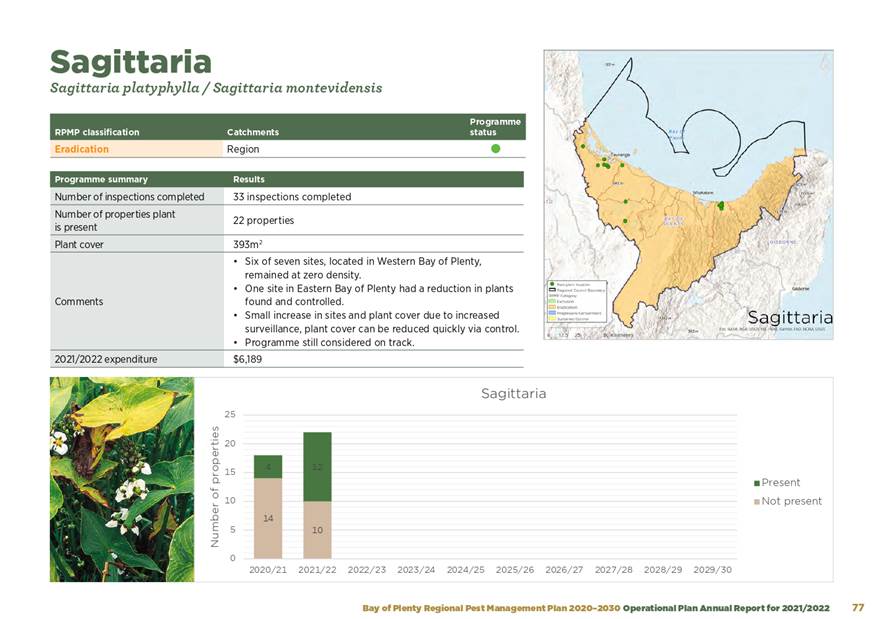








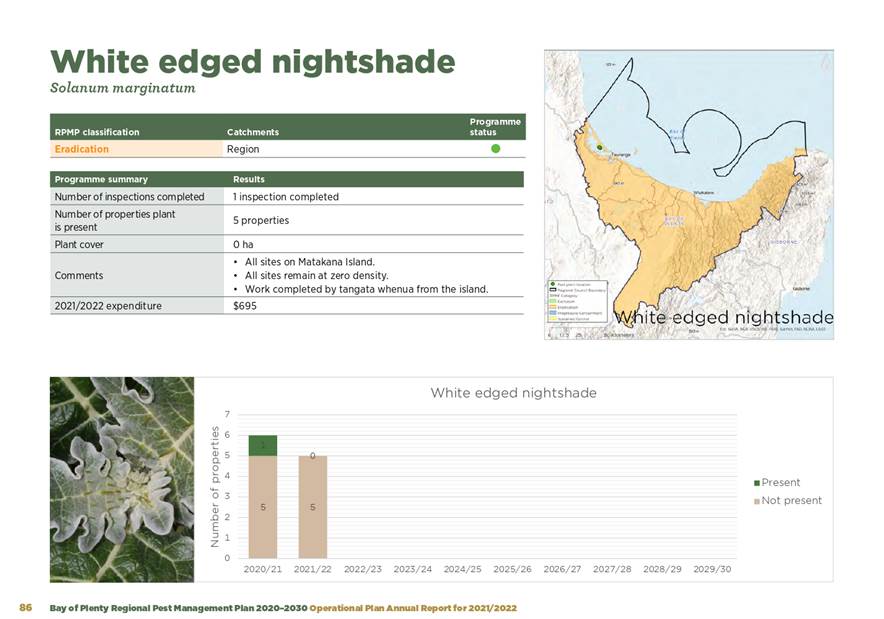
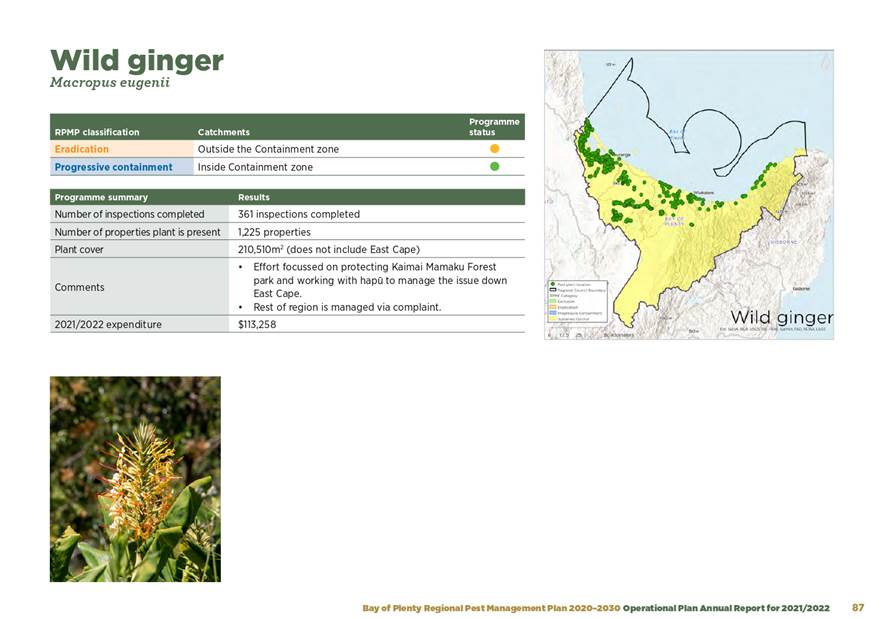
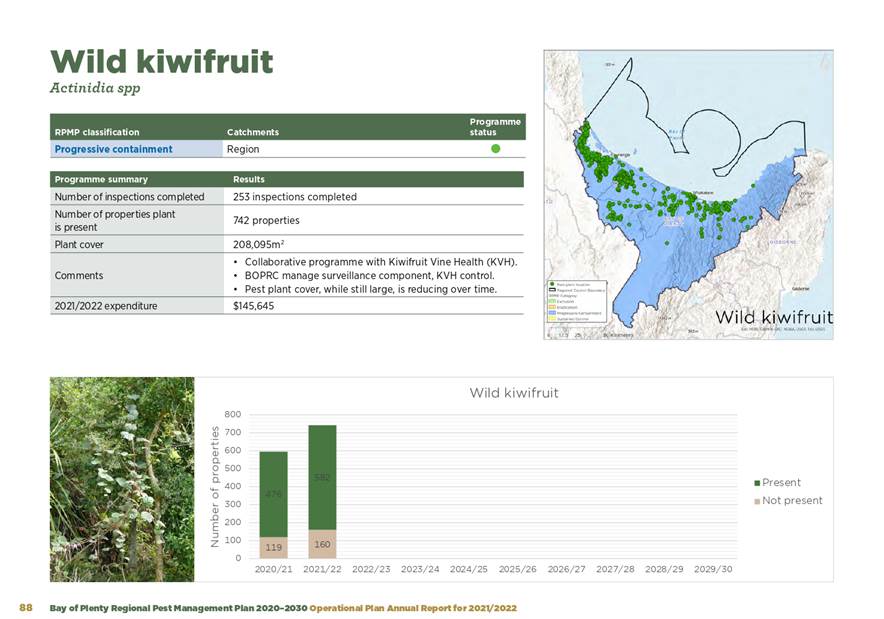

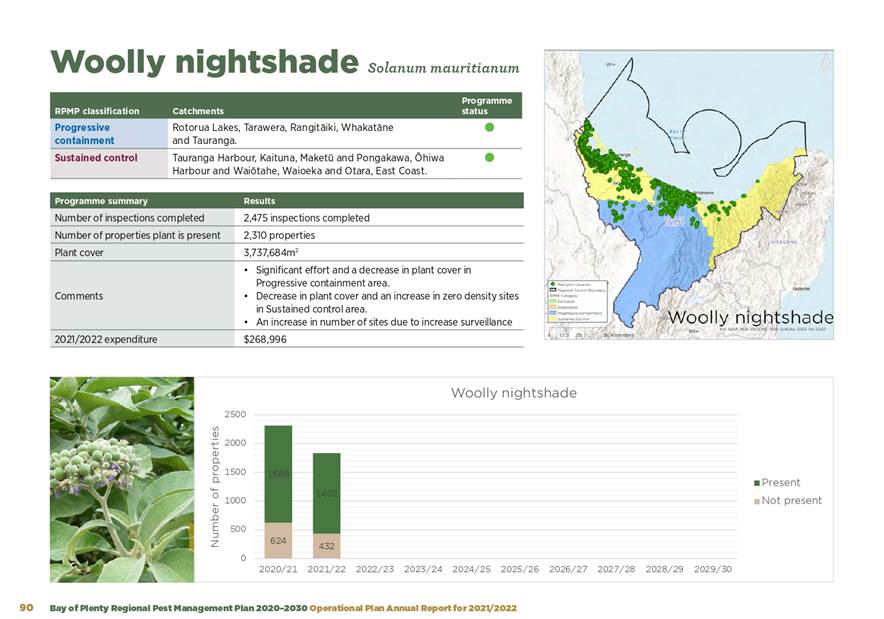
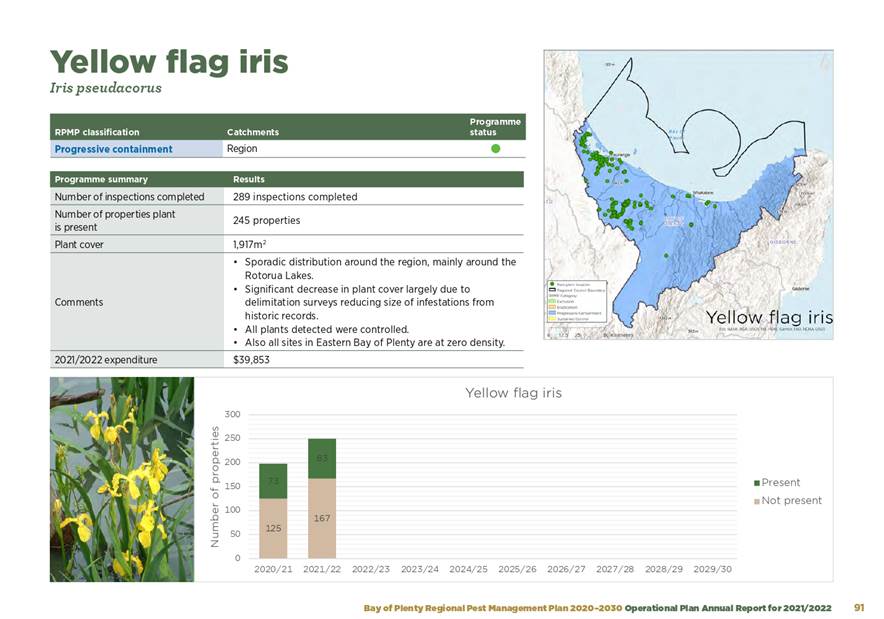
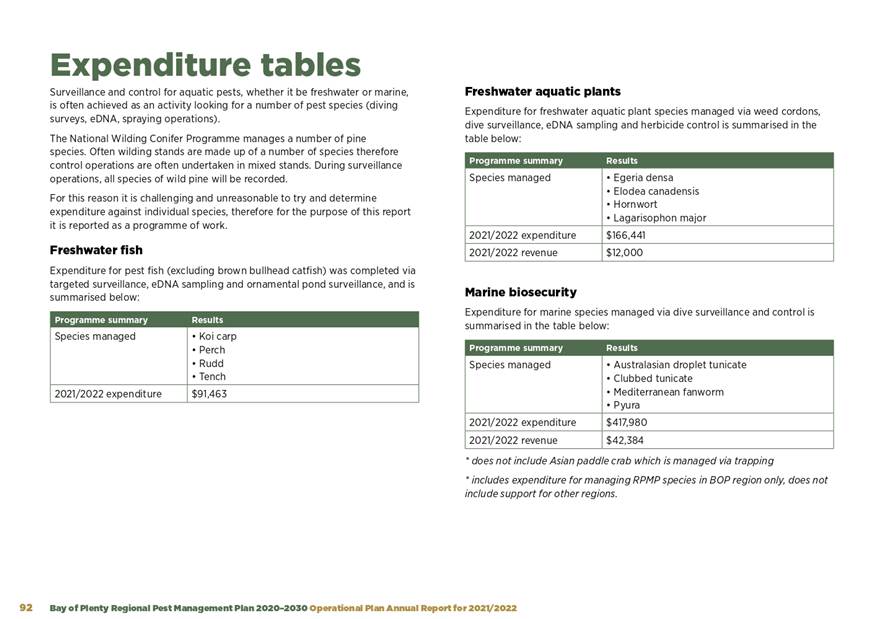

|
|

|
|
|
|
Report To:
|
Monitoring
and Operations Committee
|
|
Meeting
Date:
|
6
September 2022
|
|
Report
Writer:
|
Reece Irving, Senior Regulatory
Project Officer
|
|
Report
Authoriser:
|
Reuben
Fraser, General Manager, Regulatory Services
|
|
Purpose:
|
To update the Monitoring and
Operations Committee on activities underway to improve air quality and the
overall environment in the Mount Maunganui Airshed.
|
|
|
|
Mount
Maunganui Industrial Area update
|
Executive Summary
This report
provides an update on activities undertaken to improve air quality and the
wider environment in the Mount Maunganui industrial airshed. The report covers
the period from June until August 2022.
During this
period, nine breaches of the PM10 National Environmental Standards for Air Quality (NES)
were recorded within the airshed. All of these were recorded over two days
(18/19 August) during a time of heavy sea fog blanketing the Mount Industrial
area. The exceedances were recorded over five separate monitoring locations.
The climatic conditions are a strong indicator natural sea salt is highly
likely to have caused this number of simultaneous exceedances. An application
will be made to the Ministry for the Environment for dispensation to be
granted for these breaches. The total number of confirmed PM10
exceedances for this NES reporting year remains at six (1 September 2021 to
31 August 2022). Only one exceedance per year is allowed under the NES.
The report
gives an overview of meetings and community engagement that has taken place
recently, including the Mount Industrial Network, liaising with Clear the Air
Community Group regarding residential air quality monitoring and relationship
building between Clear the Air and asphalt manufacturers Allied and Higgins.
|
Recommendations
That the Monitoring and Operations Committee:
1 Receives the report, Mount Maunganui Industrial Area
update.
1. Introduction
This update
continues regular reporting on activities and actions undertaken to mitigate
the impacts of industrial discharges to air and the wider environment in the
Mount Maunganui industrial area. Air quality in the area has been perceived as
degrading over time as industrial activities and vehicle movements have
increased significantly in recent years.
Bay of
Plenty Regional Council has an extensive work programme underway to improve air
quality in this area. Measured breaches of National Environmental Standards
(NES) for PM10 and SO2 have been reducing year on year,
however the community remain concerned that airshed pollution is impacting
human health. The objectives of the programme are:
Short
term: meet our legislative requirements
for air, land, and water quality
Long
term: deliver on the community’s
expectation to live in a healthy environment
The Mount
Air Quality Working Party remains active in bringing together various central
and local government agencies, iwi / hapū, community groups, councillors,
commissioners, and industry representatives. This group is working towards
better outcomes for all stakeholders in the Mount Maunganui airshed and
surrounding residential areas with several actions being worked through in
2022.
1.1 Legislative Framework
The Mount
Maunganui Airshed was gazetted as a polluted airshed under the NESAQ
Regulations 2004, coming into effect in November 2019. The gazetting was based
on breaches of the limits for fine particulate matter, PM10. As per
the regulations, five continuous years with no NESAQ PM10 breaches
must be recorded for the polluted status to be reviewed. Whilst year on year
the number of PM10 breaches recorded has been reducing, we have yet
to record a year since the air-shed was gazetted with zero breaches of the NES
regulations.
1.2 Alignment with Strategic
Framework
|
A Healthy Environment
|
We
develop and implement regional plans and policy to protect our natural
environment.
|
|
Freshwater for Life
|
We
collaborate with others to maintain and improve our water resource for future
generations.
|
|
Safe and Resilient Communities
|
We work
with our partners to develop plans and policies, and we lead and enable our
communities to respond and recover from an emergency.
|
|
A Vibrant Region
|
We work
with and connect the right people to create a prosperous region and economy.
|
|
The Way We Work
|
We look
to partnerships for best outcomes.
|
1.2.1 Community Well-beings Assessment
|
Dominant Well-Beings Affected
|
|
þ Environmental
Medium
- Positive
|
þ Cultural
High -
Positive
|
þ Social
High -
Positive
|
þ Economic
Medium
- Negative
|
Local communities, including
hapū connected with Whareroa Marae, residents of Mt Maunganui from Pilot
Bay, Marine Parade to Ōmanu and users of sport and recreation facilities
have expressed their desire to live and play unaffected by industrial activity
and emissions. Overall, a reduction in industrial activity will have positive
benefits on environmental, cultural, and social well-beings, however a converse
impact on economic wellbeing will be felt if new industries do not develop or
existing industries are forced to move away from the area.
2. Updates – June to August 2022
2.1 Monitoring and exceedances
in the current reporting period
The full list of PM10
exceedances since the monitoring network was established is included in
Appendix 1. Investigations of PM10 exceedances continue to show a
single pollution source is seldom the cause and the cumulative effect of
emissions from multiple sources is generally responsible.
During this reporting period
nine PM10 NES exceedances were recorded over two days in mid-August
when heavy sea mist was blanketing the Mount. Early investigations indicate
natural sea salt is highly likely to have caused the exceedance events detected
at five separate monitoring locations. Application to the Ministry for the
Environment will be made for exceptional circumstances for all nine of these
breaches.
Investigations into the three
breaches recorded on 21 April are on-going with the paper monitor tapes
currently being analysed under electron microscopy. It is suspected natural
sea-salt was the key contributor to the exceedances. One of the exceedances was
reported from Ballance’s private monitoring network.
The total number of confirmed PM10
exceedances for this NES reporting year (1 September to 31 August), excluding
the nine recorded in mid-August is six (two in September, one in December 2021
and three in April 2022). Only one exceedance per year is allowed under the
NES.
2.2 Mount Maunganui Air Quality
Working Party
The Mount Air Quality Working
Party held its third hui of 2022 on 23 August.
Clear the Air gave a
presentation outlining the lived experience of the Mount community down-wind of
the Mount Industrial area and the community’s goal for an odour/pollution
free future.
TCC Commissioners and Planners
gave an overview of progressing the Long-Term Plan, how zoning may affect
future development, the long-term vision for the Mt Industrial Area and an
update on including a LIM notice on Mt Maunganui residential properties.
Ballance updated on recent
investment and upgrades made to reduce discharges from their plant, and
Regional Council outlined compliance and improvements in the Industrial Area
over the past four years.
Working Party members discussed
the difficulties faced by community members volunteering their time to work on
the issues and represent communities in the Working Party. A request was made
for funding to be provided for a community representative to work on the
issues.
For a full record of the meeting
and presentations, the meeting minutes are attached as Appendix 2.
A dedicated webpage for the
Mount Maunganui Air Quality Working Party, where reports, meeting agendas and
minutes will be stored for members has been developed. This can be viewed at: www.boprc.govt.nz/mount-industrial-air-quality-working-party
2.3 Pollution Hotline
Complaints Response
From 16th June to 16th August
2022, 35 calls were received through the Pollution Hotline relating to events
within the Mount Industrial Airshed. Of these, 33 related to air quality with
24 of these relating to odour. Currently, across our region, odour complaints
related to pet food company(s) were the main cause of calls to the Pollution
Hotline, making up 79% of all calls received.
All urgent calls were responded
to within 12 hours and non-urgent calls responded to within three working days.
Bitumen-like odour complaints
made up 3% of all calls in the Mount Industrial Airshed during this time (a
total of 1 call related to this specific odour) – see table below.
|
Pollution Hotline Complaint Categories 16th June to 16th August
2022– Mount Industrial Area
|
|
Category
|
# calls
|
% calls
|
|
Water
and Land
|
1
|
3
|
|
Coastal
|
1
|
3
|
|
Air
|
33
|
94
|
|
Total
|
35
|
100
|
|
Pollution
Hotline Complaint Sub-Categories 16th June to 16th August 2022 – Mount
Industrial Area
|
|
Sub-Category
|
# calls
|
% calls
|
|
Water & Land – Discharges to Water
|
1
|
3
|
|
Coastal
– Discharges
|
1
|
3
|
|
Air – Agrichemical
|
1
|
3
|
|
Air – Dust
|
4
|
11
|
|
Air – Industrial
|
1
|
3
|
|
Air – Odour
|
24
|
68
|
|
Air – Smoke
|
2
|
6
|
|
Air – Unknown
|
1
|
3
|
|
Total
|
35
|
100
|
2.4 Communications and Media
Newsletters were distributed to
community and industrial stakeholder groups in July covering a range of air
quality related updates including:
· June Monitoring and Operations Committee report
· Report-It odour reporting App
· Recent monitoring and PM10 dust exceedances
· Industrial Pollution Prevention audit programme
· 24/7 Pollution Hotline reports
· Fumigation updates
The community newsletter can be
viewed at www.boprc.govt.nz/mountindustrial
2.5 Consents
There are
currently eight businesses that have applied for discharge consents within the
Mount Industrial air shed. There has been no change in the status of these
applications since last reported in June to this committee except that Allied
Asphalt and Higgins have agreed to provide the technical information requested
for their consent applications, by the end of August. This will allow technical
reviews of this information to be undertaken while they continue undertaking
their consultation. All other applications are awaiting
further information to be provided and/or consultation regarding cultural
effects.
Consents currently
in process are:
Renewals:
· Waste
Management
· Lawter
· Allied
Asphalt
· Higgins
New applications:
· HR
Cement
· TPT
Forests Ltd
· Matariki
Forests
· Timberlands
Ltd
2.6 Policy Matters
Since the last report there has
been little change to the development of the high-level framework of provisions
for Plan Change 18 – Mount Maunganui Airshed (PC 18). This is due to Plan
Change 13 – Air Quality (PC 13) remaining before the Environment Court,
and a series of developments involving central government legislation and
external agencies, which continue to affect its preparation.
To ensure
consistency within the Regional Natural Resources Plan, PC 18’s progress
will be limited until the resolution of the remaining PC 13 appeal. It also
requires clarity in relation to the NES, which is in the process of being
amended by the Ministry for the Environment. It is understood that the NES
amendments are themselves reliant on Ministry analysis of two other sources of
information: the “Health and Air Pollution in New Zealand” (HAPINZ)
study, which was released in July, and the World Health Organization’s
“Global Air Quality Guidelines”, released in September 2021.
Council staff have been in regular contact with the Ministry to seek
updates on the timing of the possible release of the NES amendments. The
Ministry website initially suggested that the NES would be released by
mid-2021, but Council staff understand that there is now no definite timeline
for their release.
Once the matters detailed above,
which have delayed the development of PC 18, are resolved, the draft framework
will be updated to reflect their requirements, and it will be discussed with
key stakeholders in the Airshed, and their feedback sought.
In July, staff collaborated on
an application to the Ministry for an “Exceptional Circumstances”
application for a breach of the PM10 standard of the NESAQ. The
breach, recorded at Rata Street, is believed to have been caused by sea spray
from elevated weather conditions.
2.7 Meeting updates
2.7.1 Bitumen odours
Staff convened
a meeting with Clear the Air community group, Higgins, and Allied Asphalt to
discuss the bitumen odours being experienced by the community in Mount
residential areas. Both asphalt companies have consent processes underway to
upgrade their sites and short, medium and long term options around odour
mitigation were discussed.
For the short
term, a process has been set up that allows Clear the Air representatives who
live in the vicinity of the plants to message the companies directly when
odours are escalating. We are also refocusing the “Report It” odour
reporting app for the Mount area (previously trialled in Truman Lane) and will
provide targeted communications to residents around what to do if they smell
unpleasant odours.
For the medium
term, industry will keep Clear the Air up to date on the consent processes. For
the longer term, we shared information about Plan Change 18, specific rules for
industry operating in the Mount Maunganui air-shed.
2.7.2 Mount Industrial Network
In April 2021
organisation of the Mount Industrial Network was handed over to industry at
their request. That was the last meeting in which Regional Council played a
role. Ballance Agri-nutrients requested council support to convene another
Industrial network meeting. The meeting was well attended with 30+ business and
industry representatives around the table.
Graeme Marshall
(Chair of the Mount Air Quality Working Party) opened the meeting with a
challenge to industry to meet their social license to operate. Ballance
presented on the investments they continue to make to improve air quality and
reduce discharges from their manufacturing and transporting processes. There
was robust discussion amongst industry representatives about sharing mitigation
measures. Tauranga City Council gave an overview on planning for the
Mount’s future – this was also presented to the Air Quality Working
Party hui on 23 August. Regional Council presented on compliance observations
over four years, and the impacts of changing legislation on the consents
process.
Please find the
meeting minutes attached as Appendix 3.
2.8 Dust (PM) Monitoring in
Mount residential areas
Staff met with Clear the Air
representatives to discuss options for monitoring in Mount Maunganui
residential and recreational areas, and to get their feedback on what they
would like to see going forward. Support was expressed for a network of air
monitors the same or similar in concept to the Clarity low-cost air monitors
that were trialled by Regional Council in January 2022.
The advantages of the smaller
Clarity type units are that a network can be established across a wider area,
data can be readily accessed online, the units are easily installed on existing
infrastructure and are solar powered. As the Clarity type monitors are of lower
data quality than the existing NESAQ compliant monitors located in the Mount
Industrial zone the data will be used to show overall trends in air quality and
compliment the high-quality data we receive from the existing network.
2.9 Health and Air Pollution in
New Zealand (HAPINZ Report)
The Ministry for the Environment, Waka Kotahi New Zealand Transport
Agency, Te Manatū Waka Ministry of Transport, and Manatū Hauora
Ministry of Health released a report “Health and air pollution in New Zealand
2016 - He rangi hauora he iwi ora (HAPINZ 3.0)”. This is the third
iteration of the Health and Air Pollution in New Zealand study.
The report, and associated documents are available at www.mfe.govt.nz. A
summary of the key findings are highlighted below.
Health costs of air pollution in the Bay of Plenty
In 2016, it was estimated the Bay of Plenty region incurred health
costs of $1.01 billion (premature deaths, hospitalisations, restricted activity
days) due to PM2.5 and NO2 pollution (nationally, it was
estimated there were more than 3,300 premature deaths, and total cost of $15.6
billion). Vehicle emissions contribute most air pollution health costs (NO2
and PM2.5) to our region. Rotorua has an even split between domestic
fire and vehicle emission costs ($132m/$142m), showing the higher wood burner
use there, while in Tauranga, costs related to domestic fires are roughly
¼ of vehicle emission costs ($103m/$380m).
This table shows the total anthropogenic costs that have been
estimated for districts in our region, with Hamilton and Christchurch also
shown as an example of districts elsewhere in the country.
|
Costs of all
anthropogenic air pollution by TA in 2016 (in 2019 NZ$)
|
|
District
|
Population
|
Social costs by
source ($million)
|
|
|
|
domestic fires
|
motor vehicles
|
industry
|
windblown dust
|
total
|
|
Kawerau
|
7,120
|
6
|
17
|
1
|
1
|
$25
|
|
Ōpōtiki
|
9,295
|
6
|
14
|
0
|
2
|
$21
|
|
Rotorua
|
72,285
|
132
|
142
|
0
|
8
|
$282
|
|
Tauranga
|
131,130
|
103
|
380
|
1
|
16
|
$499
|
|
Western Bay
|
49,380
|
28
|
70
|
0
|
6
|
$103
|
|
Whakatāne
|
35,950
|
23
|
58
|
0
|
5
|
$86
|
|
|
|
|
|
|
|
|
|
Hamilton City
|
160,770
|
98
|
363
|
0
|
14
|
$475
|
|
Christchurch City
|
374,600
|
640
|
1,466
|
1
|
54
|
$2,161
|
National NO2 Costs
NO2 pollution is assumed to result in its entirety from
motor vehicles and its contribution of $9.5 billion is considerably higher than
PM2.5’s $6.1 billion. An increase in population and kms
travelled by motor vehicle contributed, but a sharp rise in diesel vehicle use
was also recorded.
National PM2.5 Costs
The $6.1 billion costs of PM2.5 are attributed,
nationally, as follows:
· Domestic fires: 74%
· Motor vehicles: 17%
· Windblown dust: 8%
· Industry: 0.1%
2.10 Industrial Activity update
Port of Tauranga Ltd
The Port of Tauranga continue to
make changes to improve air quality beyond their boundary, the new wind fence
along the southern end of Tasman Quat and along the corridor with Kiwi Rail and
the Rail Yard South monitoring station has now been completed.
The efforts made by POTL, and Kiwi Rail has resulted
in a noticeable reduction in PM10 exceedances over the past four
years, NES breaches detected at the Rail Yard South monitoring site since 2019
are as follows:
· 16
PM10 exceedances in 2019
· 6
PM10 exceedances in 2020
· 1
PM10 exceedances in 2021
· Of
the nine exceedances detected across the monitoring network on 18/19 August for
which exceptional circumstances dispensation is being sought, two were recorded
at the Rail Yard South monitoring site.
Port of Tauranga and several
industry partners trialled an alternative enclosed ship unloading technology
for handling dusty stock foods.
The trial identified that the technology in its current form is not suitable in
this application for multiple reasons.
It is likely that considerable research and development would be required to
address key failings of the ‘off the shelf’ technology and it is
unclear at this time if a practicable solution can be identified, however, some
further works are being undertaken in this area. Other
improvement opportunities and engineered solutions are also being investigated.
2.11 Pollen in the air and stormwater
It is that time of year when
pollen is very visible in the air, on property and in the water. This has
resulted in an increase in dust complaints recently. Pollen particles are
generally too large to be picked up by our PM10 or PM2.5 monitors
but some spikes on the Total Suspended Particulates (TSP) may be attributed to
pollen.
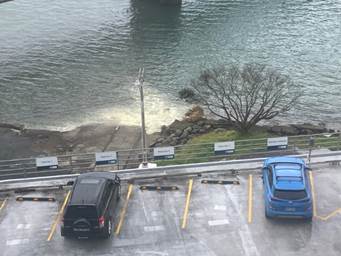
Figure
1: A pollen plume entering the harbour via the stormwater drains in front of
Regional House.
3. Considerations
3.1 Climate Change
Improving air
quality in the Mount Maunganui Industrial Area will not in and of itself impact
on climate change. However, cleaner air will certainly ensure potential effects
from contaminant discharges will be mitigated. Methyl bromide is an ozone
depleting substance and having strict controls on its use as guided by the EPA
is important and we can see the impact of these on the reduction in MeBr
application at the Port so far in 2022.
3.2 Implications for Māori
Ngāi
Tukairangi and Ngāti Kuku ki Whareroa are the Ngāi Te Rangi hapū
affiliated with Whareroa Marae and with whom Regional Council staff have been
endeavouring to foster closer relationships to ensure council actions will have
direct and positive impacts on the Taiaho Place and papakainga communities.
Staff have also been working hard to ensure the communities relate to agencies
such as Ministry for the Environment and Toi te Ora and surrounding business
and industry.
The
establishment of the Air Quality Working Party has provided another platform
for engagement with iwi and hapū and for their concerns to be heard around
a wider table. This is a space of ongoing commitment from all parties involved
as there is clearly still a degree of distrust of government agencies and actions
held by the Whareroa community.
3.3 Community Engagement
|

|
CONSULT
Whakauiuia
|
To obtain input or feedback from affected communities
about our analysis, alternatives, and /or proposed decisions.
|
3.4 Financial Implications
If the recommendation is adopted by Council, will it result in:
- Unbudgeted work during the current financial
year?
- Unbudgeted work for any of the years remaining
in the current Long Term Plan?
If the answer is ‘no’ to both questions please
select the dropdown option 1 and complete appropriately.
If the answer is ‘yes’ to either question please
select “Budget Implications” in the building block below and liaise
with your Management Accountant in order to complete the Financial Impact
table.
There are no
material unbudgeted financial implications and this fits within the allocated
budget.
4. Next Steps
Next Steps: What next? What resources are needed? Further
analysis? Timeframes ahead. Any consultation planned. Remind Council of the
process ahead. Next update to Council?
Conclusion: Short concluding remarks. Referring back to
recommendations. No new content.
Staff will continue to update this Committee on all
work underway to improve air quality in the Mount Maunganui Industrial Area.
There is a wider focus on all environmental discharges and ensuring the minimal
impact on human health resulting from industrial activity. The six-monthly
updates on these works requested by the Minister for the Environment from Bay
of Plenty Regional Council continues to be provided with the most recent sent
to the Ministry in June.
Attachments
Attachment 1 - Spreadsheet of all PM10 exceedances to August 2022 ⇩
Attachment 2 - Mount Air Quality Working Party 23 August 2022
meeting minutes ⇩
Attachment 3 - Minutes of the Mount Industrial Network meeting ⇩
Monitoring
and Operations Committee 6 September 2022
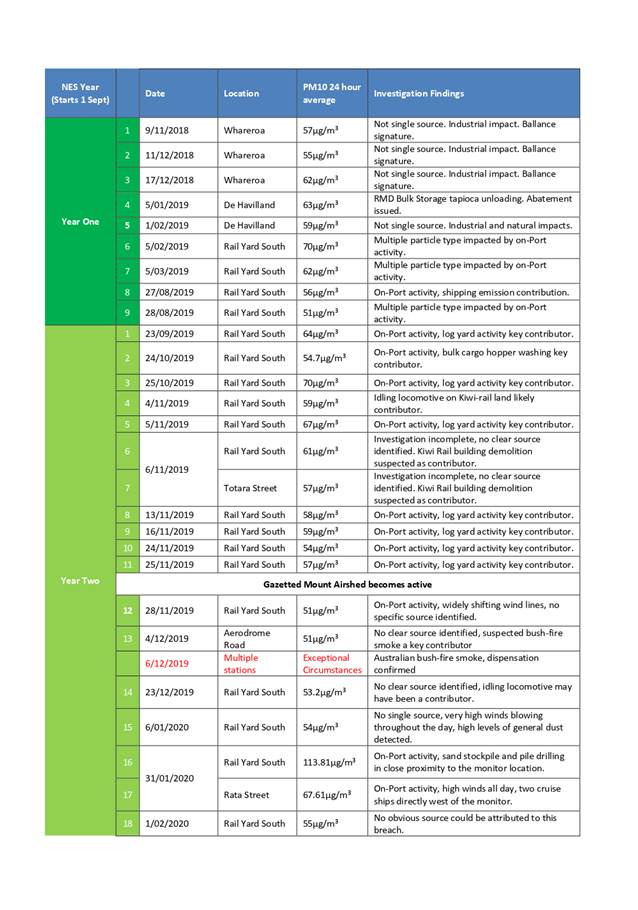
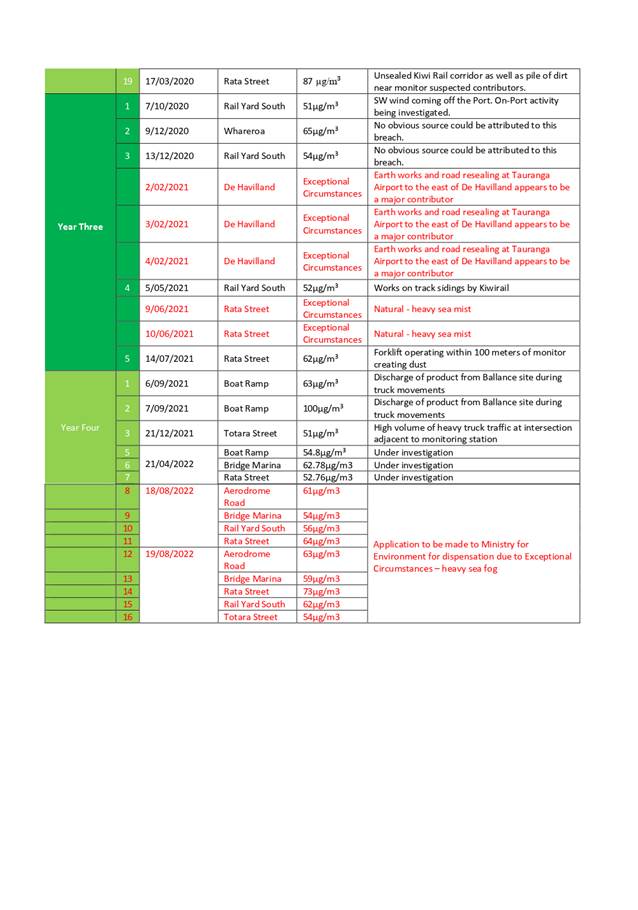
Monitoring and Operations
Committee 6 September 2022
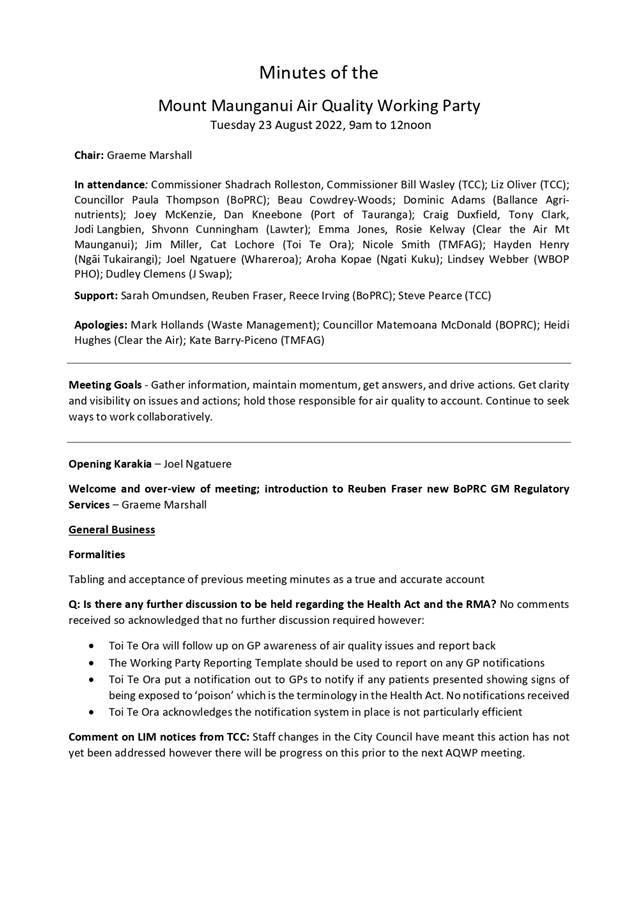
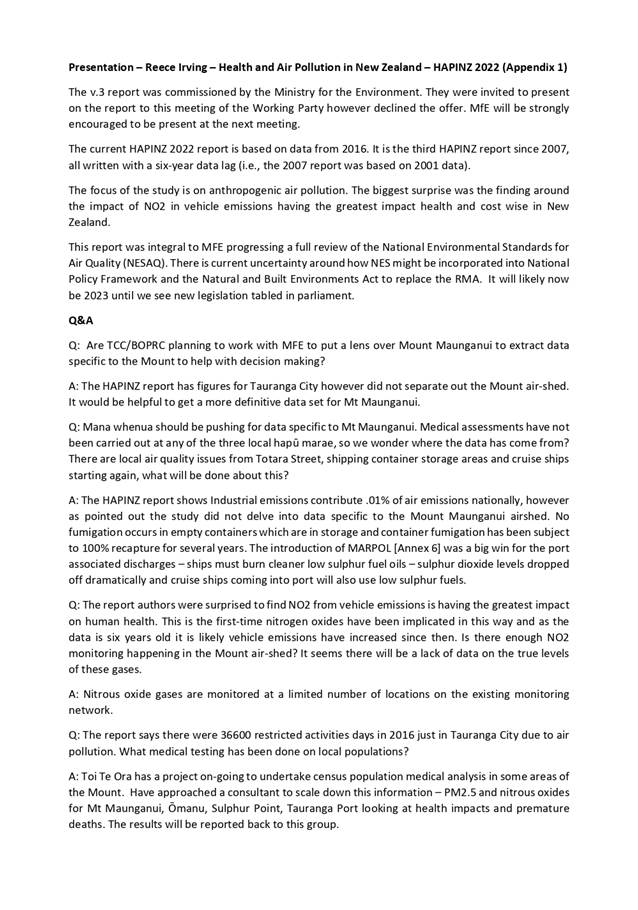
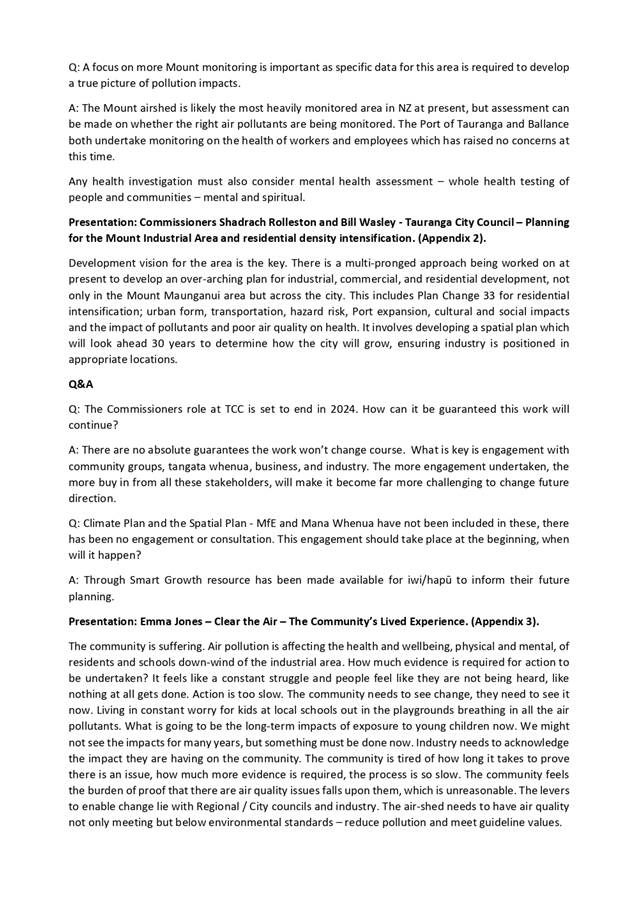
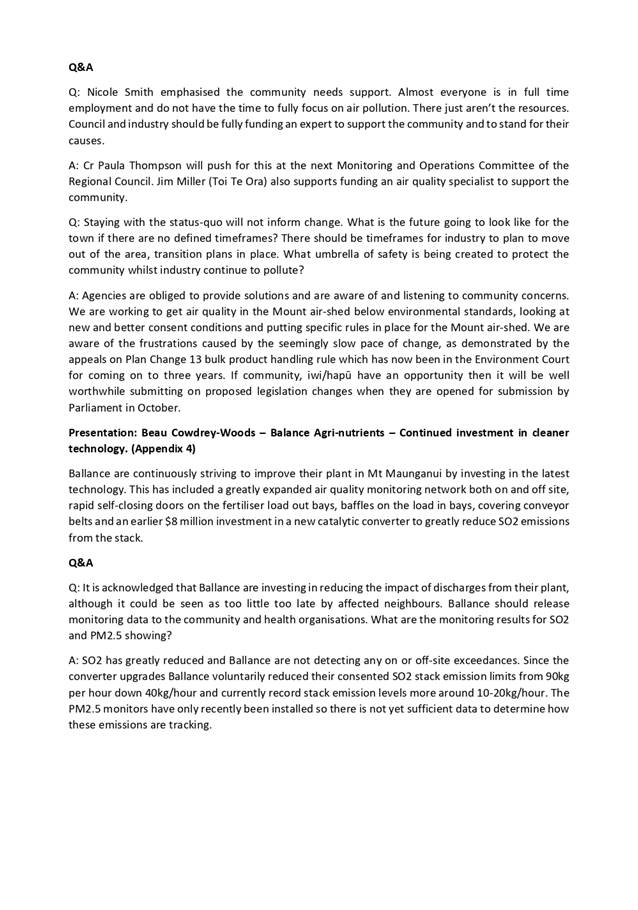
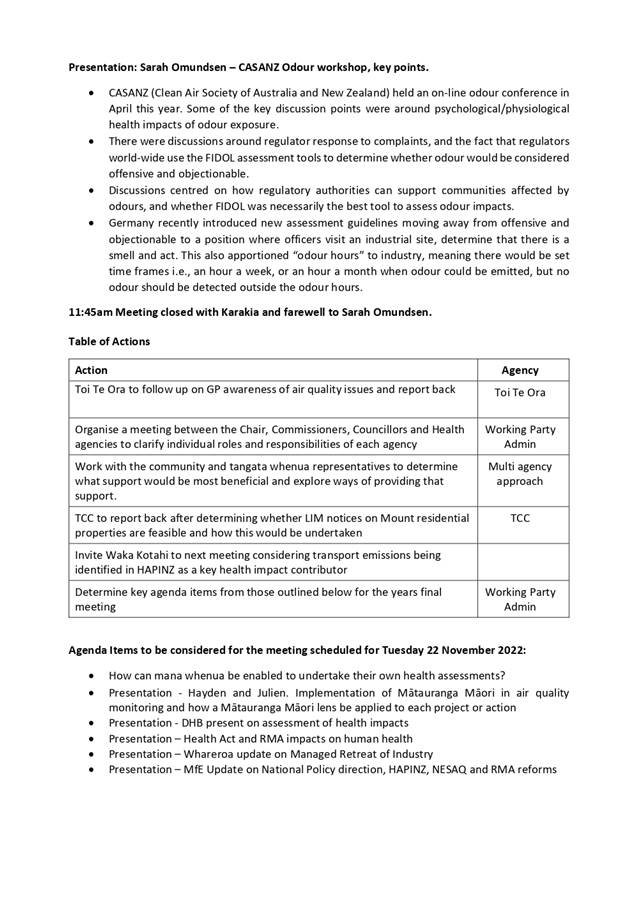
Monitoring and Operations
Committee 6 September 2022
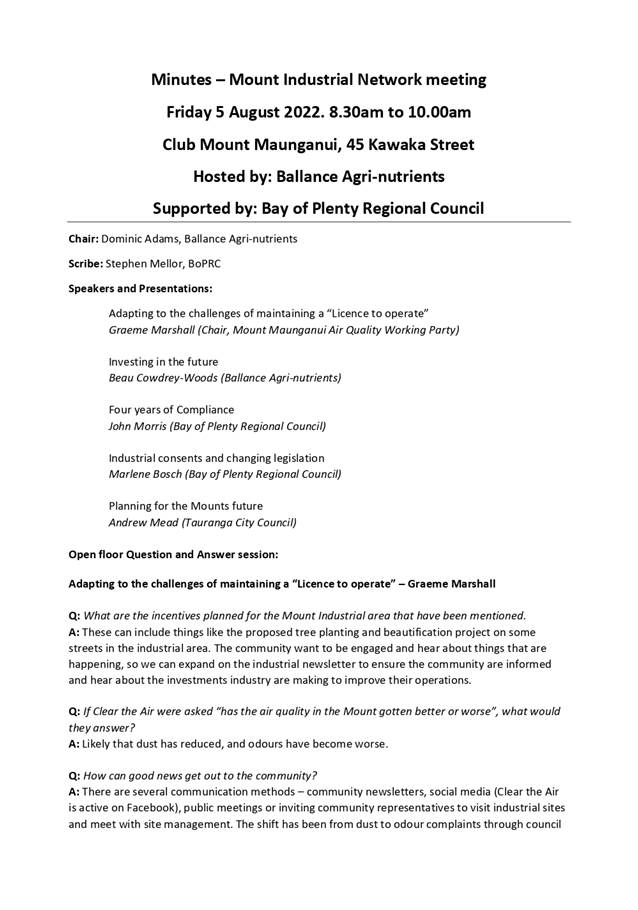
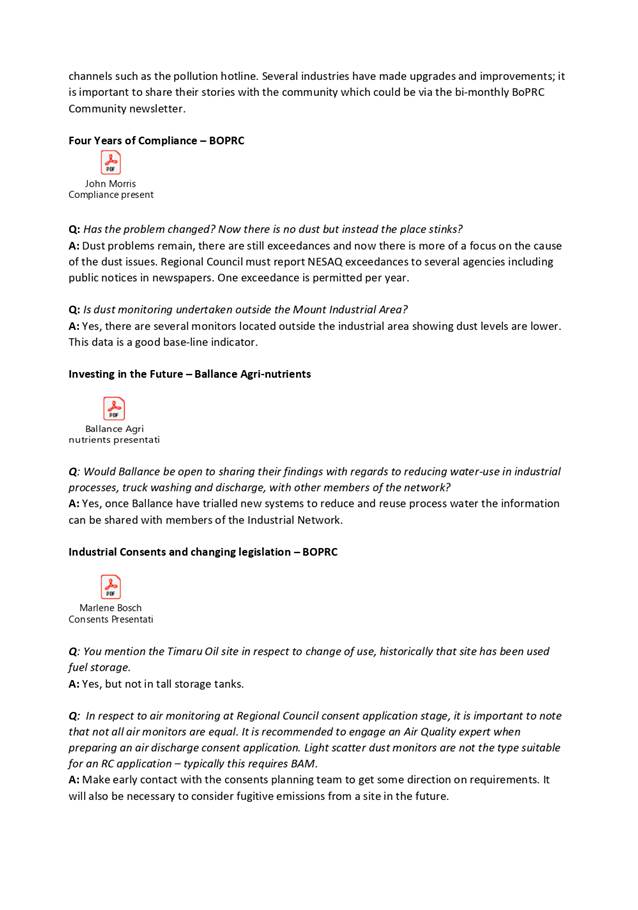
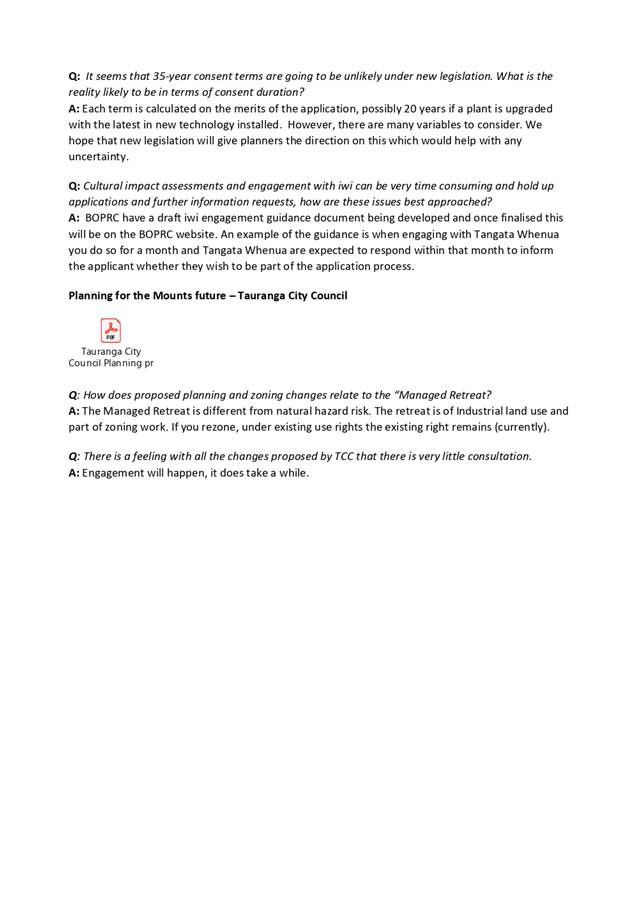
|
|

|
|
|
|
Report To:
|
Monitoring
and Operations Committee
|
|
Meeting
Date:
|
6 September
2022
|
|
Report
Writer:
|
Ella Tennent, Principal Advisor,
Consents
|
|
Report
Authoriser:
|
Reuben
Fraser, General Manager, Regulatory Services
|
|
Purpose:
|
To inform the committee on the
activities and performance of the Resource Consents Team during 2021-2022.
|
|
|
|
Resource
Consents Annual Report
|
Executive Summary
This report provides a summary of the activities and performance of
the Resource Consents team in 2021/22. KPIs were exceeded this year with just
2.8% of applications receiving discounts (target is no more than 5%) and an 88%
customer satisfaction score. Other key points are:
· 97%
of non-notified applications were processed within statutory timeframes;
· 53%
of applications were processed within 40 working days;
· 714
resource consent applications were received (similar to last year) and 685
were completed (five more than last year and a record high);
· Discharge
consents were the most numerous issued although high numbers of land use,
lake structure, and water take consents were also issued;
· The
number of applications that were returned due to being incomplete is the
lowest of the last five years; and
· A
range of notable consents were progressed during the year including the Whakatane
Harbour (fast track).
|
Recommendations
That the Monitoring and Operations Committee:
1 Receives the report, Resource Consents Annual Report.
1. Introduction
This report provides an update
to Council on the activities and performance of the Consents Team during the
2021/22 financial year. The team has met Key Performance Indicators (KPIs) for
discounts on consent processing fees and customer satisfaction. Application
numbers were similar to the previous year, five more consents were completed
this year and the complexity of applications continues to increase. The team
were involved in a number of high profile and interesting applications during
the year and these are summarised below. In addition to consent
application processing, the Consents Team has been involved with providing
feedback on RM reform, the essential freshwater 2024 plan change and various
changes to national planning instruments such as the National Environmental
Standards for Freshwater and National Policy Statement for Freshwater
Management.
1.1 Alignment
with Strategic Framework
|
A Healthy Environment
|
We
develop and implement regional plans and policy to protect our natural
environment.
|
|
Freshwater for Life
|
We
listen to our communities and consider their values and priorities in our
regional plans.
|
|
The Way We Work
|
We
provide great customer service.
|
1.1.1 Community
Well-beings Assessment
|
Dominant Well-Beings Affected
|
|
¨ Environmental
|
¨ Cultural
|
¨ Social
|
¨ Economic
|
This report is for information only and although the
work of the Consents Team does impact community well-beings no changes are
proposed here.
2. Consent
Processing
2.1 Statutory
Timeframes
97% (654) of all non-notified consents were processed
within the statutory timeframes, similar to 2020/21 (98%) and up from 95% in 2019/2020.
This resulted in just 19 applications (2.8%) receiving discounts which achieves
the KPI of <5%. 53% of applications (362) were processed within 40 workings
days which is similar to the previous year.
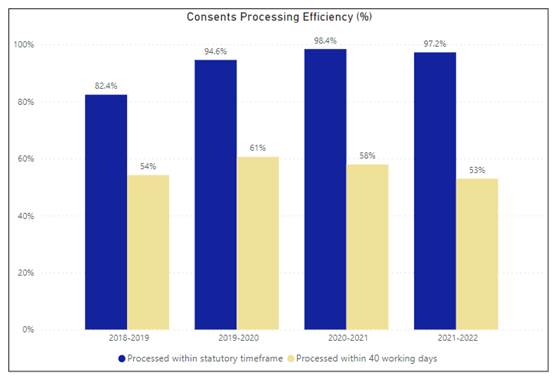
Figure 1:
Consent processing efficiency between 2018 and 2022
2.1.1 Statutory Timeframes and ‘Clock
Stops’
The Resource Management Act 1991
(RMA) states how long a consent authority has to process an application, which
differs depending on the notification pathway the consent is processed through
and is known as the statutory timeframe.
The RMA also articulates the
mechanisms which allow for these timeframes to be paused or extended, known in
the RMA, as time excluded periods and extensions of time periods or,
informally, clock stops and timeframe extensions. An example of one of the
mechanisms that invokes a clock stop is a request for further information
(known by our planners as a ‘Section 92’ because this is the
section within the RMA which legislates this mechanism).
We are legislatively mandated to
meet statutory timeframes, which are highlighted in blue in Figure 1. We also
monitor the percentage of applications that take less than 40 total days,
highlighted in green, because this provides us with an appreciation of how
efficient we are being when utilising these clock stops.
2.1.2 Why might an application take longer
than 40 working days to process?
A request for further
information is the most common reason applications take longer than 40 working
days to process. Applicants are given 15 working days to respond to us,
however, this response can be outlining the likely timeframes to retrieve and
return this further information. During this time the statutory clock is
paused.
Some of these further
information requests take significant time for the applicant to gather all of
the information. For example, for a water take with a dam where we need more
information on the suitability of the dam (safety and design) the applicant
would need to engage an engineer. A longer response timeframe is very typical
for applications where further information is required on technical matters,
for example engineering, ecology, air quality, or where applicants are engaging
with tangata whenua about their application.
Another reason for a longer
processing timeframe is in relation to replacement consents. The Consent Holder
needs to lodge the replacement application within a specified timeframe to
secure s 124 rights. S 124 rights allow the Consent Holder to keep using
their existing consent, even after its expired, until the new consent is
decided. It has become common for Applicants to lodge their replacement
application within the specified timeframe (in order to obtain s 124 rights)
and ask for the processing to be put on hold whilst they provide information
that is usually required at the time of lodgement. Often this provides for
consultation with tangata whenua to be completed. This is a major contributor
to the number of applications which take more than 40 working days to
process.
Another factor that can contribute to applications
taking longer than 40 working days to process is because we often send draft
conditions to be reviewed by the applicant. While this is not required by the
RMA, it is good practice to send applicants a draft set of conditions prior to
making a decision on their application. This gives them a heads up on any
requirements of the consent that they might need to get organised, and allows
them to provide any feedback they may have in regard to suitability of the
conditions, for example, whether the conditions are feasible, if there are any errors
etc. This typically only takes a couple of days, however for larger/more
complex consents this might take weeks, especially if the applicant needs their
consultant or an expert to go over the conditions. During this time the
statutory clock is extended with the applicants’ agreement.
2.1.3 Applications
During the 2021/22 financial
year, 714 applications for resource consents and 290 applications for changes
to resource consents were received. This results in an average of approximately
84 applications per month. There is a decreasing trend in the number of change
applications received each year.
685 applications were processed
to completion during the year. This is a small increase in applications
completed compared to the previous year and a record high.
Of the applications received in
the 2021/22 year, 91% were allocated to staff and 9% were allocated to
consultants for processing. This is similar to the previous year with 90%
allocated to staff and 10% to consultants.
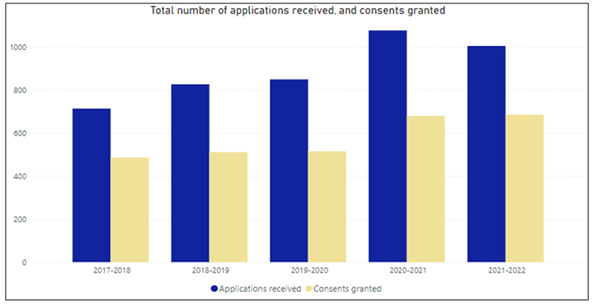
Figure 2
– Total number of applications received and granted
2.1.4 Activity Type and Location
Discharge to land consents were
the most common during 2021/22. Lake structures, water takes and earthworks
consents are also numerous. Much less-common consents include discharges to air
and water, which are more likely to be processed with notification.
Consents to drill bores (not water takes) are processed by the Regulatory
Administration Team and are not included in the graph below. 139 bore
applications were processed by the Regulatory Administration Team and decided
upon by the Consents Team.
The highest number of granted
consents came from within the Rotorua district, followed by Western Bay of
Plenty district. The high number from within the Rotorua district is likely to
be attributable to the number of lake structure consents granted during this
period. During the previous year 45% of applications were received from within
the Western Bay of Plenty.
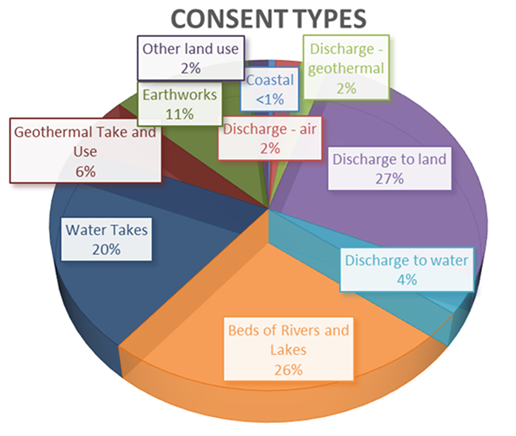
Figure 3:
Applications by activity type for 2021/22
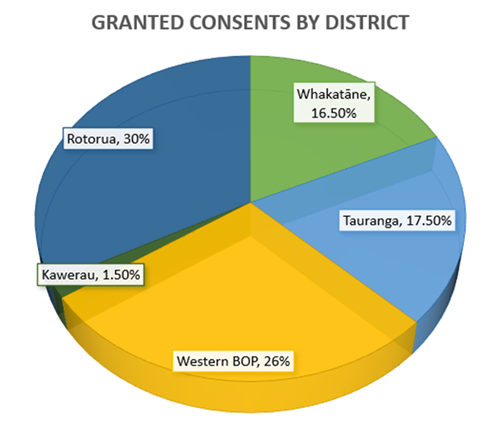
Figure 4
– Consents by district for 2021/22
2.2 Returns and Withdrawals
Resource
consent applications are returned at the start of the process if they do not
contain the information required. Consents planners provide guidance to
applicants in relation to the gaps in returned applications.
Applications
can also be withdrawn by applicants at any stage in the process. This generally
happens if the applicant’s plans change or consents are unlikely to be
supported.
During 2021/22
only 14 applications were returned which is approximately half of the returned
applications from the 2020/21 year and the lowest number recorded in the last
five years. This may be due to an increase in pre-application advice and the
use of processing time extensions to allow replacement applications to be
received whilst some information is still outstanding.
Thirteen
consents were withdrawn which is similar to last year.
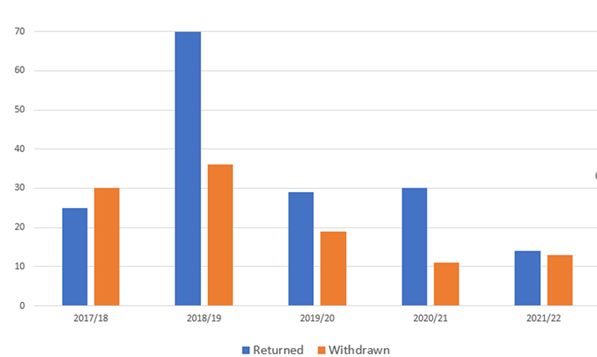
Figure
5: Returned and withdrawn applications between 2017 and 2022
2.3 Processing Efficiency
The average amount of staff time
it takes to process an application is the same as the previous year, 15.5
hours. This is less than 2019/20 and 2018/19 despite increasing complexity with
more national direction and case law.
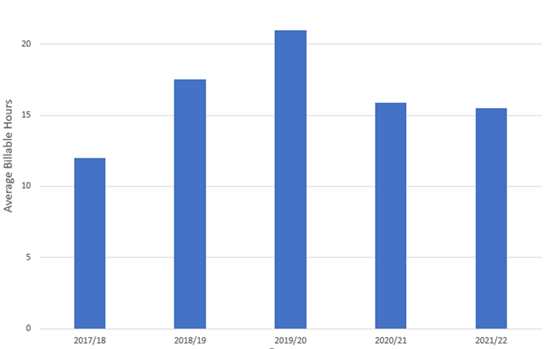
Figure 6: Average application processing times
3. Customer
Service
Customer service remains a
priority for the team and we are continuously improving in this area and have
been receiving training in dealing with difficult customers. All decisions sent
to consent applicants are accompanied by a customer satisfaction survey. In the
2021/22 year around 13% of applicants responded to the survey resulting in an
88% satisfaction score, which achieves the team KPI of 84% and is a 4%
improvement from the previous year.
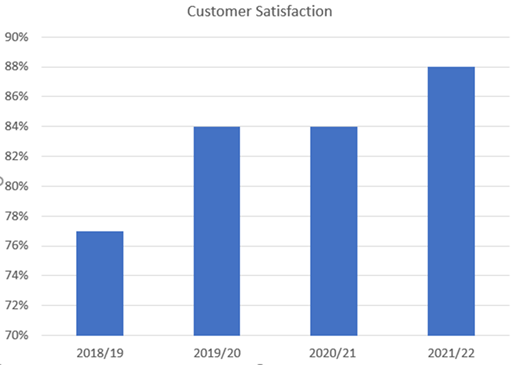
Figure 7: Customer satisfaction from 2018 to 2022
4. Team Activity
4.1 Enhancing
Cultural Awareness and Relationships
As part of the wider plan to
improve cultural awareness while building stronger relationships with tangata
whenua the team have undertaken some new initiatives.
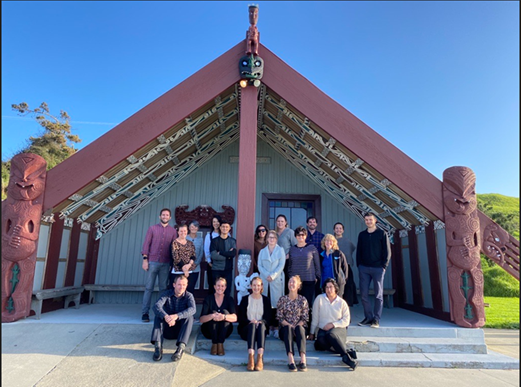
Figure 8: The consents team hui at Waitahanui Marae
With exception
due to Covid interruptions, the Consents Team meetings have continued to be
held at marae around the region. This provides an opportunity for the
team to engage with tangata whenua but also allow iwi and hapū to articulate
their aspirations and challenges, which provide a platform to collaborate and
identify ways to work better together.
In addition,
monthly hui are held with two iwi groups - Ngāti Ranginui and Ngāti
Awa - who have wanted to engage in this manner.
Members of the
Consents Team have utilised the Te Reo training that Toi Moana has offered and
appreciate this opportunity.
4.2 Improving
How We Work
4.2.1 Combined Reports
The team has
largely transitioned to using a combined report for both notification and
substantive decisions on non-notified consent applications. This creates
a more efficient process for the processing planner and the decision
maker.
4.2.2 Template
Conditions and Reports
Work has continued on creating and/or refining template consent
conditions and reports.
5. Projects and Significant Consents
5.1 Notable
Applications and Hearings
5.1.1 Whakatāne
Harbour Fast Track Application
The proposal to construct and
operate a boat harbour on Māori freehold land close to the left bank of
the Whakatāne River, immediately downstream of the SH30 bridge is the
first proposal in the Bay of Plenty to be accepted as part of the COVID-19
Recovery (Fast-Track Consenting) Act 2020 process. The applications for
resource consents from Toi Moana and Whakatāne District Council were
lodged directly with the Environmental Protection Agency (EPA) for a decision
by a panel appointed by panel convenor Judge L J Newhook.
Toi Moana (and Iwi, hapū
and stakeholders) were given the opportunity to comment on the application and
draft conditions. This required the engagement of experts, such as engineers
and ecologists. In order to meet the tight timeframes these technical reviews
were commenced with the draft application. Lucy Holden, Senior Consents
Planner, provided input to the EPA and coordinated the other experts. The panel
granted consents for the harbour in June 2022.
5.1.2 Stellar
Passage Direct Referral
The Port of Tauranga applied for
consents for works to extend the Sulphur Point and Mount Maunganui wharfs,
along with associated dredging of the shipping channel to enable the expansion
and ongoing operation of port activities (known as the Stellar Passage proposal).
The Environment Court hearing was set down for two weeks in July 2022 but
unfortunately due to Ngāi Te Rangi Covid infections the hearing has been
delayed. Consultants process Port of Tauranga applications instead of Toi
Moana Consents staff in order to avoid any conflict of interest.
The Fast Track and Direct Referral
processes have very limited ability for cost recovery.
5.1.3 Ziwi
Limited – Discharge to air (odour)
The notification period for the
Mount Maunganui based pet food manufacturers, Ziwi Limited, closed on the 18
Jun 2021 with 123 submissions. There was one submission in support, three with
conditional support and 119 in opposition of which 25 submitters wish to be
heard. The hearing was held in December 2021. Improvements to the plant
had been undertaken during the consent application processing and resulted in
an improvement in odour and most of the opposing submitters withdrawing their
wish to be heard prior to the hearing. The applicant is relocating its factory
to the Hawkes Bay and so amended their application to seek only a short
duration. Jacob Steens, Senior Consents Planner, processed the
application and attended the hearing. Consent was granted and was not
appealed.
5.1.4 Toi
Moana Instream Works
Toi Moana Integrated Catchments
Group applied for and were granted consent for instream works. The application
was notified, processed by a consultant, considered at a hearing and consent
granted by independent commissioners. The decision was appealed by Ngāti
Pikiao and has recently been resolved through mediation.
5.1.5 Rotorua
Lakes Structures
Toi Moana coordinates the
approval processes for lake structure owners for the Rotorua Lakes. Structures
require consent from Toi Moana and may also require various approvals from Te
Arawa Lakes Trust, Land Information New Zealand, Department of Conservation,
and Rotorua Lakes Council.
We put together specific packs
for each structure owner so that they get all the relevant paperwork together
and then distribute it to the relevant agencies once it has been returned.
After a significant amount of work all 666 required packs have been sent out,
and 651 packs (98%) have been received back. As part of the process, Toi Moana
commissioned a series of cultural mapping reports which were facilitated and
written by Te Arawa Lakes Trust following engagement with relevant iwi and
hapū. These reports identified whether each structure had effects that
were, in the views of tangata whenua, less than minor, minor, or more than
minor and have been used to inform Council’s notification decisions.
122 resource consents have so
far been granted for structures on Lake Rotomā, Lake Tarawera, Lake
Rotoiti and Lake Rotorua. Those Lake Tarawera structures identified as having
minor or more than minor adverse cultural effects have been limited notified to
Te Arawa Lakes Trust, Tūhourangi, Ngāti Rangitihi and Ngāti
Raukawa. The processing of the Lake Tarawera limited notified consent
application is on hold for more information from the Applicants. Limited
notification has also occurred for structures at Lake Rotoiti with notification
to Te Arawa Lakes Trust, Ngāti Pikiao, Ngāti Mākino Ngāti
Tamateatutahi – Ngāti Kawiti and Ngāti Rongomai. A pre-hearing
meeting with Te Arawa Lakes Trust is scheduled for August 2022 for the Lake
Rotoiti structures. Lucy Holden and Eleanor Christensen have been processing
the limited notification consents and Sherryn Owen is progressing the
non-notified applications.
5.1.6 Tauranga
Bridge Marina Extension
An application to extend the
Tauranga Bridge Marina was processed with limited notification to tangata
whenua. A hearing was held in August 2021 and thereafter a decision to
grant was released by independent commissioners. The decision was appealed by
Ngāti Kuku of Whareroa Marae. Marlene Bosch (Principal Advisor, Consents)
and Rachel Boyte (Legal Counsel) have been involved in mediation and preparing
evidence in preparation for an Environment Court hearing.
5.1.7 Omanawa
Falls Tourism Development
A joint hearing was undertaken
with Western Bay of Plenty District Council in September 2021 for the Omanawa
Falls development proposed by Tauranga City Council. Lucy Holden, Senior
Consents Planner, processed the application and attended the hearing. Consent
was granted by the hearing commissioners and the district council consent has
been appealed. A commencement order was granted by the Court to allow for some
work to proceed while the appeal is resolved.
5.1.8 Waiu
Dairy Factory
Following issues with the
discharge from the Waiu dairy factory going to the Kawerau District
Council’s wastewater system, a resource consent application was lodged
for discharge of the Waiu wastewater to land. The application was processed by
Jo Cranswick, Consents Planner, and granted on a non-notified basis after
consultation with tangata whenua.
5.2 Court
Processes
5.2.1 Cresswell
New Zealand Limited
The Court of Appeal heard the
appeal of the High Court’s decision on the Creswell water bottling
application. This follows consents being granted by Whakatāne District
Council and Toi Moana, and those decisions upheld by both the Environment Court
and the High Court.
The Court decision is expected
to be released shortly.
5.2.2 Transpower
New Zealand Limited
The Tauranga
Environmental Protection Society appeal of Toi Moana’s decision to grant
consent to the realignment of transmission infrastructure over Rangataua Bay
was remitted by the High Court back to the Environment Court. The Court of
Appeal declined Transpower’s application for leave to appeal the High
Court decision. In light of the High Court’s binding findings of fact and
law, Transpower’s assessment is that there is not a viable consenting
pathway for the proposed realignment project. Therefore, Transpower have
surrendered the resource consents that were granted by both Regional Council
and Tauranga City Council.
Following
Transpower’s surrender of resource consents associated with the proposed
realignment of transmission lines over Rangataua Bay, Transpower confirmed that
their intention is to maintain the existing infrastructure as it currently is.
This means that an application to renew the resource consent for anchor blocks
in Tauranga Harbour will need to be progressed. Transpower is carrying out
further engagement with iwi and hapū about the surrender, long term plans,
and the anchor blocks.
This decision also means that the
High Court decision stands, which will have implications for future resource
consent processes. In particular, the High Court found that:
· When
the view of tangata whenua is that a proposal would have an adverse impact on
an area of cultural significance and on the Māori values of an outstanding
natural feature/landscape, it is not open to resource consent authorities to
decide that it would not;
· There
are cultural bottom lines in the Bay of Plenty Regional Coastal Environment
Plan; and
· Infrastructure
development in and around Tauranga Harbour which might cause significant
adverse environmental or cultural effects must not proceed if there is an
alternative which is technically possible (although not necessarily financially
feasible).
The precedent
created by the recent High Court decision is being reflected in other decisions
around Aotearoa. For example, the decision of Auckland Council to refuse
consent to mine coastal sand near Pakiri (Council rejects 35-year Pakiri sand
mining bid) carefully considers the High Court findings.
5.2.3 Ngāti
Tūwharetoa Geothermal Assets
Ngāti Tūwharetoa
Geothermal Assets Limited (NTGA) sought a variation to their consents to
continue their discharge of geothermal fluid to the Tarawera River for another
14 years. After a hearing, the decision provided NTGA with three years to
switch to reinjection rather than the 14 years sought. NTGA appealed the
decision and Ngāti Awa joined the appeal. The appeal was settled out of
Court with 1 May 2027 being the date by which the discharge to the river (under
normal circumstances) must cease.
5.2.4 Dawson
Groundwater Take Appeal
Allan and Nell
Dawson were granted resource consent to take groundwater for kiwifruit orchard
irrigation and frost protection following notification to a neighbour with an
affected artesian bore. The Dawson take causes the neighbour’s bore
to stop being accessible with a surface pump and the consent was granted with a
condition that required that the neighbour be compensated for the cost of a
submersible pump. The Dawsons then appealed the decision seeking deletion
of, or amendments to, the subject condition. After a short period of
mediation, the Dawsons withdrew their appeal and no changes were made to the
consent conditions.
6. Considerations
6.1 Risks
and Mitigations
There are no new risks
associated with the matters reported here.
6.2 Climate
Change
The matters
addressed in this report are of a procedural nature and there is no need to
consider climate change impacts.
6.3 Implications
for Māori
The consenting process results in
most applicants engaging with tangata whenua about their proposal, and staff
have regular contact with iwi and hapu resource management representatives.
However, the engagement process for resource consents can be frustrating for
both tangata whenua and applicants and improving the way we engage continues to
be one of the main focus areas for the team.
The Regional Policy Statement
provides direction that only tangata whenua can identify and evidentially
substantiate their relationship with their ancestral lands, water, sites, waahi
tapu and other taonga. Currently applicants are directed to consult with
tangata whenua based on the official areas of interest provided by central
government originating from Waitangi Tribunal claims or settlements, from rohe
provided in iwi or hapū management plans, or areas identified during
direct engagement with iwi/hapū. Work is ongoing with tangata whenua in
regard to refining the areas of interest, consultation and consent processes.
6.4 Community
Engagement
The matters addressed in this
report are of a procedural nature and there is no need to consider community
engagement impacts.
6.5 Financial
Implications
There are no
material unbudgeted financial implications and this fits within the allocated
budget.
7. Next
Steps
This year has been a successful year for the consents
team, meeting all KPIs while deciding upon more consent applications than last
year and providing feedback on national and regional proposals such as resource
management reform. The team has become more efficient and improved in some key
areas, leading to better decisions and ultimately enhancing community outcomes.
The team will continue to focus on these targeted areas in order to continue
providing a better service to our customers.
There is a programme of work on the horizon to manage
the renewal process of a large number of consents that are due to expire and
need replacements in 2026 (approximately 1000 applications are expected). More
than half (around 600) of these renewals are water takes which were granted
prior to the RMA coming into force in 1991. The Consents Team is working with
Water Compliance Officers to identify and contact Consent Holders who no longer
use their water take consents in order to prompt a surrender of the consents.
Only limited work to prepare for these applications
can be done ahead of new planning provisions being notified in mid-2024. The
details of those planning provisions will largely determine how efficiently
these applications can be processed. For example, a water allocation framework
that recognises and provides for cultural values and the relationship of
tangata whenua with water has the potential to remove the requirement for
engagement on individual consent applications, with benefits for tangata
whenua, applicants, and Council. Staff will also implement lessons learnt from
the lake structures re-consenting project mentioned above and the unconsented
water takes project undertaken a few years ago.
|
|

|
|
|
|
Report To:
|
Monitoring
and Operations Committee
|
|
Meeting
Date:
|
6
September 2022
|
|
Report
Writer:
|
Alicia Burningham, Programme
Coordinator Integrated Catchments and Laverne Mason, Integrated Catchments
Programme Manager
|
|
Report
Authoriser:
|
Chris
Ingle, General Manager, Integrated Catchments
|
|
Purpose:
|
Climate Change Programme Annual
Report
|
|
|
|
Climate
Change Annual Report
|
Executive Summary
This
report provides an update of climate change actions set out in the Climate
Change Action Plan. Delivery and reporting of these actions occurs through
the Climate Change Programme.
|
Recommendations
That the Monitoring and Operations Committee:
1 Receives the report, Climate Change Annual Report.
1. Introduction
Climate Change
is a strategic priority and one of the 3 Impact Areas for the Bay of Plenty
Regional Council. Council is focused on strengthening the long-term resilience
and sustainability of the Bay of Plenty region through climate change action
and awareness.
Council adopted
a climate change position statement in the Long-Term Plan, and delivery of our
climate change actions are being managed through the Climate Change Programme,
ensuring coordinated delivery, monitoring, and reporting.
1.1 Alignment with Strategic
Framework
|
A Healthy Environment
|
We
develop and implement regional plans and policy to protect our natural
environment.
|
|
Freshwater for Life
|
We collaborate
with others to maintain and improve our water resource for future
generations.
|
|
Safe and Resilient Communities
|
We
provide systems and information to increase understanding of natural hazard
risks and climate change impacts.
|
|
A Vibrant Region
|
We work
with and connect the right people to create a prosperous region and economy.
|
|
The Way We Work
|
We look
to partnerships for best outcomes.
|
1.1.1 Community Well-beings Assessment
|
Dominant Well-Beings Affected
|
|
þ Environmental
|
þ Cultural
|
þ Social
|
þ Economic
|
2. National Policy developments
Climate change
continues to be a key focus in Central Government policy making. Central
Government activity is monitored by staff as well as staff having direct
participation in some policy development forums. The knowledge gained at these
forums informs the development and delivery of projects through our Climate
Change Programme.
National Emissions Reduction Plan
The Government
released Aotearoa New Zealand’s first Emissions Reduction Plan on 16 May,
as required under the Climate Change Response Act 2002. The Plan sets out
various strategies to meet the first national emissions budget for the period
2022-2025.
The Plan has an
overall vision of ‘A productive, sustainable and inclusive economy’
with three over-arching themes:
· Empowering
Māori
· Equitable
transition
· Working
with nature
Some of the
critical actions include: establishing the Climate Emergency Response Fund,
developing an equitable transitions strategy, establishing a platform for
Māori climate action, promoting lower emissions and climate resilience
through the RMA reforms, decarbonisation of the transport system and
implementing emissions pricing for agriculture.
National Adaptation Plan
The first
National Adaptation Plan was released on 3 August. It covers the period
2022-2028 and sets out what actions the Government will take over the next six
years to help all New Zealanders.
The plan has four priorities:
1.
Enabling better risk-informed decisions;
2.
Driving climate-resilient development in the
right places;
3.
Laying the foundations for a range of
adaptation options including managed retreat;
4.
Embedding climate resilience across government
policy.
Some of the
critical actions include: updating national climate projections, developing a
national information portal, a rolling programme of guidance for local
government, the suite of RMA reforms (including direction from the National
Planning Framework), the Climate Adaptation Act to address the complex legal
and technical issues associated with managed retreat, and a case study for
co-investment in flood protection.
Councils will
need to have regard to both the Emissions Reduction Plan and the National
Adaptation Plan in their plan making processes from 30 November 2022. A fact sheet for local government has been produced - Climate
change and local government | Ministry for the Environment.
3. Climate Change Programme
Council’s Climate Change
Action Plan identifies 19 Action Plan projects aligned to four goals:
1. Bay of Plenty Regional Council is net zero carbon by 2050;
2. Reducing regional greenhouse gas emissions;
3.
As a region we understand, are preparing for
and adapting to a changing climate;
4. Our Bay of Plenty community is aware, engaged, and
resilient.
The Action Plan provides the
framework for the climate change programme reporting, as covered in the
dashboard attached – Appendix 1.
3.1 Programme Highlights January
– June 2022
Community and
iwi-led adaptation to climate change – This
LTP funding supports grassroots climate change adaptation planning directly by
communities, at their scale. Over two rounds of applications, five
community-led climate change adaptation projects have been approved to receive
$15,000 each, from Council. Three are coastal hapū; the Ōhinemutu
village on the shores of Lake Rotorua; and an iwi-wide food security
initiative. These projects will support adaptation planning including identification
of risks, key priorities, and next steps.
Phase One of the Regional Climate Change Risk Assessment
project was completed this year to identify potential climate change risks to
our region. Information was gathered through a survey of stakeholders and
tangata whenua, and a series of workshops and hui. The key outputs are a
detailed risk workbook and a summary ‘He tirohanga Māori ki ngā
tūraru mō te āhuarangi ki roto o Te Moana-a-Toi / Perspectives
on climate change risks to Māori in the Bay of Plenty’. Phase Two is
now underway with the first in a series of around 16 workshops being held over
the next few months. Parallel to this process is a further exploration of
Māori perspectives of climate change risks within the region.
The Wednesday Challenge
is being administered by Envirohub with funding provided by BOPRC, TCC and Waka
Kotahi. The initiative launched in March 2022 and aims to facilitate a step
change reduction in car dependency in Tauranga / Western Bay with a target to
achieve 20% mode share, one day a week, within a year.
Regional
Business Support - Two Climate change action workshops run by the
Sustainable Business Network to introduce their Climate Action toolbox were
held on 15th June in Rotorua & Whakatāne. Council funded these free
workshops to support local regional businesses to start on or to take the next
steps on their sustainability journey. The workshops were hosted by the local
EDAs.
Bay of Plenty Regional Carbon Footprint update
Regional
Council is updating the 2015 Regional Carbon footprint, including a breakdown
by district and greater detail around transport emissions. The update will
cover the years 2018/19, 2019/20 and 2020/21 and will provide some insight into
the impact of the COVID-19 restrictions. The final report is expected by the
end of this year.
Climate Change narrative and story maps - The Regional Council GIS
team has developed an online mapping tool which displays climate change
projections for Bay of Plenty for 2040 and 2090, based on two different
scenarios. This tool brings to life the climate change data and impacts
identified in the 2019 NIWA report available on our Climate Change webpage
along with a short summary video.
As an
organisation, BOPRC continues to work towards its goal of being net zero by
2050: The 2020-21 Toitu Carbon Reduce certification has now been
finalised and received. Verified emissions for financial year 2020-21 show the
Council generated 999 tonnes CO2-equivalant. This represents as 3.8% reduction
in emissions from 2019-20, and 15.3% reduction from the 2018-19 baseline year.
3.2 Information
sharing/Collaborations
Invitations to share knowledge - In
June staff were invited to present and share knowledge on regional climate
projections at two forums. The first was the Bay of Plenty Federated Farmers
AGM and the second a Rotorua Lakes Council public lecture on climate challenges
for Growth and Housing.
Presentation to Tauranga Carbon Reduction Group - In May 2022, staff presented an overview of the climate change work
currently underway and supported by the regional council. The regional pilot of
the Future Fit tool was identified as a good opportunity for collaboration, to
promote uptake of the tool across the community and encourage climate action.
Deep South
research project – Innovations for Climate Adaptation – Toi Moana was invited to partner on a Deep South research project
“Innovations for Climate Adaptation” led by Janet Stephenson at the
Centre for Sustainability, University of Otago. The project commenced at the
end of July 2022 and will run for two years. Western Bay of Plenty District
Council is also participating in the project.
Collaboration
on local emissions models - During June 2022, staff initiated a
meeting with interested councils across NZ around collaborating on the
development of a consistent local emissions model that could be used across all
local authorities to understand potential emissions projections and the impact
of interventions that could help reduce emissions. BOPRC will be co-ordinating
further discussions around this.
4. Considerations
4.1 Risks and Mitigations
Climate change is listed on Council’s Key Risk
Register, due to the impact this will have on our council’s
decision-making processes over the longer term.
4.2 Climate Change
|
Mitigation
|
Adaptation
|
|
Reduce GHG emissions
|
Produce GHG emissions
|
Sequester carbon
|
Anticipate climate change impacts
|
Respond to climate change impacts
|
|
☒
|
☐
|
☒
|
☒
|
☒
|
The Climate Change Programme
delivers, monitors, and reports on Council’s response to climate change
in terms of priorities and actions around both mitigation and adaptation.
4.3 Implications for Māori
Climate change could potentially
have significant impact on hapū and iwi in the region. Many marae in the
Bay of Plenty region are located in coastal or low-lying areas, potentially
exposed to flooding and coastal hazards.
The economic livelihood of many
of the region’s iwi are linked to natural resources, through activities
such as farming, forestry, aquaculture & tourism. These sectors may be
impacted by the forthcoming national Emissions Reduction Plan and associated
carbon budgets, as well as being potentially vulnerable to ecosystem changes
caused by climate.
Our regional climate risk
assessment process is helping to tease out both local Māori perspectives
on climate change along with more specific risks. The funding we are providing
for community adaptation planning (Action Plan project 14) is supporting
hapū and iwi to develop their own climate change understanding and
response.
Climate
change is beginning to be identified specifically in iwi management plans with
the inclusion of natural hazards as a key topic. Providing accessible and
useful information around the climate impacts and hazard risks for the region
through our climate change story maps (Action Plan project 17) will help to
inform the response by iwi and hapū.
Community
Engagement
|

|
INFORM
Whakamōhio
|
To provide affected communities with balanced and
objective information to assist them in understanding the problems,
alternatives and/or solutions.
|
There is no community engagement
required in relation to the content of this paper which is for information
only. However, engaging with our community around climate change and specific
actions related to climate change is a core part of our climate change work programme.
4.4 Financial Implications
There are no
material unbudgeted financial implications and this fits within the allocated
budget.
5. Next Steps
The Climate Change Programme will report back to Council
quarterly. Council will be kept updated on changes in legislation responding to
direction received from Central Government.
Attachments
Attachment 1 - Climate Change Programme Annual Report Dashboard
January 2021 - June 2022 ⇩
Monitoring
and Operations Committee 6 September 2022
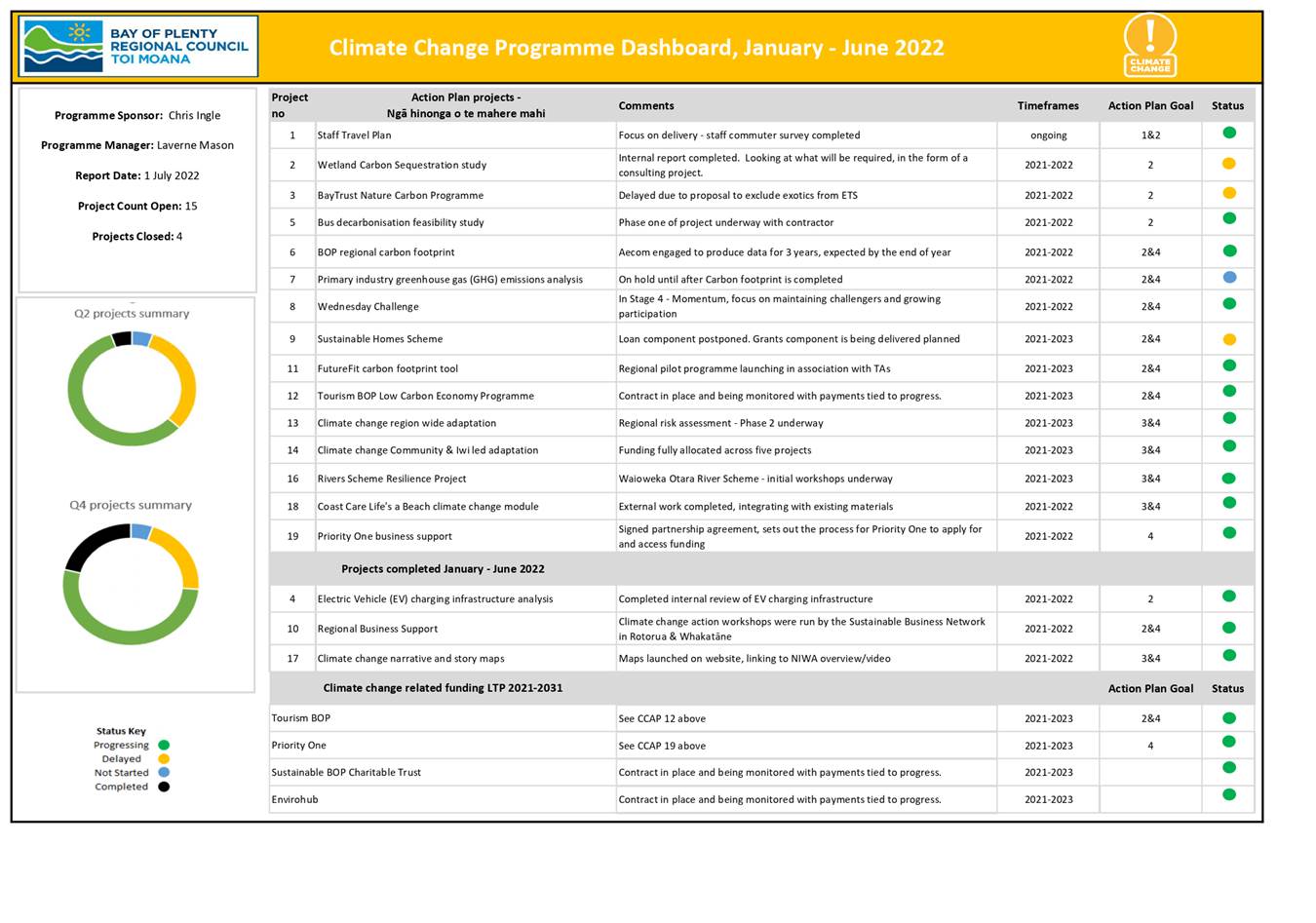
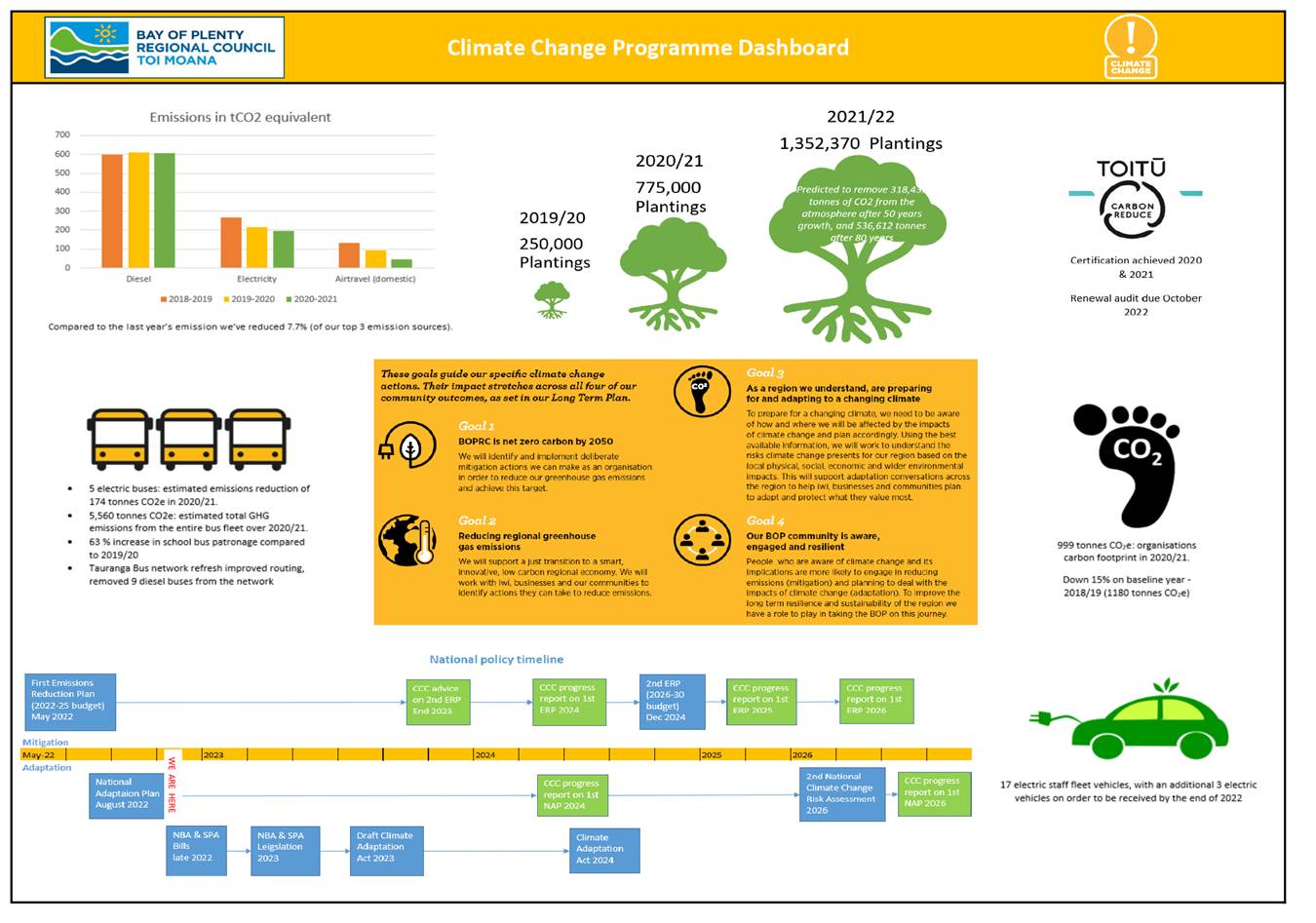
|
|

|
|
|
|
Report To:
|
Monitoring
and Operations Committee
|
|
Meeting
Date:
|
6
September 2022
|
|
Report
Writer:
|
Graeme Howard, Corporate Planning
Lead
|
|
Report Authoriser:
|
Chris
Ingle, General Manager, Integrated Catchments
|
|
Purpose:
|
Information on environmental
volunteering supported by Council in 2021/22.
|
|
|
|
Environmental
Volunteering supported by Council
|
Executive Summary
This paper provides a summary of environmental
volunteering supported by Council investment, including information on the
number of groups, individuals and volunteer hours that have been supported by
Council.
During 2021/22, Council continued to provide direct
financial and non-financial (Council staff time) support for environmental
volunteering in the Bay of Plenty through several programmes of work. Council
also provided increased funding through the Long Term Plan 2021-2031 to
support the capability and capacity of the environmental volunteering sector.
In 2021/22, 100 groups or projects were supported by
Council through the programmes covered in this report and collectively these
groups contributed over 80,745 volunteer hours during the year, equivalent to
43.9 FTEs.
Over this period Council invested $1.323 million to
support these volunteer groups and projects (excluding staff time) and to
help grow the sector’s capability and capacity.
Examples of the
work delivered by the volunteer groups that are supported, was provided in
the Council report ‘Summary of care group and environmental volunteer
activity 2021’ presented to this committee in March 2022.
A brief
presentation will be given by Bay Conservation Alliance (BCA) to illustrate
work they have been delivering to support the capability and capacity of
environmental volunteering in the Bay of Plenty.
|
Recommendations
That the Monitoring and Operations Committee:
1 Receives the report, Environmental Volunteering supported by Council.
1. Introduction
Environmental
focused volunteering provides a critical resource to help deliver environmental
protection and restoration work across the Bay of Plenty. This volunteering
activity supplements and augments the work undertaken by central and local
government organisations. Recognising this fact, Council has provided direct
and indirect support to enable and facilitate environmental volunteering
activity through a range of programmes over many years. Other organisations
including local and central government agencies and local Trusts and Charities
also provide considerable direct funding and indirect support to this sector.
Through its
Long Term Plan 2021-2031, Council identified Community Participation and
Constructive Partnerships as a priority area for Council to focus on and
increase its impact. Aligned to this priority, Council allocated an additional
$500,000 per annum to provide needed support to develop the capability and
capacity of the environmental volunteer sector in the Bay of
Plenty.
1.1 Alignment
with Strategic Framework
|
A Healthy Environment
|
We work
cohesively with volunteers and others, to sustainably manage and improve our
natural resources.
|
|
Freshwater for Life
|
We
collaborate with others to maintain and improve our water resource for future
generations.
|
|
Safe and Resilient Communities
|
|
|
A Vibrant Region
|
|
|
The Way We Work
|
We look
to partnerships for best outcomes.
|
Environmental
focused volunteering helps to deliver environmental protection and restoration
work across the Bay of Plenty. This volunteering activity supplements and
augments the work undertaken by central and local government organisations. It
directly contributes to Councils ‘A healthy Environment’ and
‘Freshwater for Life’ community outcomes and the environmental
wellbeing & also contributes to the social, cultural and economic wellbeing
of our community.
1.1.1 Community
Well-beings Assessment
|
Dominant Well-Beings Affected
|
|
þ Environmental
High -
Positive
|
¨ Cultural
Low -
Positive
|
þ Social
Medium
- Positive
|
¨ Economic
Low -
Positive
|
2. Environmental
Volunteering supported by Council
2.1 Definitions
and measures
Through Council’s
Community Participation Action Plan, one action identified for staff was to define key terms relating to volunteers, including the definition
of volunteers. Following the completion of this action, the following
definition and related measures have been confirmed and are used in this
report.
Definition
of environmental volunteer: A person who chooses to work voluntarily for the environmental
good of the community and is supported directly or indirectly by Bay of Plenty
Regional Council.
To enable the
monitoring of Councils involvement and impact on environmental volunteering in
the BOP, the following measures have been identified.
Measure 1: Number
of people who contributed time to environmental volunteering during the
financial year in groups supported by Council.
Measure
2: Number of
environmental volunteer hours invested during the financial year in groups
supported by Council.
Measure 3: Number of care or
catchment volunteer groups directly supported by Council during the financial
year.
These measures
are intended to provide a simple basis for measuring the environmental
volunteering supported by Council. They are not intended to cover volunteering
that is not directly supported by Council such as environmental volunteers supported
by NGOs funded by Council, DOC, other Councils or hapū/iwi.
2.2 Environmental
Volunteering directly supported by BOPRC
The table below
provides a summary of four key work areas that contribute to environmental
Volunteering and receive direct funding support from Council.
|
Measure
|
Catchment, Land & Estuary Care Groups
|
Coast Care
|
Environmental Enhancement Fund
|
Total
|
|
Measure
1: Number of people who
contributed time to environmental volunteering during the financial year in
groups supported by Council.
|
2,445
|
3,203
|
3,525
|
9,286
|
|
Measure 2: Number of environmental volunteer hours invested
during the financial year in groups supported by Council (also shown as FTEs).
|
62,703
(34.1 FTEs)
|
6,139
(3.3 FTEs)
|
11,903
(6.5 FTEs)
|
80,745
(43.9 FTEs)
|
|
Measure
3: Number of care or
catchment volunteer groups directly supported by Council during the financial
year.
|
78 (3 new groups)
|
1
|
n/a
|
79
|
3. Council
Programmes supporting Environmental Volunteering
The following
section provides a brief overview of the work areas in the above table. Further
detail, including examples of the work delivered by the volunteer groups, is
available in the Council report ‘Summary of care group and environmental
volunteer activity 2021 presented at the 8 March 2022 Monitoring and Operations Committee
meeting.
3.1 Catchment,
Land, & Estuary Care Groups
Land Care,
Estuary Care Groups typically focus on protecting or enhancing biodiversity or
amenity values at a site. Care groups interested in their local environment
approach Land Management staff with an idea. This idea is explored and
developed and if the proposal meets Council’s criteria, staff work with
the group to produce a care group plan. Work delivered may involve planting,
pest control, weed control, interpretation signage or ecological monitoring.
The groups have ownership of their projects – they are not Council
projects. Council staff provide technical support, advice and funding for
materials to be utilised by the group.
In recent years
Council has also supported the formation and running of catchment groups. They
are groups of landowners whose properties lie within a catchment where one or
more water quality attributes are failing to provide for the ecological,
cultural or community use values. Catchment groups are supported by Council,
but also by other agencies such as MPI, MfE, Fonterra and NGOs such as NZ
Landcare Trust.
3.1.1 Volunteering
2021/22
The table below
summarises the location of groups across the region together with the number of
volunteers and volunteer hours contributed over the year.
|
Land, Estuary and Catchment Care Groups
|
|
District
|
Number of Groups
|
Number of Volunteers
|
Volunteer hours
|
Equivalent FTE
|
|
Rotorua
|
11
|
495
|
4088
|
2.22
|
|
Rotorua and Western BOP
|
2
|
218
|
5293
|
2.88
|
|
Western Bay of Plenty
|
36
|
1031
|
33,756
|
18.35
|
|
Tauranga City
|
9
|
204
|
4303
|
1.33
|
|
Ōpōtiki
|
8
|
229
|
2664
|
1.45
|
|
Ōpōtiki & Whakatāne
|
1
|
45
|
1318
|
0.72
|
|
Whakatāne
|
11
|
336
|
11,281
|
6.13
|
|
Total
|
78
|
2558
|
62,703
|
34.08
|
A list of the
78 Care groups is included as Appendix 1.
Three new care
groups were established during 2021/22 and either have a care group plan in
place or are working with LMOs to set one in place, these were:
· Matatā Conservation Estate
· Pheasant Lane Environmental Care Group
· Raukorore Church Restoration Project
3.2 Coast
Care
Coast Care is a
coastal restoration programme, run in close partnership with local communities,
local authorities, care groups and schools, that aims to restore and protect
the sand dunes along our Bay of Plenty beaches.
The Coast Care
Bay of Plenty programme began in 1994 as a partnership between coastal
volunteers and the agencies with an interest in coastal management. Regional
Council delivers the programme on behalf of the funding partner agencies, which
include Tauranga, Western Bay of Plenty, Whakatāne and Ōpōtiki
District Councils and the Department of Conservation.
3.2.1 Volunteering
2021/22
The table below
summarises the location of groups across the region together with the number of
volunteers and volunteer hours contributed over the year.
|
Coast Care
|
|
District
|
Number of Groups
|
Number of Volunteers
|
Volunteer hours
|
Equivalent FTE
|
|
Region Wide
|
1
|
3,203
|
6,139
|
3.3
|
The majority of
environmental volunteering through the Coast Care Programme is delivered via
our schools programme and corporate or public planting days.
3.3 Environmental
Enhancement Fund
The
Environmental Enhancement Fund (EEF) provides funding for community-based
projects that; improve the environment, raise environmental awareness and use
the enthusiasm and skills of the community.
He Matapuna
Akoranga a Hawea Vercoe - Hawea Vercoe Memorial Fund grants are also funded
through the EEF to help Kura Kaupapa Māori, Kohanga Reo and bi-lingual
schools in the region with environmental projects.
3.3.1 Volunteering
2021/22
Environmental Enhancement
Fund grant funding of up to $300,000 is available each year. It is allocated on
a first come first served based for eligible projects. The table below provides
a summary of the funding allocated, number of projects supported and volunteer
hours contributed.
The budget of
$300,000 was slightly overallocated in 2021/22. This was due to a review of the
EEF reserve balance against commitments which identified additional budget capacity
due to some older projects not requiring funds that had been committed. EEF
projects may take up to three years to complete once approved and funding
allocated.
In 2019/20 and
2020/21 the EEF was under subscribed. This is due in part to COVID-19 having a
negative impact on applicants’ ability to organise and deliver community
based projects. In 2021/22 the EEF was fully allocated and indications are that
2022/23 will also be fully allocated with applications for over $340,000
received (as at 15 August 2022) and currently being assessed. The reduction of
COVID-19 related restrictions on community activity together with Councils increased
promotion of and focus on volunteering have contributed to this increase in
applications.
A list of the
individual projects funded each year is updated regularly on Councils website
at: https://www.boprc.govt.nz/living-in-the-bay/community-funding/environmental-enhancement-fund.
3.4 Supporting
Volunteer Capability and Capacity
Though the Long Term Plan 2021-2031 Council allocated an
additional $500,000 per annum to provide support to develop the capability and
capacity of the environmental volunteer sector in the Bay of Plenty. The table
and information below provides a summary on the allocation of this funding.
|
Volunteer Capability and Capacity - Additional funding LTP 2021-2031
|
|
Funding programmes
|
Allocated via LTP 2021/22
|
Spent or committed in 2021/22
|
|
Additional funding for Care Groups
|
$215,000
|
$215,000
|
|
Funding for Volunteer Sector Capability
and Capacity
· Bay Conservation Alliance
· NZ Landcare Trust
· Envirohub
|
$85,000
$100,000
$100,000
|
$85,000
$100,000
$100,000
|
|
Total
|
$500,000
|
$500,000
|
Additional funding for Care Groups
$215,000 per annum was allocated to support care
groups through the Long Term Plan. In 2021/22 the full $215,000 was allocated but
it was slightly underspent during the year with the remaining funding rolling over
to the current year. A NZ wide shortage of traps meant some orders could not be
filled in a timely manner. Volunteer hours supported by this funding are
included under section 3.1 (Land, Estuary and Catchment Care) above.
Volunteer Sector
Capability and Capacity
Council confirmed funding of $285,000 per annum for
three groups through LTP 2021-2031 deliberations. This funding provides
professional support and training to enable the environmental volunteer sector organisations
to operate effectively and to grow the sector. Funding agreements are in place
all three organisations.
· Bay
Conservation Alliance (BCA) - funding for professional operational support.
This includes field, planning and administrative support to BCA member groups
across the region, growing the number of BOP Care Groups supported by BCA and
training to build capability of volunteers.
· NZ
Landcare Trust - funding to provide coordination support to existing catchment
groups (unless the group already has a funded coordinator) across the region, to grow the number of Care Groups and facilitate training to
build capability of volunteers.
Due to delays in
recruiting staff, progress by Landcare Trust against deliverables in their funding
agreement was delayed. As a result, only $25,000 of the committed budget was
paid with the remaining $75,000 held in reserve until milestones are met.
Landcare Trust successfully recruited in early 2022.
· Envirohub
– funding to deliver a suite of programmes and initiatives that raise
awareness and promote individual action around climate change, biodiversity,
pollution and resilience. These programmes engage with individuals and
organisations throughout the Bay of Plenty and act as a catalyst for change to
help tackle climate change and promote regeneration of our natural environment.
4. Council
investment supporting Environmental volunteering
The table below summarises the direct funding that has
been spent or committed in 2021/22 to support environmental volunteering.
|
Council funding directly supporting
Environmental Volunteering
|
|
Work programmes
|
Actual and committed Spend 2021/22
|
Volunteer hours
|
|
Catchments – Coastal and Rotorua
Lakes
|
$253,001
|
62,703
|
|
LTP 2021-2031 additional funding for Care
Groups
|
$215,000
|
|
Coast Care
|
$246,662
|
6139
|
|
Environmental Enhancement Fund
|
$322,838
|
11903
|
|
LTP 2021-2031 funding for Volunteer
Sector Capability and Capacity
|
$285,000
|
N/A
|
|
Total
|
$1,322,501
|
80,745
|
During 2021/22, Council invested $1.323 million to
directly support these volunteer groups and to help grow the sectors capability
and capacity. This excludes staff time
Note: 2021/22 financial
information is still draft until the Annual report is finalised.
5. Considerations
5.1 Climate
Change
The work of
volunteers often has a positive impact on the mitigation of climate change
emissions, for example through control of pest animals at a biodiversity site,
or restoring an area with native tree or wetland planting.
5.2 Implications
for Māori
Iwi and hapū are
often supporters of the work of care groups and other environmental projects
and are often engaged in the projects in some way. Iwi are key partners in some
of the larger projects. Māori are also involved in some of the farmer-led
catchment groups and also regularly access EEF funding.
The environmental
enhancement work achieved by care groups has positive implications for
Māori, as for the public generally.
5.3 Community
Engagement
|

|
EMPOWER
Whakamanahia
|
To place final decision-making in the hands of
affected communities.
|
Environmental volunteering projects whether delivered
through Care Groups or via EEF is very much led and driven by the community.
Ensuring this continues and that appropriate support advice and training is
delivered or facilitated by Council, helps to ensure that a high level of
engagement and independence is maintained.
5.4 Financial
Implications
There are no
material unbudgeted financial implications related to this work and this fits
within the existing allocated budget.
6. Next
Steps
Staff will keep a watching brief in regard to total
environmental funding available to communities (council, government, other) as
it may impact on the demand for council funding. Staff will also continue to
monitor the measures outlined in this report with the intention to report
annually to the Committee.
Attachments
Attachment 1 - Land Estuary and Catchment Care Groups supported by
Council 2021-22 ⇩
Monitoring
and Operations Committee 6 September 2022
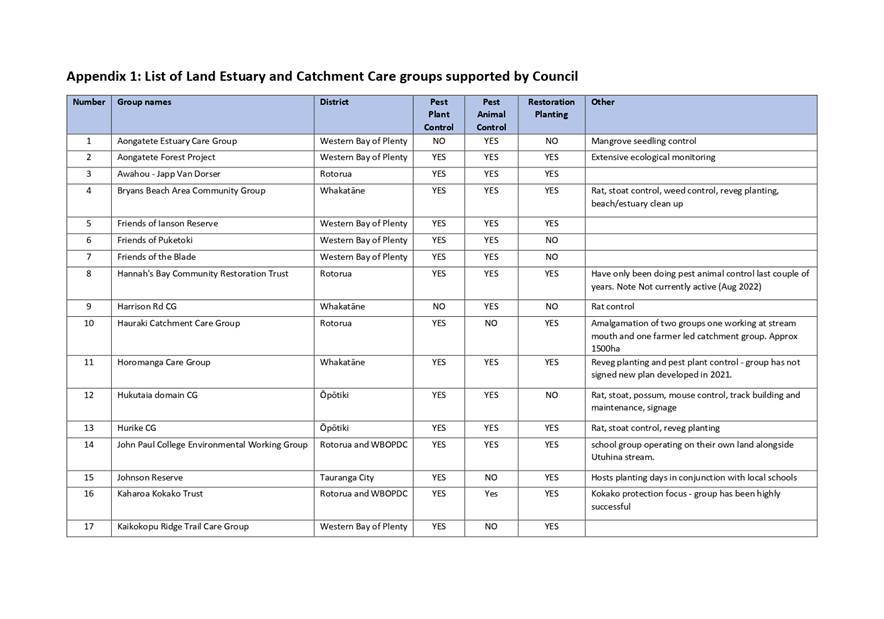
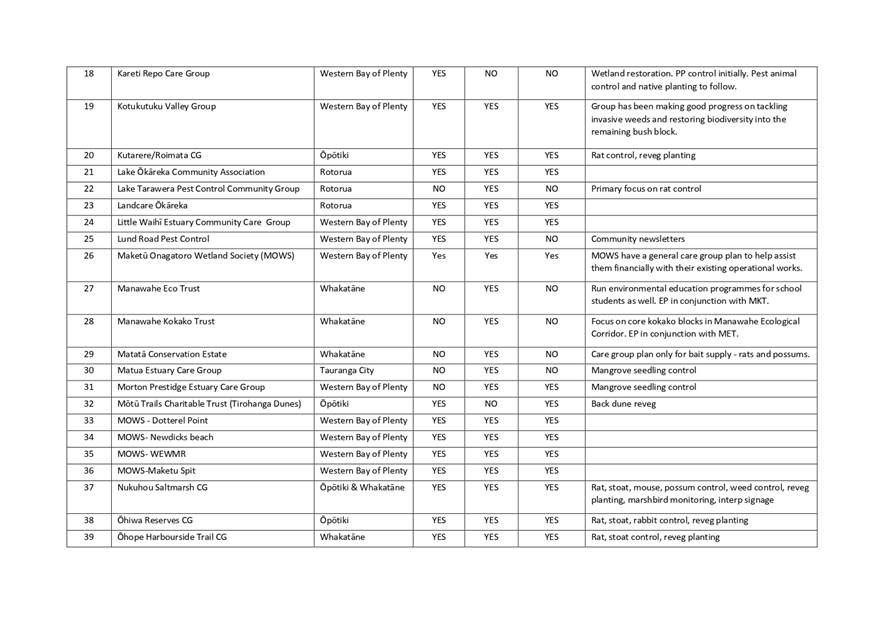
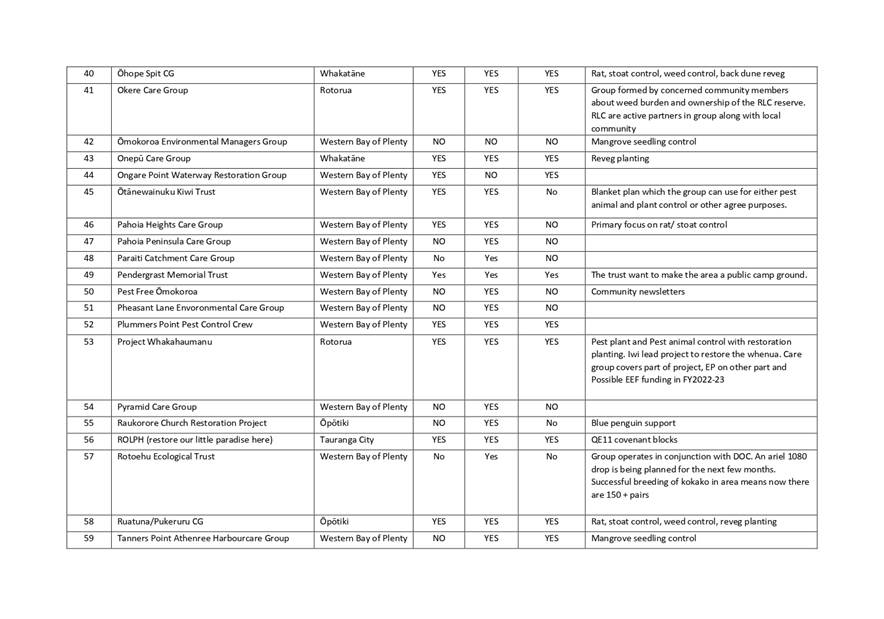
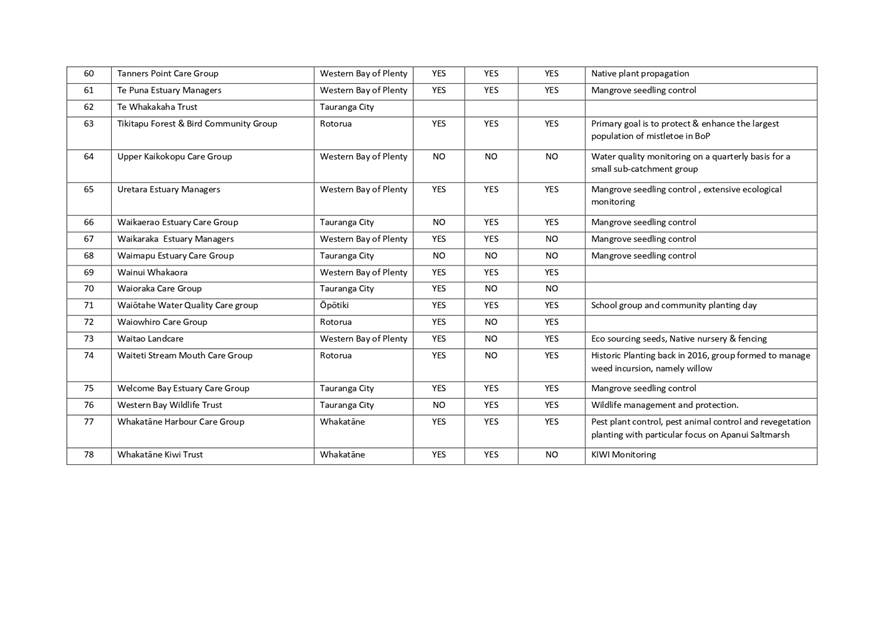
|
|

|
|
|
|
Report To:
|
Monitoring
and Operations Committee
|
|
Meeting
Date:
|
6
September 2022
|
|
Report
Writer:
|
Rachael Burgess, Customer Contact
Manager
|
|
Report
Authoriser:
|
Mat
Taylor, General Manager, Corporate
|
|
Purpose:
|
To update the committee on customer
service performance
|
|
|
|
Customer
Service Performance
|
Executive Summary
Considerable operational
changes have been made over the past four years to improve the way we engage
with our customers in terms of the technology we use, the processes we follow
and the functionality of our public interfaces. These initiatives are
resulting in an improved service and are having a positive impact on customer
satisfaction levels. They also support our readiness for collecting our own
rates payments as part of the rates transition project.
Improving the customer
experience has been highlighted as a significant focus for the Rates
transition project and to achieve this outcome we have worked to understand
our different customer groups and their service expectations. Our technology
solutions and payment options have been further enhanced to ensure the
transition to collecting our own rates is as seamless as possible, and
results in a positive customer experience for ratepayers.
|
Recommendations
That the Monitoring and Operations Committee:
1 Receives the report, Customer Service Performance.
1. Introduction
A series of initiatives included
in the Customer First work programme that commenced in early 2019, have ensured
that we now have fit-for-purpose systems and streamlined processes in place to
support an improved service delivery. The improvements include more
comprehensive data reporting metrics and customer feedback surveys that measure
the quality of customer service being provided. By analysing this data, we can
gain an insight into where further improvements can be made.
Extensive research has been
carried out to ensure the most customer-centric, effective, and efficient
in-house rates collection function, to comply with legislation, and to
communicate this change to ratepayers.
From the research we have
conducted with other councils, our customer service delivery model is well set
up to be able to support the new rates team with queries and payments. A
detailed communications plan has been developed to inform ratepayers of the
change as well as promoting the various payment methods available. In
preparation for invoices going out, we have scaled up our resources to respond
to expected peaks in customer enquiries and interactions.
1.1 Alignment with Strategic
Framework
|
The Way We Work
|
We
provide great customer service.
|
|
|
We
deliver value to our ratepayers and our customers
|
|
|
We
continually seek opportunities to innovate and improve
|
2. Customer Service Performance
2.1 Customer Contact Centre
Highlights
In the 12
months ending 31 July 2022, approximately 64,500 customer queries were received
across our six customer service channels. For queries that require a response,
service tickets are generated in Zendesk, our customer relationship management
system (CRM).
There were just
over 70,000 Zendesk service tickets generated and resolved during this 12-month
period. This is 15,000 more queries than were received during the previous
reporting period ending 31 January 2022. While queries to many of our business
activity areas have reduced over the past year, this increase can be attributed
to the rates-related queries that have been received since the rates
communication campaign was launched in April 2022. Over the last four months,
we have received more than 7,000 rates-related queries and processed over
20,000 direct debit sign up requests.
|
Phone
|
Reception
|
Email
|
Web Query
|
Social Media
|
Antenno
|
Total Queries
|
Zendesk Service Tickets
|
|
42,506
66%
|
10,027
15.5%
|
10,411
16%
|
1,317
2%
|
184
0.3%
|
135
0.2%
|
64,580
|
71,037
|
2.1.1 Call Volumes
Calls remain
the most popular method of contact with 42,500 calls received during the 12
months ending 31 July 2022. While this is a 2.6% decrease in calls compared to
the previous reporting period ending 31 January 2022, the increase in
rates-related calls since April 2022 has resulted in call volumes starting to
trend upwards.
Volume of calls received from July 2021 to July 2022
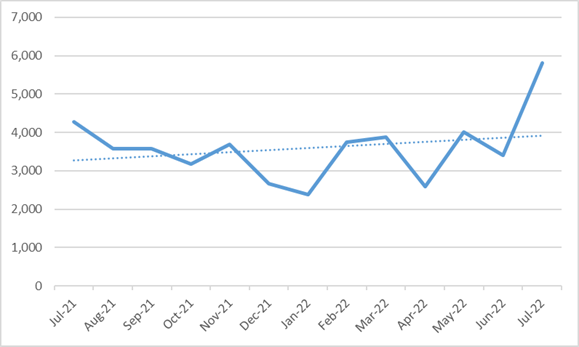
Towards the end
of July, letters and emails were sent to 42,000 ratepayers who had a direct
debit arrangement in place with their local territorial authority, encouraging
them to set up a direct debit with Bay of Plenty Regional Council. This caused
an influx in calls to the call centre during the last two weeks of July 2022
with 3,200 rates-related calls received as a result of this mail-out.
We are also
monitoring other events such as media releases, BOPRC mail-outs and the
different phases of our communications campaign to measure the impact these
have on our customer service channels. This monitoring helps us to understand
the effectiveness of the different ways we are sharing information with the
community, and it also helps us to ensure we have adequate resourcing in place
to respond to increases in customer queries.
Rates-related
queries have remained steady over the past four weeks with around 150 daily
calls. The peak number of calls to date has been 400 per day. Rates-related
calls currently make up half of all calls received into the call centre.
Rates calls received during July and August 2022

2.1.2 Call Categories
There are five
separate phone lines that are managed by the call centre. These include the
BOPRC general query phone line, the Baybus phone line, the pollution hotline,
the 0800 5KNOTS maritime line and a new rates phone line that was introduced in
April when the rates communication campaign was launched.
Having a
dedicated rates phone line allows the team to better manage the calls coming
into the call centre as the rates team can join the call answering during busy
periods. It also provides better visibility of rates call patterns for
reporting purposes and it means that specific rates messaging can be used while
callers are waiting for their call to be answered.
The following
graph shows the volume of calls received to each of these phone lines for the
12 months ending 31 July 2022.
Phone
Line Statistics from July 2021 to July 2022
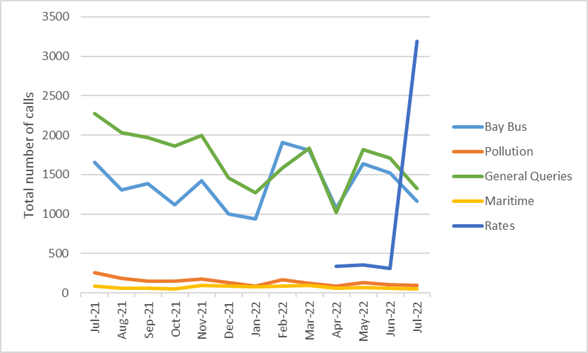
Baybus calls
fluctuate between 1,000 and 2,000 calls each month and totalled 16,000 calls
for the 12-month reporting period. Call data shows Baybus calls have been
decreasing since May 2022 as people have adjusted to the weekend timetable that
is currently in place. Maritime calls have remained consistent with
approximately 800 calls received over 12 months. General queries have reduced
by 3,800 calls in the 12-month period ending 31 July 2022. The reduction in
general calls isn’t attributed to a specific business activity, all call
categories have reduced when compared to the previous reporting period.
When looking at
monthly call volumes, April saw a significant drop in calls across the four
existing phone lines. This is consistent with call patterns for the Christmas
holiday break where calls reduced while people took leave over Easter. The
rates communication campaign went live in April and initially the call centre
received approximately 150 rates-related calls per day. The graph shows these
calls then increase significantly in July after the direct debit letters were
sent to ratepayers. A total of 5,800 rates calls have been received since April.
Calls to the
pollution prevention hotline have reduced by 40% over the last 12 months. There
is a noticeable reduction in calls from August last year when the compliance
team introduced a proactive media campaign to raise awareness around issues
that commonly occur during certain times of the year. A combination of regular
social media posts as well as leaflet drops were used to communicate pollution
related issues in the community, and this has resulted in less pollution
hotline calls and complaints being received.
2.1.3 Call Abandonment
Abandoned calls
are disconnected before the customer can connect with a staff member. A call
may be abandoned for many reasons, including the wait time in the queue, a
connection error or a distraction meaning the customer is no longer available
to make the call. The service level measure for call abandonment is based on
the percentage of calls that are able to be answered each month. The service
levels are monitored as these provide an insight into the impact that peak call
periods have on call centre operations and where staff scheduling might need to
be adjusted to meet the demand during certain times of the day.
Call
abandonment was low during May and June with the call centre answering 96% of
calls. This has dropped to 84% of calls being answered during July when we were
receiving larger volumes of rates related queries. Our telephony system offers
a call back service which enables customers to retain their place in the queue
and have a customer service advisor call them as soon as they are available
rather than having to wait on the line. Feedback from our customers has been
extremely positive about the call back service.
A total of
5,800 rates related calls have been received through the dedicated rates phone
line over a four-month period. 60% of these calls have been answered and
resolved by the call centre immediately, 27% have requested a call back, and
12% have been abandoned. Call patterns show that rates calls are particularly
heavy on Mondays between 10am and 2pm so this is helping to inform when emailed
invoices will be released and what level of staff resourcing is needed at the
beginning of the week.
Call Answer Service Level
from July 2021 to July 2022
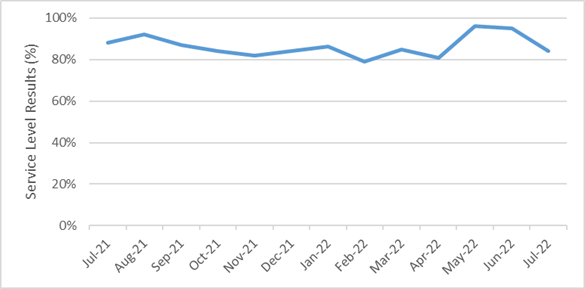
2.1.4 Call Resolution
The Customer Contact Centre has
a Key Performance Indicator (KPI) to resolve 97% of calls at the first point of
contact. While call resolution has been around 95% in recent months, the KPI
target was exceeded in July 2022, achieving a call resolution rate of 98%. With
the introduction of the new rates service and the high volume of calls received
in July, this achievement demonstrates that the systems and processes put in
place to support the new rates collection service have been effective. The average call handing time for rates calls is between 3 – 5
minutes, and this reflects that most enquiries are
being dealt with at the first point of contact.
Call Resolution Service Level
from July 2021 to July 2022
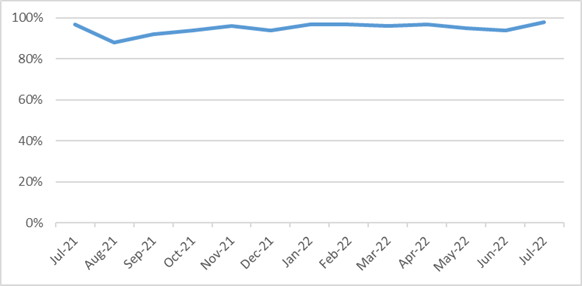
2.1.5 Visitor Numbers
Just over
10,000 people visited our offices in the 12 months ending 31 July 2022. This is
a 24% decrease compared to the previous reporting period ending 31 January
2022, when 12,400 people visited our offices. This significant reduction in
visitors is consistent across all offices with 370 less visitors in
Whakatāne, 660 less visitors in Rotorua and 500 less visitors in Tauranga
during the 12-month period.
Bee Card
queries remain the most common reason for people visiting our office sites,
particularly in our Tauranga and Rotorua offices where approximately 60% of
people visit our offices to obtain a bee cards or top-up.
Visitor
numbers per site from July 2021 to July 2022
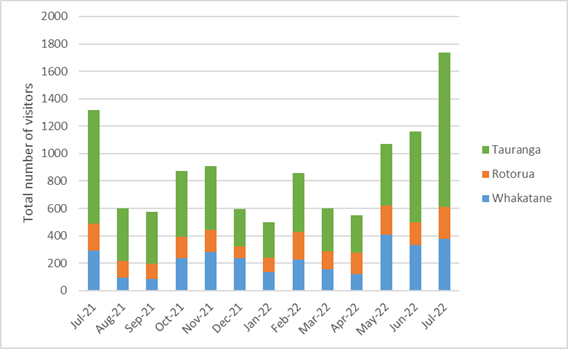
When looking at
the monthly trends, visitor numbers were also low in April due to the Easter
break. Visitor numbers increased again in May when we started to receive rates
queries at our service centres.
A total of
1,500 rates customers have visited our offices - 53% of these were in Tauranga,
27% in Rotorua and 20% in Whakatāne. Many of these people have requested
assistance in setting up their direct debit payment so our customer service
agents have been able to show people through this process using the online form
at one of the two customer service kiosks we have located at each of our
offices.
In person rates queries during July and August 2022
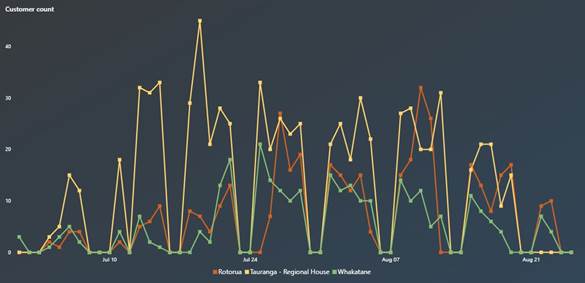
The customer
kiosks allow people visiting our service centres to access the services we
provide on our website or over the phone such as topping up their Bee Card,
accessing their rates details and visiting the Baybus website for bus route
information. The kiosks enable customers to familiarise themselves with how to
find the information they need to solve their query, with a customer service
agent on hand if they need assistance. The key benefit of the customer kiosks
is that customers can then complete the process themselves once they get home,
without needing to travel into our offices each time they need to top up their
Bee card for example.
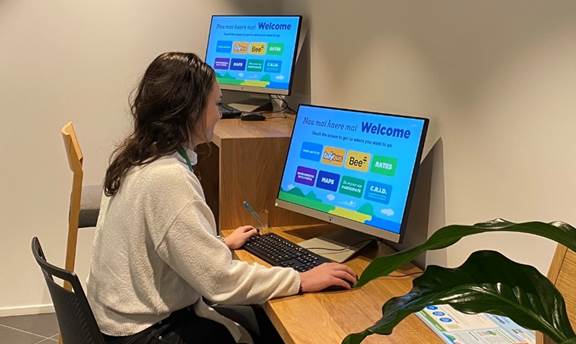
There are two customer service kiosks available
for use in all three office locations.
2.2 Customer Satisfaction
Feedback
Our Customer
Relationship Management (CRM) system provides the ability to develop customer
satisfaction measures that enable customer service performance management and
monitoring across a variety of different customer service touchpoints. This includes
comprehensive data reporting to help us better understand our customers and
their needs, as well as customer satisfaction surveys that provide valuable
feedback in regard to the quality of our service.
Customer
Satisfaction surveys are sent to customers who contact us by email or provide
their email address over the phone. The survey is voluntary, so only a very
small proportion of people reply. For example, we are currently receiving
responses from only 4% of our pollution hotline callers who are sent a survey.
We are looking at ways that we can improve this response rate so we can obtain
more feedback from customers.
From August
2021 to July 2022, a total of 43,100 surveys were sent to customers, with 2,623
responses received. This is an overall response rate of 6%, up from 3.5% during
the last reporting period ending 31 January 2022. Collecting this data
over a 12-month period has enabled us to analyse the trends that emerge during
times where there are issues arising in the community. We can then focus extra
attention on these services areas to ensure the contact centre have the correct
information they need to respond to queries and that response timeframes are
reasonable.
Recent customer
satisfaction results show that satisfaction levels have improved by 11% across
all categories. The general call line experienced a minor reduction, dropping
by 1%. Customer Satisfaction for rates calls during the first four months were
well received at 79%.
Customer
Satisfaction Survey Results from August 2021 to July 2022
|
CALL CATEGORY
|
No. of Responses
|
 
|
 
|
Change from Jan 22
|
|
General Call Queries
|
1542
|
76%
|
24%
|
-1
|
|
Rates Calls
|
436
|
79%
|
21%
|
NA
|
|
Baybus Calls
|
357
|
65%
|
35%
|
+4
|
|
Consents Calls
|
168
|
85%
|
21%
|
+4
|
|
Pollution Hotline
|
46
|
66%
|
34%
|
+2
|
|
Maritime 0800 5 KNOTS
|
74
|
76%
|
24%
|
+2
|
The comments that are extracted from survey data are also
valuable as they provide further opportunities to improve our service delivery
both internally and externally. We receive a wide range of both positive and
negative feedback, and these are recorded and shared
with the respective team activity areas, to ensure that reoccurring issues are
followed up as quickly as possible.
2.2.1 Mystery Shopper Survey Results
Mystery Shopper surveys are
carried out monthly and include a series of calls to each of our call lines as
well as visits to our reception counters when Covid restrictions allow. Call
quality is measured in terms of the service provided, the knowledge and
understanding of the issue and whether the mystery caller was satisfied with
the response. On-site visits also include the office surroundings and customer
interaction aspects of the service being provided in person.
The following table provides an
overview of the mystery shopping results for both calls and site visits. Since
December last year, satisfaction results over 93% have been achieved for calls
managed by our internal call centre. Survey results are slightly lower for our
after-hours call service which dropped below 80% in July 2022. We currently
receive very few rates calls after hours; however, we are providing additional
support to our external call service provider as we approach the release of
rates invoices to ensure they have the information they need to resolve our
non-technical rates queries.
Mystery Shopper survey
satisfaction results from July 2021 to July 2022
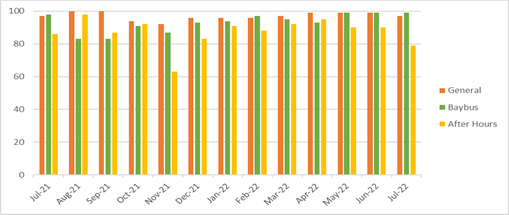
2.2.2 ALGIM Customer Experience Survey
Results
Each year the Association of
Local Government Information Management (ALGIM) carry out their own Customer
Experience Mystery Shop survey across all councils in New Zealand. The survey
provides a snapshot of the local government sector with guidance on where
councils can improve their customer service delivery. In 2021, a total of 78
councils were surveyed and ranked in terms of their survey results.
At the recent ALGIM awards held
in Wellington in June 2022, Bay of Plenty Regional Council was announced runner
up for the 2021 Customer Experience Award, behind Ashburton District Council.
Bay of Plenty Regional Council received an overall score of 88%, 3 points
behind the winning council. In 2018, Bay of Plenty Regional Council was ranked
64th out of 80 councils.
Of the 78 councils surveyed,
only 18 were classed as having an excellent customer service experience.
ALGIM Customer Experience
Results 2021 – All Councils by Ranking
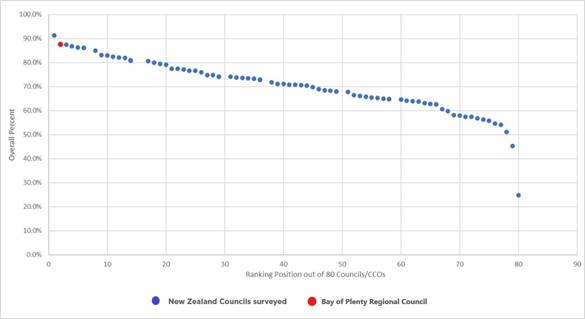
2.3 Rates Customer Experience
Progress has been made in
preparation for delivering a customer-centric rates collection service with our
customer service delivery model now well set up to be able to support the new
rates team with queries and payments. The key focus for the rates project has
been ensuring that the customer experience is positive and as seamless as
possible.
To prepare for the new service
over the last six months we have made improvements to our technology systems
and payment processes to ensure they are robust and responsive to the needs of
our rates customers. The Customer Services team has also increased the number
of fixed term and permanent resourcing in readiness for the increase in
enquiries we expect to have once customers receive their invoices.
2.3.1 Direct Debit Uptake
On the 25 July, letters and emails were sent to 42,000 ratepayers who had a direct
debit arrangement in place with their local territorial authority, encouraging
them to set up a direct debit with Bay of Plenty Regional Council. Extensive
communication campaigns were also carried out to promote the benefits of direct
debit payment plans which enable people to smooth their payments over
the year to avoid penalties for any remaining balance outstanding on the
instalment due date.
Over the past
month, approximately 20,000 ratepayers have set up a direct debit. This is around
half of the number of direct debits that the TAs have across the region. Over
the next four weeks 148,000 assessments and invoices will be sent to
ratepayers, 107,000 of these are by post and 41,000 by email. It is expected
that this will result in additional people setting up direct debits.
2.3.2 Rates Payment Options
The Bay of Plenty Regional
Council has approximately 148,000 ratepayers. Many of these people live in
urban areas where payment and internet facilities are easily accessible, and
others live in isolated communities where access to payment facilities and
internet coverage is limited. To ensure the Rates Transition Project is
successful, we have ensured that our services cater to people of all ages,
cultures and digital literacy.
We have worked to increase our
understanding around the level of digital exclusion in our communities so that
we can offer alternative options to these customers. This includes promoting
the various payment methods available, including the benefits of direct debit
payment plans to enable people to smooth their payments over the year and the
option to pay weekly, fortnightly, monthly or annually.
NZ Post will be used as a
payment agency to meet the needs of customers who choose to pay their rates
over the counter, and to provide broad coverage across the region for this
payment option. We are also offering extensive online services and the
opportunity to pay in person at one of our three office locations.
2.3.3 External Agency and TLA Engagement
In recent months we have engaged
with several social service organisations in the community to improve our
understanding of the barriers that exist in certain parts of society.
Particularly where affordability may be a factor in preventing some people from
paying their rates. This engagement has included budget advisory agencies,
citizens advice bureaus, grey power and age concern groups who were asked to
respond to a survey in order to provide an insight into what payment options
might work best for these people and how we can improve our communication with
them. A total of 25 survey responses were submitted and this information is
being used to help inform payment options and payment support. Leaflets are
also being provided to the social service providers that requested them,
widening our support network of external agencies that can help our customers
through this transition. Targeted advertising is also being used to inform
‘hard-to-reach’ audiences.
Monthly TLA meetings have
occurred since March 2022 to ensure that the city and district council staff
stay informed. A good flow of information exists between the TLA customer
service centres and the Bay of Plenty Regional Council to ensure their customer
service teams have the resources they need to assist customers and that they
can access our internal call centre for additional support.
TLA support also includes the
production of customised leaflets and display stands directing ratepayers where
to pay their regional council rates locally. An iPad has also been temporarily
loaned to the Kawarau council to support their Customer Services team to
answering customer queries.
2.3.4 Website
From May to August there has
been a 200% increase in website traffic compared to the same period as last
year and 40% of total website use is based on visits to the rates-related
pages. During this time, the top ten pages on the rates ‘Information
Hub’ have received 225,000 views. The most frequently visited rates page
is the property search page which contains the Rating Information Database.
This is followed closely by the rates homepage and the direct debit information
page. The new Information Hub with key rates related FAQs has proven to be
highly popular and is likely to have reduced the number of enquiries coming
through to the Customer Services team.
Top Ten Rates Webpages viewed
from May to August 2022
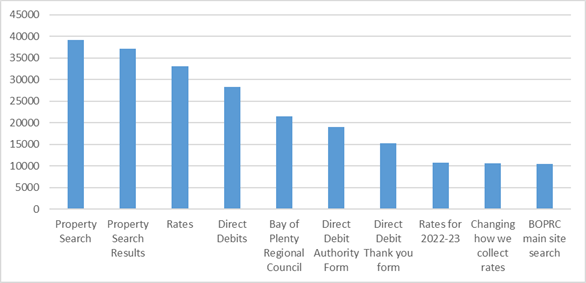
All advertising directs people
to the rates section of website and based on analytics has been successful in
driving website traffic. 75% of website visitors who entered on the rates
landing page, then go on to look at other pages on the website, increasing the
visibility of the work that Council does.
3. Considerations
3.1 Risks and Mitigations
There is a risk that the
increased volume of customer enquiries in relation to the new rates service are
much higher than expected once the invoices are received, meaning call response
rates drop leading to customer dissatisfaction. This could also result in
urgent services such as pollution hotline notifications and maritime emergency
calls are stuck in a queue rather than being answered quickly. This situation can
be mitigated easily through monitoring of the separate phone lines and placing
a priority queue response on the pollution and maritime phone lines. Additional
resources are in place to respond to larger call volumes during the rates
invoicing period with an option to scale up with more temporary resources if
necessary.
3.2 Climate Change
Anything we can do to reduce
carbon emissions is important, no matter how small, and that includes how we
engage with our customers through our various customer service channels. We
have four separate service channels available that provide an opportunity for
our customers to connect with us digitally. This is important as recent
customer service data shows a growing trend in people wanting to access
customer services and process their bill payments online.
Our customers are able to access
answers to many frequently asked questions through our website or send us a
request by email or via social media. We also use the Antenno app which helps
ensure members of our community are informed about issues affecting their area
and enables another channel to log requests. In addition to this our customers
can call us 24/7 and speak to a call centre agent. As part of the rates project
planning, it was important that our customers are able to pay their rates
locally as this reduces the need for people to travel into one of our offices
as this contributes to a reduction in travel emissions.
3.3 Implications for Māori
The Bay of
Plenty region is growing and changing, and this is reflected in our
increasingly diverse population. Embracing cultural differences in customer service
empowers our people to better predict and accommodate the needs of their
customers, as well as connecting with them on a more meaningful and human
level. Our customer service model is designed to provide inclusive and
accessible customer service that all our customers can use and benefit from.
Our staff training focusses on the need to be flexible, patient and empathetic
to ensure that our customers have a positive customer experience.
Throughout the
rates project planning, considerable effort has been made to ensure our rates
messaging is reaching Māori in our community. 390
emails were sent out to key mana whenua partners to introduce Council’s
new Māori Land Rates Specialist. Responses from 35 organisations have been
received, requesting further information with several large Hui set up in the
coming weeks.
3.4 Financial Implications
There are no
material unbudgeted financial implications and this fits within the allocated
budget.
4. Next Steps
4.1.1 2023 Residents Survey
In 2018, a benchmark study was
carried out to build a representative and holistic view of Council’s
performance. The survey helped Council to identify opportunities for
operational improvement and it heavily influenced the 2019-2020 customer service
improvements and communications campaigns. In 2020, the residents survey was
completed a second time to assess how well Council was performing in relation
to the community’s expectations and perceptions, against the 2018
benchmark survey.
The 2020 survey concluded that
resident’ perceptions of Regional Council’s performance remained
consistent with 50% satisfied residents in 2018, and 51% in 2020. Satisfaction
with Regional Council’s overall reputation increased from 51% to 55% and
residents who had contact with Council were more likely to be satisfied with
Council’s performance across key measures than those who had not
contacted Regional Council. In 2018, the survey findings found that residents
who had contact with Council were likely to be dissatisfied with the main
service attributes.
One of the key drivers behind
Regional Council moving to collect its own rates is to raise its profile and be
more transparent and accountable for the work they do for the community. We are
therefore planning to carry out the Residents Survey for the third time in
February next year, to measure the impact of the rates collection change on
customer satisfaction, public awareness and councils’ reputation. By
gaining a better understanding of what the community knows about Council’s
services, this information can further inform our communications, customer
service, and community engagement work.
|
|

|
|
|
|
Report To:
|
Monitoring
and Operations Committee
|
|
Meeting
Date:
|
6
September 2022
|
|
Report
Writer:
|
Bruce Crabbe, Rivers and Drainage
Operations Manager
|
|
Report
Authoriser:
|
Chris
Ingle, General Manager, Integrated Catchments
|
|
Purpose:
|
|
|
|
|
Environmental
Code of Practice for Rivers & Drainage Maintenance Activities - 2022 Annual
Review
|
Executive Summary
Rivers
and drainage scheme routine operational works are generally authorised by
permitted activity under the Regional Natural Resources Plan,
subject to a range of conditions including that works are carried out in
accordance with the Environmental Code of Practice for Rivers and Drainage
Maintenance Activities.
One
of the requirements of the Code of Practice is to report annually to Council.
This report covers rivers and drainage maintenance activities for the
2021-2022 financial year.
Overall,
958 separate rivers and drainage maintenance activities were carried out
during the 2021-2022 financial year, and 20 complaints were received and
investigated (see attachment 3).
55
Hapū and Iwi Management Plans are currently in existence and these guide
and inform operations activities and consultation.
|
Recommendations
That the Monitoring and Operations Committee:
1
Receives the report, Environmental Code of
Practice for Rivers & Drainage Maintenance Activities - 2022 Annual Review.
1. Introduction
The Environmental Code of
Practice 2019 (ECoP) covers maintenance activities undertaken by the Rivers and
Drainage Operations Section of Bay of Plenty Regional Council (BOPRC), on the
major river schemes and drainage control schemes in the Bay of Plenty region.
The purpose of the ECoP is to
set out operational procedures that will apply to all maintenance activities on
major rivers and drainage schemes, regardless of whether an activity requires a
consent or not.
Section 6.2.6 of the ECoP
requires an annual report, covering the following:
· Number
of complaints and corrective action(s) taken
· Summary
of recommended changes to procedures resulting from comments made in checklists
· Analysis
of types of work carried out, and any areas where complaints or problems
continue to occur
· Recommendation
whether an independent audit is required
· Listing
of authorised Iwi Management Plans
This review is not a formal
audit. An audit is to be undertaken once in every five year period, of at least
3% and up 10% of any works carried out in a single year. As the current ECoP
was reviewed in 2019, the 5-yearly audit is not due till 2024.
This annual review covers the
period from 1 July 2021 to 30 June 2022.
1.1 Legislative
Framework
Soil Conservation and Rivers
Control Act 1941
Land Drainage Act 1908 and the
Rangitāiki Land Drainage Act 1956
Resource Management Act 1991
1.2 Alignment
with Strategic Framework
|
Safe and Resilient Communities
|
We
support community safety through flood protection and navigation safety.
|

1.2.1 Community
Well-beings Assessment
|
Dominant Well-Beings Affected
|
|
þ Environmental
Low -
Positive
|
þ Cultural
Medium
- Positive
|
þ Social
High -
Positive
|
þ Economic
High -
Positive
|
The Rivers
& Drainage Operations activities provide and
maintain important, long-term infrastructure which supports our community by
protecting people, property and livelihoods from flooding and land drainage
issues.
2. 2022
Annual Review
2.1 Rivers
and Drainage Operations Activities
The Rivers and
Drainage Operations team undertakes a range of activities, as listed in Part 4
of the ECoP.
Activities
include, but are not limited to, vegetative protection works, hard engineering
protection works, river channel maintenance works, drainage management and
flood protection works.
Major
floodgate, pump station and stopbank construction projects do not have
Environmental Guidelines prepared for them, as they are generally covered by
project-specific resource consents. Maintenance of stopbanks and floodgates are
set out in the Rivers and Drainage Asset Management Plan.
2.2
Review of procedures
2.2.1 Complaints
Minor concerns and enquiries are not
recorded, and generally can be addressed verbally. A complaint is considered
major, or formal, where some investigation and written acknowledgement is
required.
Formal complaints are recorded in the
Complaints Register. The register includes details of when the complaint was
received, complainant’s details, investigation, remedial actions, and
information provided back to the complainant.
There were 20 complaints received in
the 2021/2022 financial year. The details of complaints were varied, including:
· Three
complaints regarding contractor behaviour and health & safety issues. All
complaints were investigated, and action was taken where required.
· Three
complaints regarding stock on stopbanks. All complaints were resolved
appropriately.
· Eight
complaints received regarding flooding and/or drainage issues. Each case was
investigated, and action was taken/advice given to resolve those issues.
· Five
complaints regarding physical works. All complaints were responded to and dealt
with on a case by case basis, and resolved.
· One
complaint received regarding the build-up of gravel in Horomanga River,
Galatea. Operations staff are continuing to support and encourage sustainable
gravel extraction.
Some complaints were referred to other teams, where
appropriate, within the organisation.
All minor complaints have been responded to directly,
and where appropriate, procedures have been put in place to prevent similar
events.
2.2.2 Consultation
Landowners and occupiers are consulted or notified
(where appropriate) when works are proposed on their property or boundaries.
Consultation is undertaken by phone (or in person if appropriate) by the Works
Coordinator/Foreman responsible for the job.
Some groups require more in-depth consultation before
works are notified, and BOPRC work with these groups to ensure adequate
consultation is made.
Works Notifications are sent via email on a weekly
basis, outlining the river, location, river distance, and type of works
involved. Notification sites are also uploaded to ArcGIS, and an embedded link
in the weekly notification email shows where the planned works are located on
an aerial map.
Consultation with landowners is an informal process
and is not recorded.
2.2.3 Recommended
changes
The current version of the ECoP has been in place
since 2019, and this is its third annual review. An annual review is a
requirement of the ECoP.
It was previously recommended that more efficient
internal reporting on completed works commence to assist with future reporting.
The migration from the Fulcrum data collection application to the organisations
TechOne Asset Management system and Contracts module will improve reporting on
works completions. This migration is ongoing, with training being rolled out.
2.2.4 Analysis
of works
Works continue to be recorded using the Fulcrum data
collection application, whilst the organisation transitions to a TechOne Asset
Management system, which will capture data and report on activities taking
place within the schemes. Both systems are used to record works.
A summary of the types of rivers and drainage works
completed during FY2021/2022 follows. A detailed list of completed works by
scheme can be found in Appendix 2. Efforts to move towards more vegetative
methods show a downwards trend of rock protection works.
N.B. The Flood Repair Project was completed in 2021,
therefore is no longer included in the Analysis of Works. Additionally, the
“Safeguarding our Stopbanks” Project has been excluded as a
separate capital project that does not have environmental effects on or near
the waterway.
|
|
Types of Works
|
Total
Completed
(All
Schemes)
|
|
1.
|
Vegetative protection works
|
163
|
|
2.
|
Hard engineering protection works
|
23
|
|
3.
|
River channel maintenance works
|
200
|
|
4.
|
Drainage management
|
374
|
|
5.
|
Flood protection works
|
198
|
2.2.5 Independent
Audit
An
Independent Audit is not recommended at this time. The ECoP has only relatively
recently been renewed (FY2018/19). Independent audit is recommended every five
years approximately.
2.2.6 Hapū/Iwi
Resource Management Plans
Hapū/Iwi Resource Management
Plans are documents developed and approved by hapū and/or iwi. These plans
describe resource management issues of importance to tāngata whenua.
The plans may also contain
information relating to specific cultural values, historical accounts,
descriptions of areas of interest (hapū/iwi boundaries/rohe) and
consultation/engagement protocols for resource consents and/or plan changes.
A list of Iwi/Hapū Management
Plans are included in Appendix 1. Please Note: Toi Moana Bay of
Plenty Regional Council website is regularly updated, those plans with
hyperlinks are available to view when clicking on the link, and those plans
with no hyperlink can be requested by contacting the relevant Iwi or Hapū.
3. Considerations
3.1 Climate
Change
While matters
addressed in this report are of a procedural nature, river scheme asset
planning and operational activities are focused on adapting to climate change
impacts, particularly applying ‘room for the river’ thinking, for
ongoing community resilience and safety.
3.2 Implications
for Māori
Council acknowledges that the
relationships it has with Māori are central to the fulfilment of its
statutory responsibilities and will continue to utilise a range of different
mechanisms to engage with the wider Māori community and ensure Māori
views are appropriately represented in the decision-making process.
At an operational level, efforts to
engage with Māori are ongoing through various forums including the
established co-governance groups (e.g. Rangitāiki River Forum and Te Maru
o Kaituna).
At an operational level staff are
working hard to work more collaboratively with Iwi/Hapū to discuss and
agree on work programmes and working with Iwi/Hapū contractors if
resources and skills are appropriate. Collaborative hui are held with Hapū
river committees including Ngāti Ira, Ngāi
Tamahaua, Ngāti Ngahere, Ngāti Awa, Ngāti Manawa, Ngāti
Rangitihi, Ngāti Tura Ngāti Te Ngakau and Ngāti Ngararanui.
3.3 Community
Engagement
|

|
INFORM
Whakamōhio
|
To provide affected communities with balanced and
objective information to assist them in understanding the problems,
alternatives and/or solutions.
|
3.4 Financial
Implications
There are no
material unbudgeted financial implications and this fits within the allocated
budgets.
4. Next
Steps
Deliver works and services in keeping with the
Environmental Code of Practice 2019.
Attachments
Attachment 1 - Hapu/Iwi Resource Management Plans ⇩
Attachment 2 - Rivers and Drainage Operations Complaint Register ⇩
Attachment 3 - Rivers and Drainage Operations Completed Works ⇩
Monitoring
and Operations Committee 6 September 2022
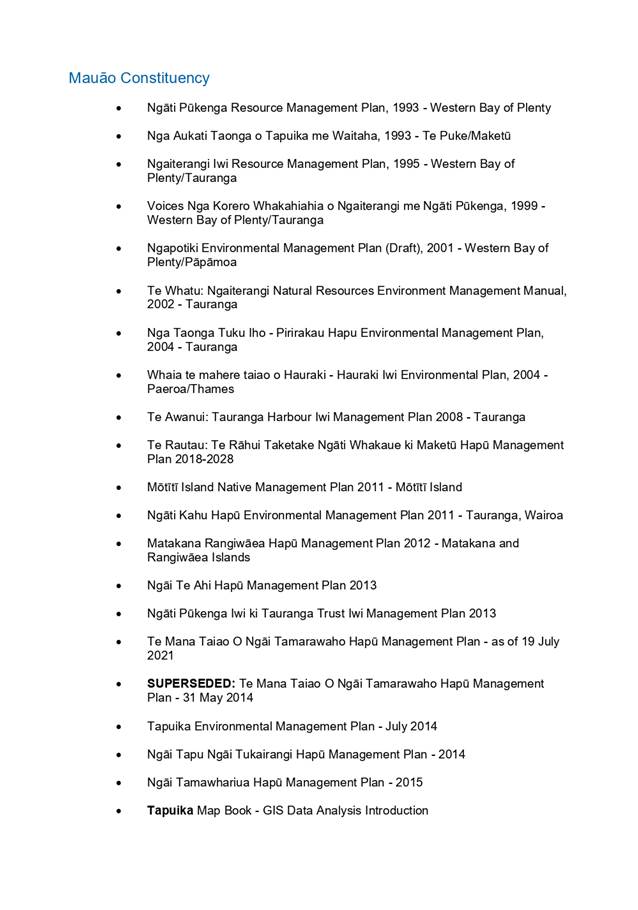
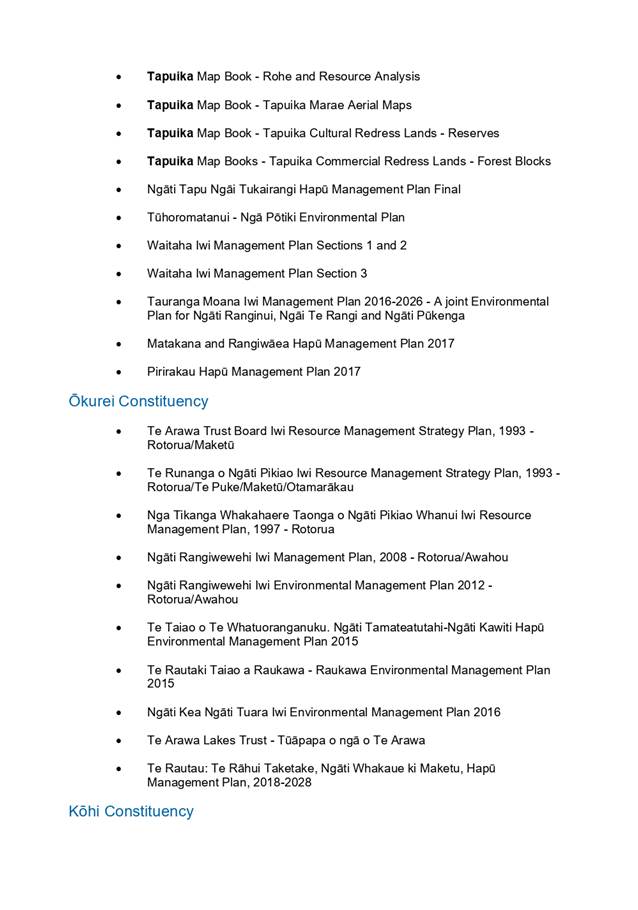
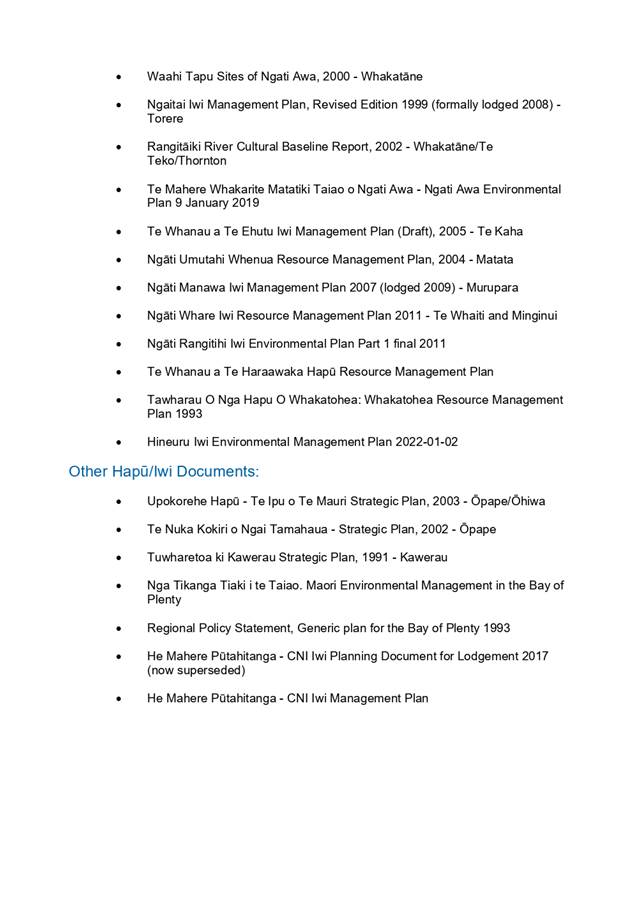
Monitoring and Operations
Committee 6 September 2022

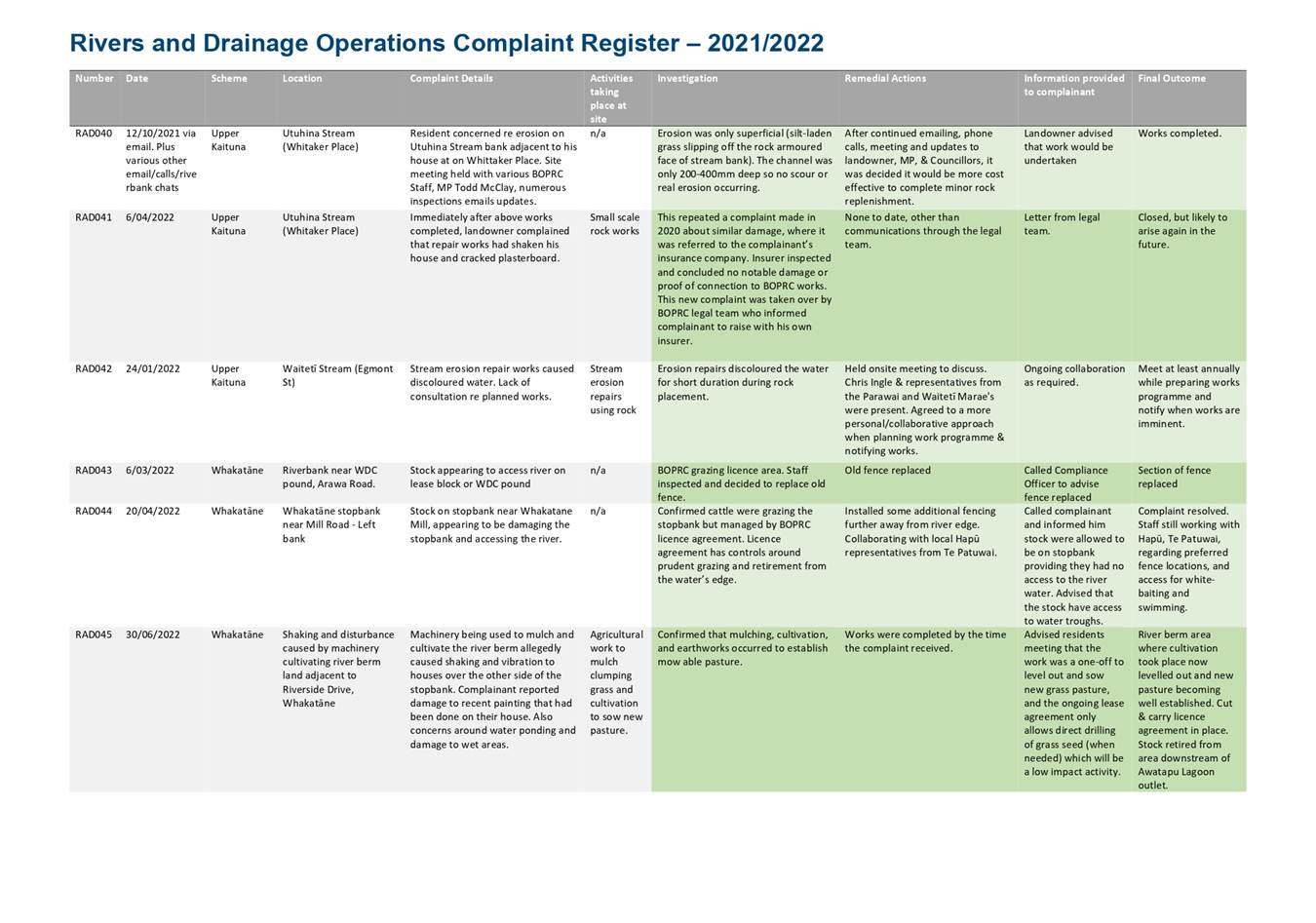
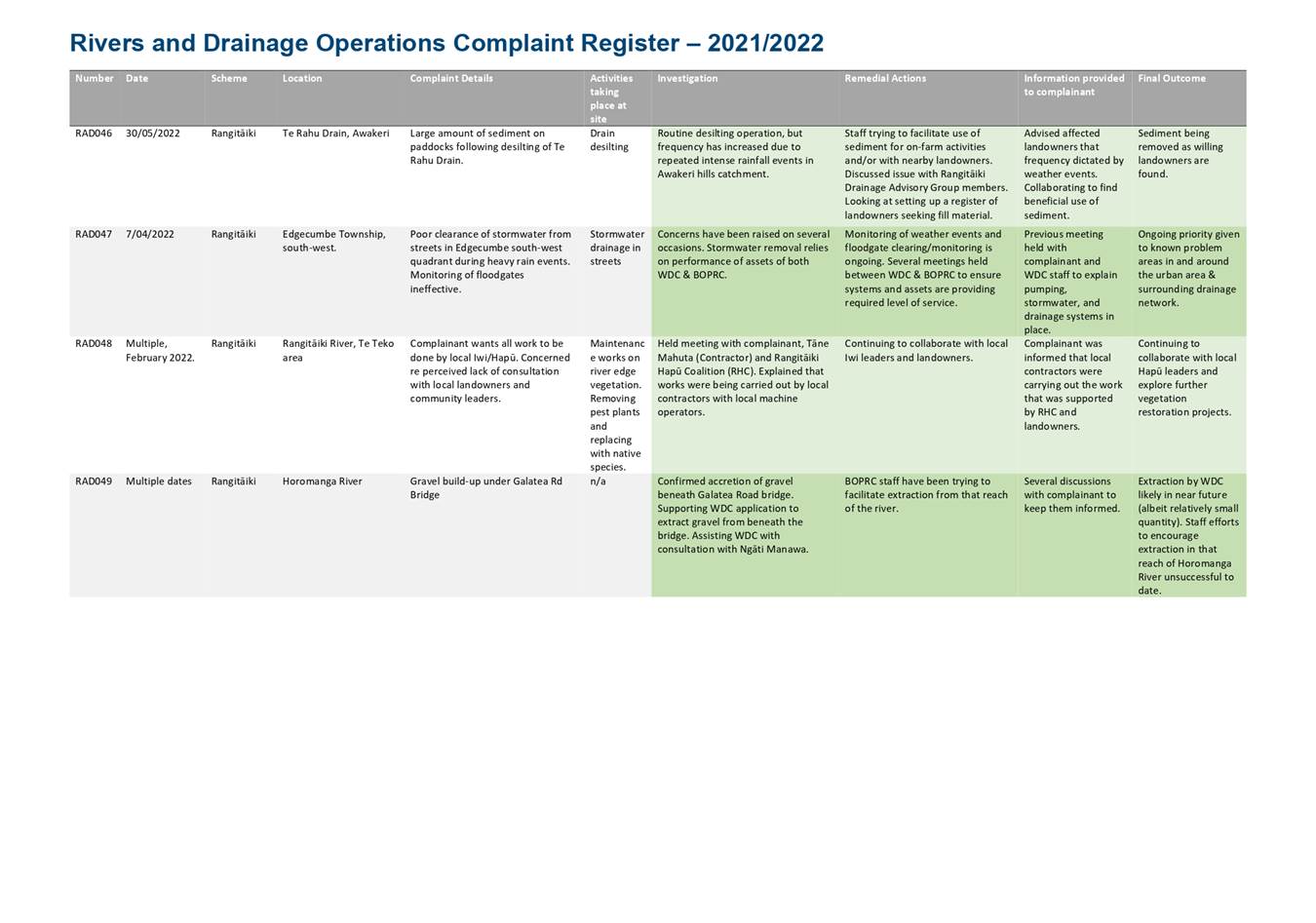
Monitoring and Operations
Committee 6 September 2022
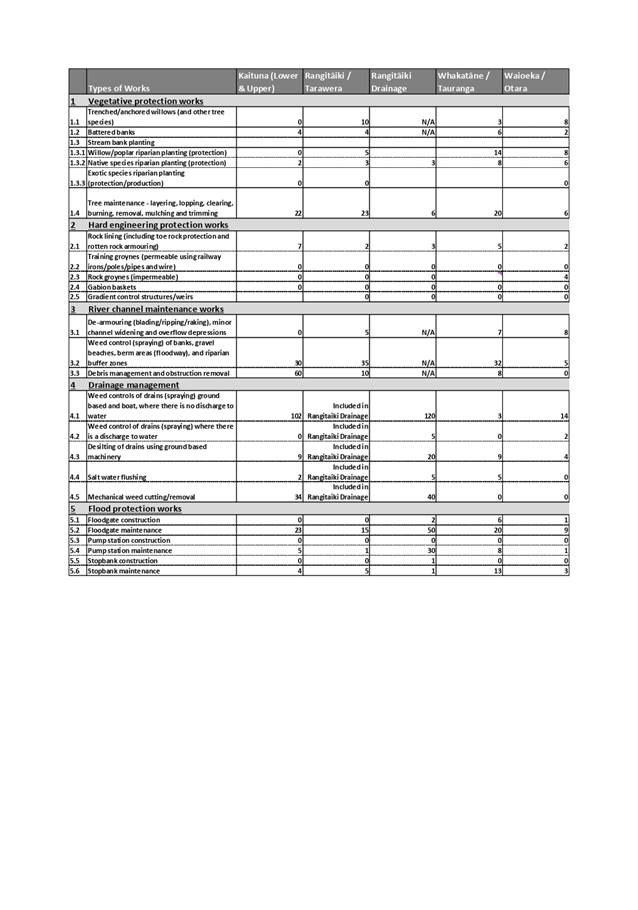
|
|

|
|
|
|
Report To:
|
Monitoring
and Operations Committee
|
|
Meeting
Date:
|
6
September 2022
|
|
Report
Writer:
|
Kirsty Brown, Rivers and Drainage
Assets Manager
|
|
Report
Authoriser:
|
Chris
Ingle, General Manager, Integrated Catchments
|
|
Purpose:
|
The purpose of this report is to provide
an update on implementing the Flood Protection and Drainage Bylaws 2020. An
overview of the Safeguarding our Stopbanks Project is also provided.
|
|
|
|
Implementation
of the Flood Protection and Drainage Bylaws 2020
|
Executive Summary
The Flood Protection and
Drainage Bylaws 2020 regulates and safeguards Council’s flood
protection and drainage assets from damage and misuse.
This report provides an update
on the activities and performance in implementing the Bylaws since its last
review in 2020 and becoming operative 1 February 2021.
This report also includes an
overview of a programme of work referred to as the Safeguarding our Stopbanks
Project, where Council has been working through a process with urban
landowners where structures on their property have encroached on council
owned land. These encroachments are potentially impacting the integrity of
the flood protection asset and restricts Council’s access to maintain
and monitor the asset’s condition and performance.
|
Recommendations
That the Monitoring and Operations Committee:
1 Receives the report, Implementation of the Flood Protection and
Drainage Bylaws 2020.
1. Introduction
The Flood Protection and
Drainage Bylaws 2020 (Bylaws) is Council’s main legislative tool to
protect and safeguard its flood protection and drainage infrastructure assets
from damage and misuse.
This report provides an update
on the activities and performance in implementing the Bylaws since its last
review in 2020 and becoming operative 1 February 2021. An overview of the
Safeguarding our Stopbanks Project is also provided.
1.1 Alignment
with Strategic Framework
|
Safe and Resilient Communities
|
We
support community safety through flood protection and navigation safety.
|
|
A Vibrant Region
|
We
invest appropriately in infrastructure to support sustainable development.
|
|
The Way We Work
|
We
deliver value to our ratepayers and our customers.
|
1.1.1 Community
Well-beings Assessment
|
Dominant Well-Beings Affected
|
|
þ Environmental
Medium
- Positive
|
þ Cultural
High -
Positive
|
þ Social
High -
Positive
|
þ Economic
High -
Positive
|
2. Implementation
of the Flood Protection and Drainage Bylaws 2020
2.1 Background
The Flood Protection and
Drainage Bylaws 2020 regulates and safeguards Council’s flood protection
and drainage assets from damage and misuse. The Local Government Act 2002
(LGA) requires Council to undertake a comprehensive review of its bylaws ten years
after it was last reviewed and within a two-year time frame from that review
date. This is to ensure they are
fit-for-purpose, informed by the latest science and data, and in this case, the
learnings from flood events in the intervening years. The review also took into
account climate change projections, land use changes and increased pressure
from land development.
The
Floodway and Drainage Bylaws 2008 have been operative since mid-2008 and a
formal review of the Bylaws started early in 2019, with adoption by resolution
of Council in December 2020. The 2020 Bylaws became operative on 1
February 2021.
2.1.1 Resourcing
It was identified during the Bylaws review process,
that additional staff resourcing would be required to lead and facilitate the
implementation of the reviewed Bylaws. An FTE position was approved in
the LTP 2021-31. However, successful recruitment for this role took 12
months, with the new Assets Engineer (Bylaws) joining the Rivers and Drainage
Assets team in May this year.
To build capacity and to manage the changes and
increases in Bylaw Authority applications while recruitment was underway, a
secondment role was created to progress the non-technical implementation of the
Bylaws, supported by staff and contractors through the Engineering Panel
contract.
2.1.2 Education
Programme
In line with
the Bylaws education programme, staff have delivered a number of initiatives to
raise awareness and understanding of the Bylaws, making information more
accessible, engaging with applicants to support their application process, and
generally supporting Regional Council’s mahi to safeguard the
region’s flood protection and land drainage assets. These include:
· On-line information query form and pre-application advice process.
This has raised knowledge of the Bylaws and resulted in applications being
received with all the necessary information supplied for assessment.
· A specific webpage to provide information about the Bylaws, where
they can apply, why they are important, landowner responsibilities, and the
process for making a Bylaw Authority application.
· On-line interactive map enabling address searches to check if a
property is within a Bylaw Applicable Area and linking back to the Bylaws
webpage for information about making an application if needed.
· Information flyers including ‘Living next to a stopbank’
and to support the work of the Safeguarding Our Stopbanks Project.
· Creation of several explainer videos to support the work of the
Rivers and Drainage and Engineering Teams and the Bylaws.
· Relationship development with key stakeholders to raise awareness of
the Bylaws e.g. real estate agents, TLAs and engineering companies.
· Bylaws geospatial layer updated with the new 2020 Bylaw Applicable
Areas and shared with Whakatāne District Council to support inclusion in
their Land Information Memorandum (LIM) process. That information now includes
a property map showing the bylaw applicable area and text identifying that the
Bylaws apply and referencing the specific applicable area and distance and
linking to the Bylaws webpage for more information.
· Bylaws information provided to district councils for inclusion in
LIM reports and property files.
2.1.3 Bylaw
Authority Applications and Bylaw Breaches
Under the Bylaws, there are Bylaw Applicable Areas where landowners are
required to obtain Bylaw Authority to carry out particular types of works (e.g.
planting, construction or removal of structures, earthworks) in the vicinity of
scheme assets. The purpose of bylaw authorities is not to restrict
landowners use of the land but to ensure the work is carried out in a manner
that does not inadvertently damage or compromise the integrity and performance
of the asset.
Attachment 1 sets out the different Bylaw Applicable
Areas where Bylaw Authority is required.
The below graph provides an overview of the
pre-application information requests; Bylaw Authority applications received;
and Bylaw breaches investigated from 2018 to August 2022. Increased
awareness of the Bylaws has resulted in a steady rise in activity over the
years. We are also seeing an increase in complex applications e.g.
Te Rāhui Herenga Waka (Whakatāne Boat Harbour) and solar farm
developments.
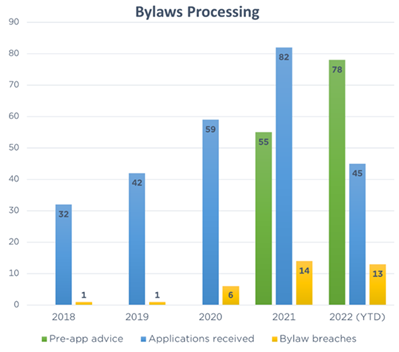
Of the 82 bylaw authority applications received in
2021, 75 were issued, 6 withdrawn and one put on hold. Of the 75 bylaw
authorities issued, 77.6% were processed in line with the internal KPI target
that 75% of applications are issued within 20 working days. For the
year-to-date, 72.7% have been issued within the timeframe.
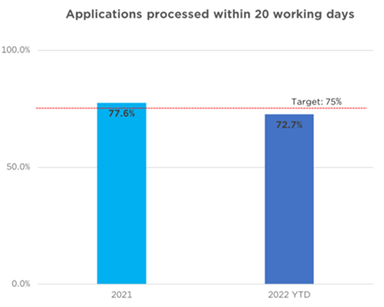
So far in 2022, 13 bylaw breaches have been
investigated and actioned. Most of these breaches have been earthworks without
Bylaw Authority, primarily in urban areas. Where applicable, retrospective
Bylaw Authorities have been issued for works that could be retrofitted to meet
appropriate conditions that would have been required in any issued Bylaw
Authority.
There have also been two incidents of over grazing of
stopbanks in both rural and urban situations which have been resolved.
2.1.4 Bylaw
Authority Management Plans
The 2020 Bylaws, provide for landowners who undertake
activities that could require multiple Bylaws Authority applications to
co-design specific Bylaw Authority Management Plans for those activities. These
activities could include seasonal activities, routine maintenance and emergency
works (e.g. territorial authorities, utilities providers and industry).
The following management plans are currently under
development:
· Fonterra
(Edgecumbe site) - site routine maintenance and emergency works.
· Whakatāne
District Council for Open Spaces – routine works and general maintenance
activities (e.g. tree planting, removal, garden creation, seating, walkways and
fencing).
· Whakatāne
District Council for Roading and 3 Waters – routine works and scheduled maintenance,
emergency works.
2.1.5 Fencing
and Ploughing
The lower reaches of the Kaituna, Rangitāiki and
Tarawera Rivers have layers of pumiceous soils that are susceptible to seepage
and piping failures during flood events. To minimise this risk, additional
clauses have been included in the Bylaws for fencing and ploughing within these
lower reaches, as stipulated in Part II of the Bylaws. Outside of the
areas defined in Part II, ploughing and land cultivation to a depth of 300 mm
is allowed (under the earthworks definition) without the need for Bylaw Authority.
Development and enforcement of ploughing rules was
identified as a programme of work that would be staged over several years. This
would allow time to further develop specific rules and rationales, work with
industry to balance the risk with the practicalities of ploughing as farming
practices, carry out an education programme and finally begin to apply this
part of the bylaw.
In summary, staff’s approach is to:
· Research
ploughing techniques including running through seepage modelling.
· Work with stakeholders and
maize growing contractors to develop best practice guidelines within bylaw applicable areas.
· Identify sites of high
risk where we know that there are seepage issues.
· Develop and manage annual
maize growing through seasonal Bylaw Authority Management Plans.
2.1.6 Iwi/Hapū
Bylaws Authority Management Plans
As part of the Bylaws 2020 review, an investigation
was undertaken on the impact the Bylaws could have on tangata whenua traditional
cultural practices and sites of waahi tapu. As a result, for the first time,
iwi/hapū who exercise traditional cultural practice or manage waahi tapu
in the bylaw applicable areas, may co-design an Iwi/Hapū Bylaw Authority
Management Plan to provide for ongoing management and protection of both
Council’s infrastructure and cultural practices.
Council does not
wish to prevent the undertaking of cultural practices, nor direct tangata
whenua on how to manage waahi tapu areas. The Bylaws include the fundamental
principle that only tangata whenua can identify and evidentially
substantiate their relationship, and that of their culture and traditions, with
their ancestral lands, water, sites, waahi tapu and other taonga.
However, due to the importance of protecting the
integrity of the adjacent council assets, staff are working with iwi and
hapū to co-design Iwi/Hapū Bylaw Authority Management Plans before 1
February 2023 as outlined in clause 12.2.2, when these activities will cease to
be permitted.
Summary of progress to-date
· Based on a prioritised
risk rating, targeted initial engagement has been made with 10 hapū,
inviting the opportunity to co-design Bylaw Authority Management
Plans for marae overlapped by the bylaw applicable areas. This has resulted in
six hapū expressing an interest in further discussion. Further engagement is
planned with the four remaining hapū.
· Hapū have identified
several matters that will likely be addressed through the management plans,
including swimming/bathing sites, access to waterways, erosion management to
protect sites of significance, mahinga kia, and waahi tapu protection.
· Based on the prioritised
risk rating as well as liaison with Te Rūnanga o Ngāti Awa, the lower
Rangitāiki River, in particular the Kōkōhinau urupa (see photo
below) has been identified as the highest priority for the work programme.
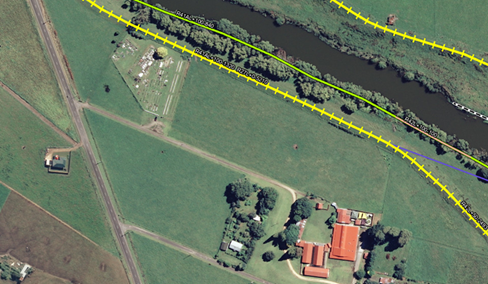
Kōkōhinau marae
and urupa beside the Rangitāiki River and stopbank
· Kōkōhinau
Papakāinga Trust and the Kōkōhinau Marae Committee have
expressed an interest in developing a co-designed management plan for the
urupa. Geotechnical investigation was undertaken in December 2021 and again in
August 2022. Further discussion is planned with the hapū once the
recommendations from the geotechnical analysis are available (September).
· Through engagement with haukainga
of marae in the lower Rangitāiki, the perspectives of tangata whenua have
been articulated. While some of the views are negative towards the Bylaws,
there also appears to be a willingness to explore co-design opportunities. The
concept of a ‘cultural connectivity’ for instance has been
identified, to account for hapū connection with their awa. Further engagement
with hapū is required to explore this further.
· Engagement with
representatives from Waitetī Marae (Ngāti Ngararanui/Ngāti
Tuteati hapū) and Te Kuirau/Utuhina Marae (Te Roro o te Rangi hapū)
commenced in July 2022. Dialogue has been successful in growing a greater
awareness and understanding of the Bylaws, and council staff understanding of
cultural values has also improved. Te Kuirau/Utuhina Marae have notified their
desire to co-design a management plan and this will be progressed over the next
2-3 months. Waitetī Marae is currently considering Council’s
invitation and a response is expected from them in due course.
3. Safeguarding
our Stopbanks Project
3.1.1 Background
Separate from
the Flood Protection and Drainage Bylaws 2020, the Council has been working
through a process with urban landowners where structures on their property have
encroached on council owned land. This is part of the Safeguarding Our
Stopbanks Project.
The Safeguarding
Our Stopbanks Project is a staged work programme to ensure stopbanks and other
Council assets can be accessed and remediated to ensure community flood
protection defences are well maintained. As an example, staff recently worked
with 3 property owners on the Waingaehe Floodway in Rotorua to relocate
encroaching fences onto the legal boundaries, which recovered 6,000 m2
of floodway land, enabled the removal of large problem trees and has improved
maintenance and capacity of the floodway.
In
Whakatāne, the focussed initially was on the encroachments most proximate
to the stopbanks in the urban areas alongside the Whakatāne River. This is
because these areas have been identified as high risk in the asset performance
and condition assessment work undertaken since the April 2017 floods. The
existing defects, including the encroaching trees and structures, are within an
identified “hot spot” warranting priority action. The current stage
of the Project focusses on those encroachments which are on council-owned
public land and which either individually or cumulatively present a risk to the
integrity of the flood protection assets.
In many cases
these encroachments have damaged and continue to impact the flood protection
structure to the extent that remediation of the stopbank is needed to ensure
the integrity of the flood protection system. The encroachments,
including the existing fencing, also prevent Council from having free and
unimpeded access to the landward batter and the crest of the stopbank to
maintain, monitor and control the use and condition of the stopbank. Removal of
encroachments is informed by geotechnical engineering advice and guidance.
Stage one of
the Whakatāne River stopbank work is complete, and stage two is in
progress with physical works planned from October 2022 to March 2023. Stages
three and four cover the Riverside Drive area and are planned for the
subsequent two construction seasons (2023/24 and 2024/25).
The Council is
not relying on the Flood Protection and Drainage Bylaws for this Project.
The encroachments to be removed are located on council land and present a risk
to the integrity of the flood protection assets.
Engagement with
property owners for this project has drawn attention to the provisions of the Bylaws
which many owners have had a very cursory knowledge of. While the project has
provided an opportunity for detailed communications on the Bylaws with residents
it has highlighted a need to improve communications and understanding of the
Bylaws for urban property owners.
The below
aerial photo is an example of adjacent landowner encroachments onto Council
owned land along Henderson Street, Whakatane. The blue line/shading
indicates the resident’s legal title and the yellow line indicates the
crest of the stopbank. This section of the stopbank has now been fully
remediated as part of stage one works.
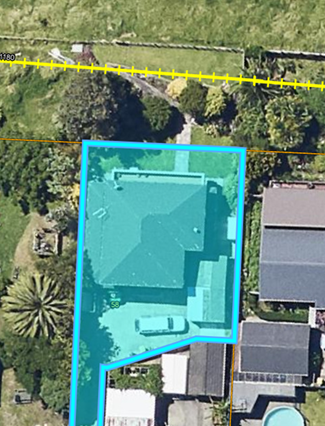
Example of encroachment into stopbank structure and
council land.
3.1.2 Riverside
Drive Residents Group
As a result of communication with
affected property owners regarding the Safeguarding our Stopbank Project, a
number of residents in the Riverside Drive area have formed a group to
represent their collective interests.
One of the key concerns for the group
relates to their ability to undertake activities on their properties and the
perceived effect the Bylaws has on their property values. For most of these
owners their entire property is within the Bylaw
Applicable Area. Although the applicable areas have been there since the Flood
Protection and Drainage Bylaws 2008 took effect, during the 2020 Bylaws review
Area 3 on the Whakatāne River increased from 20m to 40m (see below
diagram).
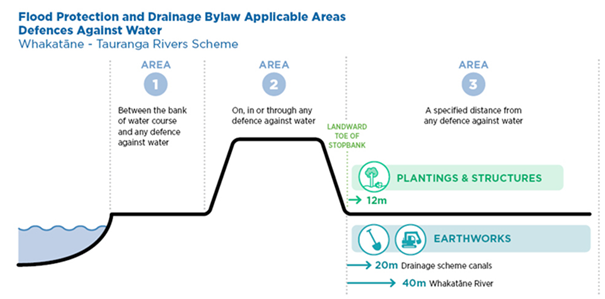
While the consultation on the Bylaws
is considered appropriate, the matters raised by the group have highlighted the
need to improve education throughout the region in urban areas where the Bylaw
applies. Several improvements are planned:
· Development of an urban focused information pack including specific
guidance notes for likely activities being carried out.
· Continued targeted media and social media campaigns including the
development of additional explainer videos specifically on the Bylaws.
· The development of a regular and ongoing communications and
education plan targeting relevant urban areas.
The Bylaw Authority process is not
intended to be a burdensome one. Council has and will continue to work with
landowners to provide for activities to be undertaken in a way that mitigates
risk to the stopbank.
Several of the submissions to the
Bylaw review raised issues similar to those being raised by the group,
including effects on property values. These were considered by the Hearing
Panel as part of their deliberations. The decision, after taking those concerns
into account, was to retain the increased to 40m in Area 3 in line with the
expert’s recommendations.
4. Considerations
4.1 Risks
and Mitigations
Although an inclusive Bylaws
education programme has been undertaken, if the community continues to be
unaware of the Bylaws or understand how they might be affected, there could
potentially be reputation as well as asset failure risks. To mitigate, staff
will continue to develop and undertake education and communication initiatives
around the Bylaws.
4.2 Climate
Change
|
Mitigation
|
Adaptation
|
|
Reduce GHG emissions
|
Produce GHG emissions
|
Sequester carbon
|
Anticipate climate change impacts
|
Respond to climate change impacts
|
|
☐
|
☐
|
☐
|
☒
|
☒
|
Climate change is a significant challenge. The most at-risk
infrastructure for Council is its flood protection and drainage assets, as
changes in weather patterns are resulting in more frequent and intense weather
events, which in turn is affecting the magnitude and frequency of flooding.
These assets are important in mitigating the risk to our communities from the
impacts of climate change and it is crucial they function properly when needed.
The
fundamental purpose of the Flood Protection and Drainage Bylaws 2020 and the Safeguarding
our Stopbanks Project is to protect, maintain and restore the integrity of
Council’s flood protection and drainage assets. The review undertaken for
the 2020 Bylaws considered climate change projections, land use changes and
increased pressure from land development.
4.3 Implications
for Māori
Implications for Māori is
covered in section 2.1.6 of this report.
4.4 Community
Engagement
|

|
INFORM
Whakamōhio
|
To provide affected communities with balanced and
objective information to assist them in understanding the problems,
alternatives and/or solutions.
|
Consultation on
the 2020 Bylaws followed and complied with the obligations required under the
Local Government Act. Staff initially undertook informal consultation
with river scheme advisory groups, territorial authorities, iwi, and the
general public in the form of workshops and open day sessions in the latter
half of 2019. Feedback was generally supportive and was used to further refine
proposed changes.
Formal
consultation was undertaken in March/April 2020. New Zealand went into COVID-19
lockdown on 25 March 2020. Formal consultation was continued after
Council’s decision 24 March. The premise for continuing formal
consultation during lockdown was that if the Bylaws were not reviewed as required
under the LGA, they would be revoked in July 2020.
Public
notification of formal consultation included two sets of letters to all
landowners within the bylaw
applicable areas
across all the rivers and drainage schemes in the Bay of Plenty region, public
advertisements in regional newspapers, on local radio stations and
Council’s website and social media.
Although
awareness of the Bylaws has increased since becoming operational, gaps have
been identified particularly for urban areas where the Bylaws apply, and
improvements can be made. Communication and education will be a priority
for these areas as implementation of the Bylaws continues.
4.5 Financial
Implications
There are no
material unbudgeted financial implications and this fits within the allocated
budget.
5. Next
Steps
Staff will:
· Continue to progress the Bylaws implementation programme focusing on
Bylaws Authority Management Plans for iwi and hapū, TLAs and industry as
well as commencing the fencing and ploughing requirements this financial
year.
· Undertake the improvements planned for the ongoing Bylaws education
and communication programme.
· Continue to work on and engage with residents regarding the
Safeguarding our Stopbanks Project.
Attachments
Attachment 1 - Bylaws Applicable Areas ⇩
Monitoring
and Operations Committee 6 September 2022
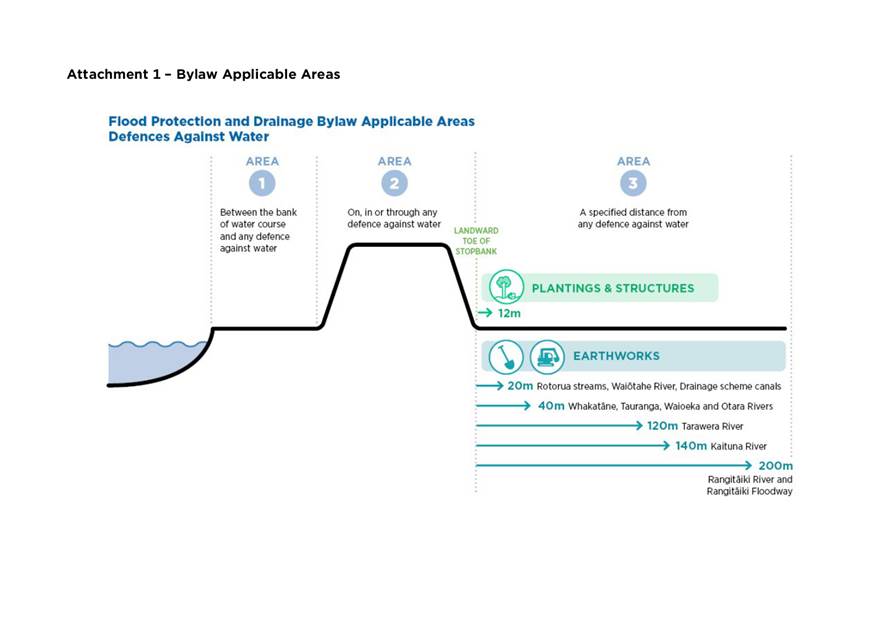
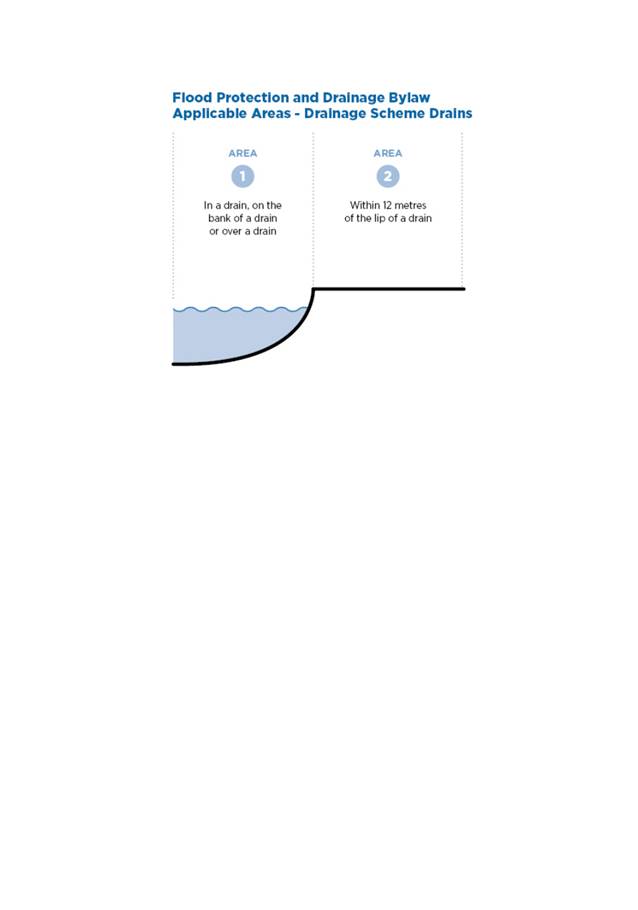
|
|

|
|
|
|
Report To:
|
Monitoring
and Operations Committee
|
|
Meeting
Date:
|
6
September 2022
|
|
Report Writer:
|
Katalin Maltai, Senior Projects
Engineer
|
|
Report
Authoriser:
|
Chris
Ingle, General Manager, Integrated Catchments
|
|
Purpose:
|
To provide an update on the current
status of the River Scheme Sustainability project.
|
|
|
|
River
Scheme Sustainability - Update report
|
Executive Summary
This report provides an update
on the current status of the River Scheme Sustainability project and on the
progress since the last update in November 2020.
In two
catchments, high-level long-term flood mitigation options have been developed
and options are currently being refined. Work has started in a third
catchment (Waioeka-Otara) with a collaborative team and initial workshops.
For the
Rangitāiki-Tarawera catchment the first set of options has been
implemented, and preparation has started for the next steps.
For the
Whakatāne-Tauranga catchment high level investigations continue to
inform the feasibility study and costing work.
Next steps
will be finalising the Whakatāne-Tauranga feasibility study, pricing of
the options and developing high level flood mitigation options for the
Waioeka-Otara.
|
Recommendations
That the Monitoring and Operations Committee:
1 Receives the report, River Scheme Sustainability - Update
report.
1. Introduction
The River Scheme Sustainability
(RSS) project investigates alternative flood management options when considering
that, due to climate change, increasingly costly upgrades to our flood
protection schemes are likely to become necessary over coming decades.
It is not sustainable to build
increasingly higher stopbanks in our river schemes and alternative approaches
need to be considered, including upper catchment works where possible. The
project also seeks to balance the current level of service with escalating
scheme funding requirements over time.
The project findings are being
built into the Infrastructure Strategy and Rivers and Drainage Asset Management
Plan. Budget for the work is included in the Regional Flood Risk Coordination
Activity.
1.1 Alignment with Strategic
Framework
|
Safe and Resilient Communities
|
We
provide systems and information to increase understanding of natural hazard
risks and climate change impacts.
|
The River
Scheme Sustainability project seeks to future proof the council’s
river schemes against the impact of climate change, ensuring that levels of
service continue into the future provided that is affordable for the benefiting
communities.
1.1.1 Community Well-beings Assessment
|
Dominant Well-Beings Affected
|
|
þ Environmental
|
¨ Cultural
|
þ Social
|
þ Economic
|
2. RSS Project Update
2.1 Project Phases
2.1.1 Project Phase 1 and 2 Complete
The River Scheme Sustainability
Project consists of 4 Phases and the first two phases have been completed. In
the phase 1 the Philosophy and Vision of the project was developed.
The vision is to have a 100 year Sustainable River
Management Strategy which achieves:
1. Reduction in flood risk
in the Bay of Plenty
2. Environmentally and
economically sustainable land use practices
3. Adaptability to climate
change
4. Community stakeholders
support and engagement
5. Affordability
During Phase 2, investigations
were undertaken into factors that are affecting the schemes and establish the
foundations of the project. Four initial workstreams (Economic Analysis, Flood
Gap Analysis, Rating Assessment and Communications) were established then 3
further workstreams were added (Optioneering, Climate Effects and Ownership
& Governance). The findings of these 7 workstreams provides the basis of
the current Stage 3 assessment.
2.1.2 Project Phase 3
The Optioneering workstream
during Phase 2 developed a toolbox that contains 33 possible flood mitigation
solutions (both structural and non-structural). During Phase 3 the effects of
climate change on each catchment is assessed and tested against the possible
options and their combinations.
These options are further
assessed during the feasibility stage of the project and high level costs
developed which enables us to carry out an affordability assessment.
2.2 Climate Change Resilience
Rangitāiki-Tarawera Catchment
The strategy agreed with the
Community for the Rangitāiki Catchment was to upgrade the downstream
capacity of the stopbank infrastructure to convey a 1% Annual Exceedance
Probability (AEP) flood event (100 year flood). This was based on the 2016 1%
AEP of 804m3/s flood flow.
The key to the downstream
capacity upgrade is the Rangitāiki Floodway upgrade. The floodway’s
stopbank infrastructure upgrade is now complete and the last task is
constructing the new spillway, scheduled for this financial year. Once this has
been completed the only work needed in the future is to maintain the current
capacity of the floodway stopbanks. This work addresses any stopbank settlement
and sea level rise effects in the lower Rangitāiki River.
For approximately the next 30
years, subsequent increases in the 1% AEP flow estimate, due to climate change
and refinement, would be taken up by utilising storage within the Matahina and
Aniwhenua Dams. Three options were identified for future effects of climate
change beyond 30 years. Utilising the Matahina Dam for storage is part of the
Lake Matahina Flood Management Plan so this arrangement is already in place and
is functioning well.
An initial meeting has been held
with Southern Generation regarding utilising the Aniwhenua Dam for flood
storage. The plan is to utilise a similar arrangement to the Matahina Dam.
Council’s engineers have commenced an assessment to model the Aniwhenua
Dam to best utilise available storage during a flood event.
2.2.1 Preliminary Saltwater Intrusion
Investigation
The land in low-lying coastal
parts of the Rangitāiki River Catchment is in agricultural use. The
groundwater is very shallow, controlled and is in the Rangitāiki Drainage
Scheme. Due to sea level rise, coastal groundwater levels are predicted to
rise; which could lead to challenges in sustaining current agricultural
practices and land drainage. This may result in the need for alternative
farming methods or even retreating from the area.
These changes could have a
significant effect on the operation and funding of Council’s drainage and
river schemes therefore gaining better understanding of these processes is
essential when planning for the future.
The questions to be addressed
include the following:
· Identifying
the relationship between sea-level rise and groundwater levels in the lower
Rangitāiki Floodplain (in particular, saltwater intrusion).
· Determining
the effect the Rangitāiki Drainage Scheme has on groundwater levels now
and into the climate change-affected future.
· Investigating
peat shrinkage and the effect increased pumping has on ground levels.
· Investigating
possible solutions to delay the effects of saline intrusion and peat shrinkage.
· Investigating
alternative land uses that would be sustainable in locations where saline
intrusion and peat shrinkage occur.
· Determining
when these alternative land uses would be economically better than dairy
farming in terms of farming profit.
Prior to being able to answer
these questions we need a better understanding of the shallow groundwater
system in the lower Rangitāiki catchment. The preliminary study included
investigating the current state of saltwater intrusion, identifying knowledge
gaps and developing a field investigation and monitoring programme to be able
to assess the full extent of the saltwater intrusion. This information will
form the basis of the assessment into the future.
The results of the May 2021 salinity survey in
surface waters across the coastal part of the Rangitāiki River Catchment
suggest a large-scale impact of saltwater intrusion in shallow groundwater and
surface water in that area. While salinity measurements were carried out from a
limited number of locations, a zone affected by saline water can clearly be
distinguished. High salinity measurements have been recorded in the land drains
near Bennett Road which indicates that the shallow groundwater system has
become fully saline beneath this area.
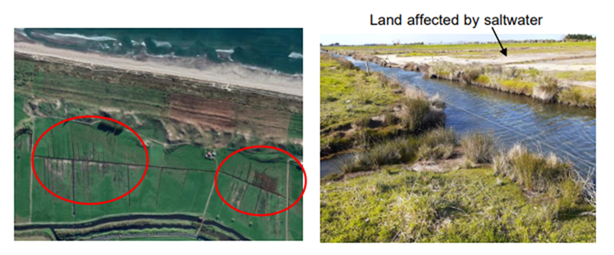
Figure 1: Area north of the
Old Rangitāiki River Channel affected by saltwater.
Left Photo: Affected paddock near
Bennett Rd. Right Photo: Taken near Bennett Rd
Saltwater intrusion will possibly progress further inland
due to effects of climate change and further increase the salinity of the
shallow groundwater and surface water.
There is limited monitoring data
available on the current state of saltwater intrusion and the ongoing processes
in the area. The next stage of the project is to extend the monitoring network.
This is needed to gain a better understanding of the relationship between
shallow groundwater and surface water.
As part of the Whakatāne
Coastal Review project we are planning development of a shallow groundwater
monitoring network in the lower Rangitāiki and Whakatāne catchments.

Figure 2 Indicative schematic
North-South cross section of saltwater intrusion near Bennett Road.
2.3 Climate Change Resilience
Whakatāne -Tauranga Catchment
2.3.1 Whakatāne-Tauranga optioneering
Following
initial assessments during which 33 different types of options were assessed
for the Whakatane River, a number of promising options were identified. A map
showing the location of these options was presented at the Monitoring and
Operations Committee on 15 September 2020.
The next step was to develop
high level costings for each of the options.
Currently we are in a process of
developing hydrodynamic models for some of the options while our survey team
has completed the first stage of the floor level survey. The modelling will
enable us to finalise the basic design which is required for the costing.
2.3.2 Iwi and District Council engagement
Initial
high-level discussions have taken place with Ngāti Awa and Whakatāne
District Council.
Facilitated by our Engagement
Team, Tūhoe has been approached a number of times with the aim of starting
discussions concerning both the immediate maintenance needs and the long-term
future of flood mitigation in the Whakatāne-Tauranga river catchment. An initial
meeting was held on the 19 May 2022 where the main points of discussions
included:
· shared
responsibility around the health of the river
· how
Tūhoe can be involved with undertaking the work itself.
· How to
involve individual hapū in different parts of the river.
We are working towards
culturally accepted and supported long term flood mitigation options and prefer
to continue the discussions with Tuhoe before engaging with other groups.
2.4 Climate Change Resilience
Waioeka-Otara Catchment
In the last two years, catchment
specific foundation work was carried out to enable the River
Scheme Sustainability investigations. This included:
· Building
and calibrating the Waioeka-Otara model which is now ready for assessing
alternative flood management options.
· Geotech
investigations carried out at different parts of the stopbanks of both rivers
to identify any weaknesses.
A collaborative project team has
been set up that includes representatives from Ōpōtiki District
Council, Whakatōhea Iwi, Ngāti Ngahere Hapū and Ngāti Ira
Hapū.
A first introductory workshop
was held in June 2022, at which the basis of the project was established. This
was followed by a second workshop in August at which the team was involved in
identifying possible flood mitigation options. The intention is to then assess
these options, utilising the Waioeka-Otara model.
2.5 Climate Change Resilience
Kaituna Catchment
While Phase 3 of the Kaituna
Catchment hasn’t officially been started yet, there are a few related
projects in this catchment that have. These will be incorporated into the wider
study in due course.
2.5.1 Te Puke Stormwater Project
Te Puke
township is the second biggest residential area in the Kaituna Catchment.
Significant development has occurred since the development of the river scheme
and more is planned for the future. We are working alongside staff at the
Western Bay of Plenty District Council to manage the potential increases in
stormwater runoff from the township.
A collaborative project team was set up to gain a
better understanding of:
· the
impact of development in Te Puke over the last 20 years;
· the
effectiveness of the Kaituna flood scheme, built pre 1999;
· possible
stormwater and flood mitigation options.
A detailed hydraulic model was built
for the catchment to carry out these assessments and to enable Council to
assess current levels of service.
The model was further developed
by analysing different climate change scenarios, which now provide the basis
for the next stage of the project. Flood mitigation options are going to be
assessed collaboratively between WBoPDC and BOPRC. This stage of the project is
currently being established.
2.5.2 Bell Rd Climate Change Assessment
The Bell Road catchment is
located adjacent to the Pāpāmoa East development area. During high
river levels, drainage flows are pumped into the Kaituna River
A hydraulic
model of the Bell Road drainage system and catchment has been developed and
used to simulate future climate scenarios. The final model has been completed
to assess future flood mitigation options using RSS principles. A consultant is
to be engaged to undertake this work.
2.5.3 NIWA – Future Coasts Aotearoa
Council has a
close working relationship with NIWA scientists, who have approached our staff
to take part in the MBIE Endeavour Programme ‘Future Coasts
Aotearoa’ project. The goal of the project is:
1. Build a national database and interactive web-based maps of coastal
wetlands, land-use and asset exposure in coastal lowlands with relative sea
level rise.
2. Produce a high-resolution, time-evolving, online mapping tool of the
freshwater-saltwater interface.
3. Science advances will be required to understand ecosystem response
and habitat evolution, and to identify adaptation tipping-points and
opportunities for wetland preservation or re-establishment.
BOPRC and NIWA are in discussions around using the
Kaituna Plains as a pilot study area for the assessment which will feed into
the RSS project.
3. Considerations
3.1 Risks and Mitigations
Linkages into other Council
Documents and Plans
The RSS project findings inform
the planning for our Rivers and Drainage Assets. This work informs the
Council’s Infrastructure Strategy and the Rivers and Drainage Asset
Management Plan. Both documents are updated on a three-yearly cycle, in
conjunction with the LTP.
The RSS project is reflected
strongly in both of these documents and as the RSS workstreams develop they
will have an increasing influence on what assets are developed and whether some
assets may need to be phased out.
3.2 Climate Change
The aim of this
project is to develop long term Flood Plain Management strategies while
allowing for the effects of climate change.
In early August
2022 new interim guidance (Use of New Sea Level Rise Projections)
has been released by Ministry for Environment, which is
an update of the 2017 Guidance for Local Government on Coastal Hazards and
Climate Change used by the RSS project. The new document is an initial update
until the release of the new guidance which is due in 2023.
We are aligned
with the projections presented in the initial guidance, with slightly lower
(5-10mm) values used for future sea level rise. At this point due to the
uncertainty around these values and the long-term nature of the project, we did
not update the climate change projection values used in the RSS project. This
decision will be revisited when the next guidance document is released in 2023.
3.3 Implications for Māori
The aim of the
project to deliver culturally acceptable and supported long term options for
flood mitigation. Early engagement with relevant iwi and hapū is a vital
part of this work, and is being given a high priority.
3.4 Community Engagement
During Phase 3 of the RSS
project, community engagement is key. Community engagement has either been
undertaken (Rangitāiki), is underway (Whakatāne, Waioeka Otara) or is
intended (Kaituna).
3.5 Financial Implications
Future work on
the River Scheme Sustainability Project is provided for in Council’s Long
Term Plan 2021-2031 within the Regional Flood Risk Coordination activity.
There are no
material unbudgeted financial implications and this fits within the allocated
budget.
4. Next Steps
The next stage of the
project in year 2022/2023:
Whakatāne-Tauranga
catchment:
·
Complete the feasibility assessment and costing
of the proposed options;
·
Iwi and public consultation.
Rangitāiki-Tarawera
catchment:
· Continue
discussion about utilising Aniwhenua Dam for flood management;
· Establish
a shallow groundwater monitoring network in the Lower Rangitāiki and
Whakatāne catchments, through a collaborative approach with Whakatāne
District Council.
Waioeka-Otara
catchment:
· Complete
initial first stage optioneering work for the catchment.


 RMA s360
stock exclusion regulation timeframes are now less than a year out, with dairy
cattle required to be excluded from rivers wider than 1m on all slopes of land
by 1 July 2023. Stock exclusion is also required from wetlands identified
in regional and district plans by the same date. Funding support is available
from the Land Management team for new fencing works that go above and beyond
the requirements of regulations in priority Focus Catchment areas.
RMA s360
stock exclusion regulation timeframes are now less than a year out, with dairy
cattle required to be excluded from rivers wider than 1m on all slopes of land
by 1 July 2023. Stock exclusion is also required from wetlands identified
in regional and district plans by the same date. Funding support is available
from the Land Management team for new fencing works that go above and beyond
the requirements of regulations in priority Focus Catchment areas. 











































































































































